
Home » Travel Guides » Germany » 15 Best Things to Do in Erfurt (Germany)

15 Best Things to Do in Erfurt (Germany)
A city with more than 1,200 years of history, Erfurt is the capital of the Free State of Thuringia and has one of Germany’s most complete Medieval centres.
Here, St Mary’s Cathedral shines for its Romanesque and Gothic art, and the Krämerbrücke is a bridge traced by quaint timber-framed merchants’ houses.
It was in Erfurt that Martin Luther became a monk at the Augustinian Monastery, and at the end of the 18th century the city was at the forefront of the Enlightenment, frequented by cultural heavyweights like Goethe, Schiller and Wilhelm von Humboldt.
One of Europe’s oldest intact synagogues is also in Erfurt, along with a complete Baroque fortress, charming squares and moving memorials to the days of the GDR and Holocaust.
Let’s have a look at the best things to do in Erfurt :
1. Krämerbrücke (Merchants’ Bridge)

An enchanting slice of Medieval history, the Krämerbrücke is a bridge lined with half-timbered houses crossing a branch of the River Gera.
At 79 metres, it’s the longest Medieval bridge in Europe to have inhabited houses.
These quaint old merchants’ houses are now galleries, cafes, antiques shops, ateliers, wine merchants, delicatessens and boutiques, while the upper floors are apartments.
The first mention of the bridge is from the 1100s, and following seven different fires in the 12th and 13th centuries it was rebuilt with limestone and sandstone in 1325. This crossing was part of Europe’s medieval trade network, the Via Regia, which accounts for its long association with merchants.
2. Erfurt Cathedral
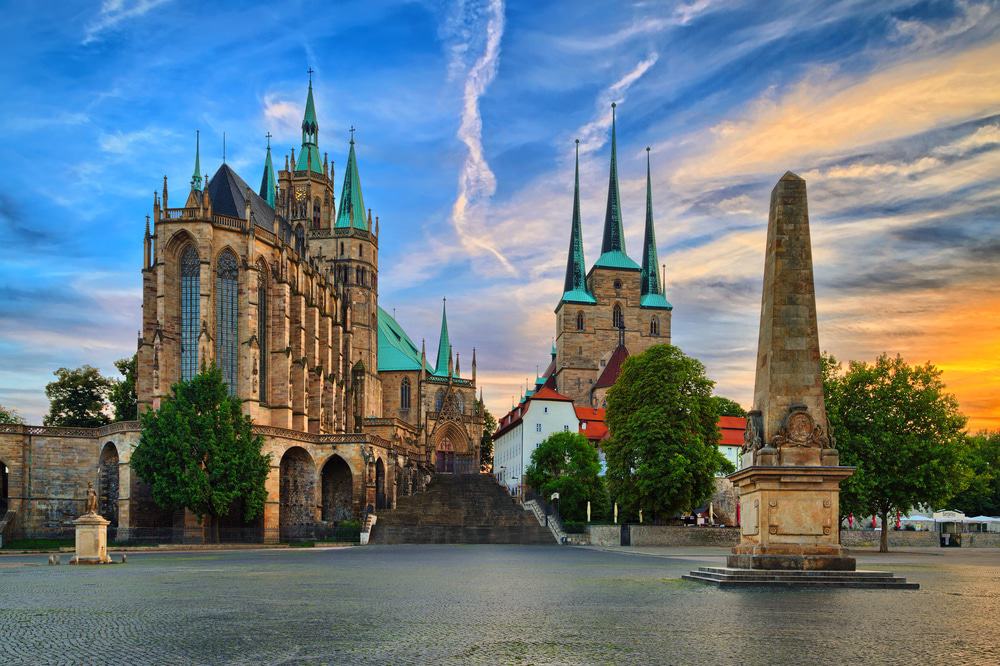
On the brow of a hill stands Erfurt’s magnificent Gothic cathedral, built mostly during the 1300s and 1400s.
There has been a religious building in this place since 742 when St Boniface founded a church.
The cathedral is unbelievably rich with Medieval art, starting with the 18-metre tracery windows in the high choir, which are almost all original and were fitted between 1370 and 1420. The oak stalls in the choir are also exceptional, carved in the 1360s, and with 89 seats in twin 17.5-metre rows.
There’s a stucco retable depicting the Virgin and Child from 1160 and the astonishing Wolfram candelabra from dating to around the same time.
The cathedral’s middle tower also holds the Maria Gloriosa, the world’s largest free-swinging Medieval bell, cast in 1497 and weighing 11.45 tons.
3. Domplatz

The largest square in the city is the grand 3.5-hectare plaza below the cathedral.
In the morning from Monday to Saturday there’s a market selling fruit and vegetables, sausages, eggs, honey, cheese and exotic delicacies: The square’s market tradition could be as old as the 8th or 9th century.
Domplatz is also the main location for Erfurt’s excellent Christmas market in December.
There are also a couple monuments catching the eye: The Erthal-Obelisk went up in 1777 to commemorate the first visit by the new Archbishop-Elector Friedrich Karl Joseph von Erthal and was mostly funded by Erfurt’s citizens.
Crowned with a statue of the Roman Goddess, the Minervabrunnen from 1784 is Erfurt’s oldest surviving fountain and the last of the city’s original 55 public drinking fountains.
4. Zitadelle Petersberg

Taking up 12 hectares right on the Petersberg hill in the centre of Erfurt is the largest and best preserved Baroque city fortress in Central Europe.
There are eight bastions, linked by a two-kilometre parapet wall which reaches heights of 23 metres and has wonderful vistas of the city.
Under these walls are counter mines, a system of tunnels to prevent mines made by attackers during sieges: You can go underground to see them on tours organised by the tourist office.
The citadel was founded in 1665 by the Archbishop-Elector of Mainz and was later used by the Prussian Empire.
After Reunification the site was turned into a tourist attraction, while its buildings belong to government offices, cultural amenities and private apartments.
5. Augustinerkloster

A prime stop on Germany’s Luther trail, this Augustinian monastery is where Martin Luther became a monk and stayed between 1505 and 1511. Luther returned many times, including in 1521 when he gave a sermon here against the theology of the Catholic church.
You can visit a reconstruction of Luther’s cell and find out more about his relationship with Erfurt at the monastery’s exhibition.
The complex itself dates to the end of the 13th century, and much of the architecture was completed in the first decades of the 14th century.
6. Fischmarkt

West of Krämerbrücke is Fischmarkt, which was the social centre of the city in the Middle Ages.
The first town hall was built here in 1275 and its current Neo-Gothic building from 1875 is on the exact same plot.
Poke your head inside to see the fabulous murals recording moments from Thuringian history and scenes from the life of Martin Luther.
In front is the Römer, a monument from 1591 of a Roman soldier holding the city’s flag in his right hand.
On the borders of the square are a number of gorgeous Renaissance houses built by Erfurt’s prosperous Burghers: On the north side Haus zum Breiten Herd has a sumptuous polychrome facade designed by the Brabantic master Frans Floris, while on the west side you can’t ignore Haus zum Roten Ochsen, which has a frieze on the ground floor depicting the muses.

Once dominated by a fortress, this 265-metre hill to the southwest of Erfurt became a public park in the 1880s and has been expanded since then.
In the time of the GDR the garden was developed for the International Gardening Exhibition in 1961. The architecture and landscaping for the project by Reinhold Lingner is celebrated today, and since Reunification the park has been turned into one of Germany’s favourite horticultural attractions.
The largest ornamental flowerbed in the country is here, boasting 150,000 flowers in spring.
There’s also a rose garden with 450 different varieties, as well as a Japanese garden and greenhouses for butterflies, cactuses, tropical flora and 300 species of orchids.
There are also two towers surviving from the fortress, dating to the 16th century, and one of these has a viewing platform 21 metres above the park.
8. Old Synagogue

Going back as far as the 1000s, Erfurt’s Old Synagogue could be the best preserved Medieval synagogue in Europe.
Most of the architecture is from the 13th century, but its history as a place of worship ends abruptly in 1349 when Erfurt’s Jewish community was massacred and expelled from the city.
From that time on it was used as a warehouse.
And because its history had been forgotten by the 20th century this vital piece of Jewish heritage was left untouched during the Nazi regime.
In 2009 the Old Synagogue opened as a museum, enriched with artefacts found around Erfurt during excavations.
There’s a 13th-century Mikveh (ritual bath), facsimiles of Medieval religious manuscripts, as well as the Erfurt Treasure.
This hoard of coins, ingots and jewellery was discovered in the wall of a Medieval house in 1998 and is believed to date from the time of the massacre.
9. Angermuseum

Erfurt’s art museum is in one of the city’s most beautiful buildings, a Baroque early 18th-century facility for packing and weighing at the central Anger square.
The museum has an extensive reserve of fine arts and applied arts from the Middle Ages to the present day.
Seek out the sacred art from the second half of the 14th century, most of all the sandstone sculptures and four panels from the altar at the Augustinerkloster.
There are also later Renaissance altar paintings believed to have been produced by Lucas Cranach the Elder or his workshop.
Also make time for Erich Heckel’s stunning Expressionist mural, and the porcelain collection, presenting Thuringian figurines, tableware, sculptures and reliefs from the 1700s to the 1900s.
10. Wenigemarkt

At the eastern end of the Krämerbrücke is another cute square, which has roughly the same proportions as Fischmarkt on the opposite bank of the Gera.
The Ägidienkirche on the north side of the square is the eastern bridgehead for the Krämerbrücke and in its current form dates to around the 16th century.
In good weather the square is taken up by bar and restaurant seating, and at Christmas Wenigemarkt becomes a small village of stalls illuminated by fairy lights.
On the southeast side of the square is a fountain, Raufende Knaben (scuffling boys) designed by Madeburg sculptor Heinrich Apel in the mid-1970s.
11. Predigerkirche

If you still have an appetite for religious architecture the Predigerkirche (Preacher’s Church) will keep you fascinated for an hour or so.
This former monastery church was founded in the 1200s and upgraded in the Late Gothic style in the 1300s and 1400s.
In 1989 the Predigerkirche was Erfurt’s meeting place for protesters during the Peaceful Revolution: In October of that year one New Forum meeting in the church drew up to 4,000 participants.
Allow some time to view the many ledger stones members of Erfurt’s noble families, unearthed during restoration works in the 1960s and dating to between the 1300s and 1700s.
An interesting piece of trivia is that Johannes Bach, great uncle of composer Johann Sebastian Bach, was organist at the Predigerkirche from 1636-1673.
12. Erinnerungsort Topf & Söhne

The company J. A. Topf und Söhne became insolvent in 1994, and in 2011 this memorial was opened at its headquarters.
During the war the company had supplied the ovens and ventilation equipment for the gas chambers at Auschwitz.
In that sense this site is unique, because it is the only place where the complicity of private companies in the Holocaust has been remembered.
There’s an exhibition on the top floor of the building and this has some interesting items like telegrams showing direct communication with SS officials and documents confirming orders and delivery of the equipment.
Special attention is paid to the experience of Sonderkommandos, the work units made up of prisoners at death camps.
On the level below is a conference room where videos are shown and where people can exchange their thoughts about the memorial.
13. Gedenk- und Bildungsstätte Andreasstraße

On Andreasstraße there’s a former detention centre run by the Stasi in the days of the GDR. More than 5,000 political opponents were imprisoned here.
In December 2013 an exhibition established here on three floors, with restored prison cells, archive photos and video in which firsthand witnesses give accounts of the detention centre as well as the events of 4 December 1989. On that day protesters occupied the Stasi’s Erfurt district administration on Andreasstraße, and it was a symbolic moment as it was the first time that a Stasi facility had been taken over during the Peaceful Revolution.
14. Thüringer Zoopark Erfurt

Always an option if you’re travelling to Erfurt with kids, Erfurt’s zoo has almost 350 different animal species and prides itself in its big African mammals.
There are lions, giraffes and white rhinoceroses, while in 2014 the zoo opened a massive new habitat for African elephants.
You can observe them indoors and outside, in an environment landscaped with rocks and pools.
Another expansive habitat is Afrika-Savanne, where zebras, ostriches, impalas and antelopes occupy the same enclosure.
There are also a variety of monkeys, reptiles, kangaroos, emus, an open space for bison and two farm areas for sheep, goats, pigs, donkeys and horses.
Of the total 63 hectares, 15 are reserved for lawns and woodland, so it’s easy to find a quiet spot for a picnic.
15. Thüringer Bratwurst

The local sausage in Erfurt has Protected Geographical Indication (PGI) under EU Law.
A Thüringer Bratwurst is thin, up to 20 centimetres long, and has a famously spicy flavour.
The blend of pork and beef is seasoned with garlic, pepper, marjoram, caraway, and occasionally coriander and nutmeg.
By law, more than half of the sausage’s ingredients must have been produced in Thuringia.
The sausage will be cooked over charcoal and served in a round roll so that the ends of the sausage poke out from each side.
The condiment of choice in Erfurt is mustard by the local Born brand, which has been in business for almost 200 years.
15 Best Things to Do in Erfurt (Germany):
- Krämerbrücke (Merchants' Bridge)
- Erfurt Cathedral
- Zitadelle Petersberg
- Augustinerkloster
- Old Synagogue
- Angermuseum
- Wenigemarkt
- Predigerkirche
- Erinnerungsort Topf & Söhne
- Gedenk- und Bildungsstätte Andreasstraße
- Thüringer Zoopark Erfurt
- Thüringer Bratwurst
Privacy settings
Here you will find an overview of the types of cookies used on the website. You can set your consent for each category individually. Further information can be found in the privacy policy .
- Essential Cookies For the use of the website with all functions (e.g. user settings, watch lists, etc.)
- Statistics Statistics Cookies collect information anonymously. This information helps us to understand how our visitors use our website.
- Marketing In order to provide you with the best possible offer in cooperation with our partners, we use marketing tools. For example, in order to use our chatbot, you must activate this setting.
- External contents Required for viewing external media and third-party content. The provider may set cookies for its part. The respective data protection regulations of the provider apply.
- Inspiring Germany
Cities & Culture
- Nature & Outdoor Activities
- Royal Palaces & Castles
- Experience & Enjoy
- Current highlights
- Sustainable travel
- Barrier-free travel
- Easy language
- Federal states
Erfurt: where beauty meets confidence
Erfurt wows visitors with its Medieval charm and rich history combined with a lust for life and a warm welcome. Situated at the crossroads of ancient trade routes, the capital of Thuringia has always been a meeting place and home of important intellectuals and a magnet for visitors from around the world.
Erfurt was once lauded as the City of Towers in reference to the lofty spires of the city's 25 parish churches, 15 abbeys and monasteries and ten chapels that stretch their way up to the heavens. Particularly striking are St. Mary's Cathedral and the Church of St. Severus, as together these two masterful examples of German Gothic design form an architectural ensemble like no other in Europe. Nowadays, the church towers cast their shadows over the lovingly restored timbered-framed houses and beautiful Renaissance buildings of the historical city centre, where one of Germany's finest open-air theatre events, the Cathedral Steps Festival, takes place every year.
Cathedral of St. Mary
Krämerbrücke (merchants’ bridge ), petersberg citadel, monastery of st. augustine.
St. Augustine's Monastery, where Martin Luther spent five years of his life, the Predigerkirche church and the fortifications of Petersberg Citadel are superb examples of Medieval and modern-era architecture. But far from being just a city of sacred buildings, Erfurt is also a city of bridges, the most famous of which is the Merchants' Bridge, which has the longest row of inhabited buildings on any bridge in Europe. Buildings that are now home to art galleries, wine bars and antique dealers. And boy does Erfurt know how to party! The Middle Ages are revived every summer during the Merchants' Bridge Festival in the Old Town, a celebration involving ancient crafts, courtly love songs, jesters and a colourful array of stalls. If that's not enough for you, the superb markets held all-year round transform the Domplatz square into a feast for the senses.
Discover more
Excellent hiking experiences in quality regions, top sights and activities in germany, technology museums: fascination with technology, "historic highlights of germany", wine experiences from the ahr to württemberg, spa towns: a spa trip is a must, explore the surroundings.

15 Top-Rated Attractions & Places to Visit in Erfurt
Written by Bryan Dearsley Updated Dec 27, 2023
Erfurt, the capital of Thuringia, is an old university city with a rich history that dates back more than 1,200 years. Once the meeting place of church Synods and Imperial Diets, it was here that the Congress of Erfurt took place in 1808 when Napoleon met with the Tsar of Russia and the German Princes in an attempt to reaffirm old alliances.
As well as being an important center for agriculture and gardening, Erfurt is known as the "many-towered city" for the spires of its cathedral and numerous churches. It's also famous as the place where Martin Luther reputedly had his vision that was to spark the Reformation.
Erfurt is also a great city to explore on foot, and for a fun family thing to do, join one of the regular free walking tours of the many attractions found in the city's Old Town (Altstadt). These family-friendly adventures are hosted daily by Erfurt Tourist Information.
You can find out more about the best places to visit with our list of the top tourist attractions and things to do in Erfurt, Germany.
Take a Tour of Erfurt Cathedral
See europe's oldest synagogue and its historic treasures, visit st. severus church and domplatz, explore the old fish market (fischmarkt), cross over (or under) the old merchants' bridge, learn about erfurt's martin luther connection at the augustinian monastery, shop in anger, visit petersberg citadel, get back to nature at erfurt zoopark, the angermuseum, take a stroll around egapark erfurt, memorial and educational site andreasstraße, take a side trip to molsdorf palace and park, day trip to naumburg to see naumburg cathedral, take a trip to coburg fortress, where to stay in erfurt for sightseeing, map of attractions & things to do in erfurt.
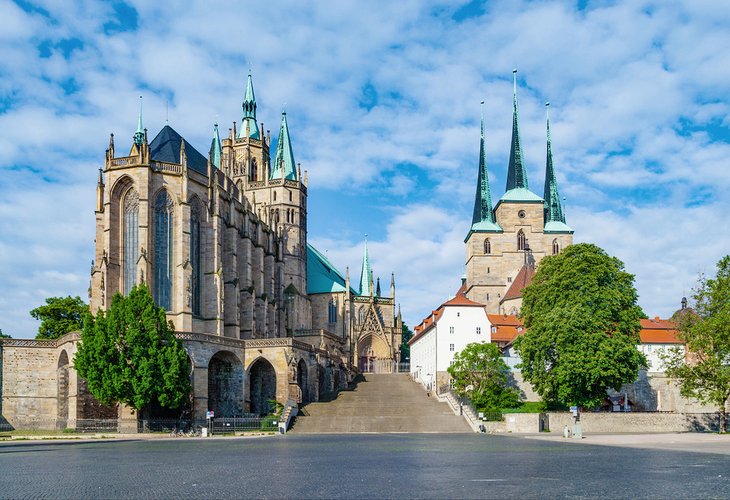
Roman Catholic Erfurt Cathedral (Erfurter Dom), also known as St. Mary's Cathedral, was founded in AD 742. It was replaced by a Romanesque basilica in 1154, and later additions included its High Gothic choir from 1370 and its three 19th-century towers.
The central tower houses the largest surviving medieval-era bell in the world, the Maria Gloriosa . Also known as the Erfurt Bell, it's famed the world over for the clarity of its tone. The cathedral's 15 tall windows in the choir are masterpieces of medieval stained glass and are unique in Germany for their size and unity of theme.
Among the cathedral's other treasures are its sumptuous Baroque high altar, the finely-carved 14th-century choir-stalls, a stucco figure of the Virgin from 1160, and the mid-13th-century tomb of Count von Gleichen and his two wives. A pleasant café is located on-site, and English language tours can be booked (a fun audioguide for kids and families is also available). For a special treat, be sure to return after nightfall when the cathedral is lit up to spectacular effect.
Address: Domstufen 1, 99084 Erfurt, Germany
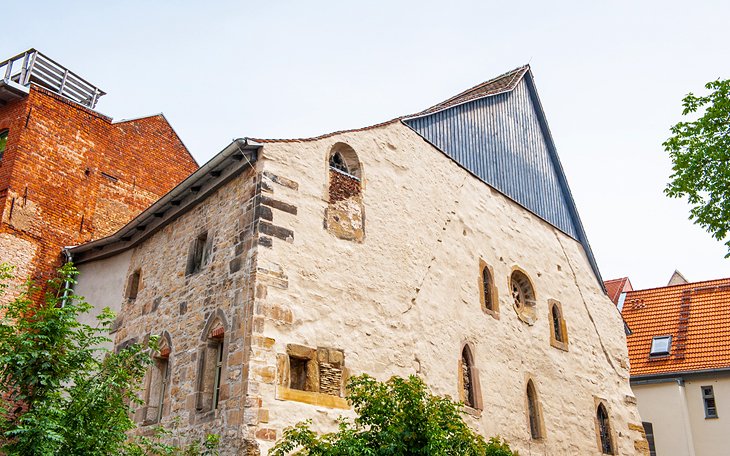
Built around AD 1100, the Old Synagogue (Alte Synagoge) in Erfurt is the oldest and most famous such religious site in Europe. Today, this well preserved medieval structure houses the excellent Erfurt Treasure (Erfurter Schatz), an extremely rare hoard of coins and jewelry believed to have been hidden during the Black Death of 1349 and the subsequent persecution of the city's Jewish population.
Discovered in 1998 in the city's old Jewish district and believed to have been hidden during a massacre of the Jewish community in the 1300s, the collection includes more than 3,140 silver coins, some 700 gold pieces, and 14 ingots from the 13th and 14th centuries. Also of interest are its reproductions of the original medieval Erfurt Hebrew Manuscripts, now held in the Berlin State Library. Guided tours lasting between 60 to 90 minutes are available.
Other sites related to the city's Jewish community are the Small Synagogue , a 19th-century house of worship, which now houses displays of Jewish life in Erfurt, and the Mikveh , a 13th-century bath used for religious ceremonies, now a museum. Together these sites provide a fascinating look into Jewish culture and lives in this part of Europe during the medieval period.
Address: Waagegasse 8, 99084 Erfurt
Official site: http://juedisches-leben.erfurt.de/jl/en/
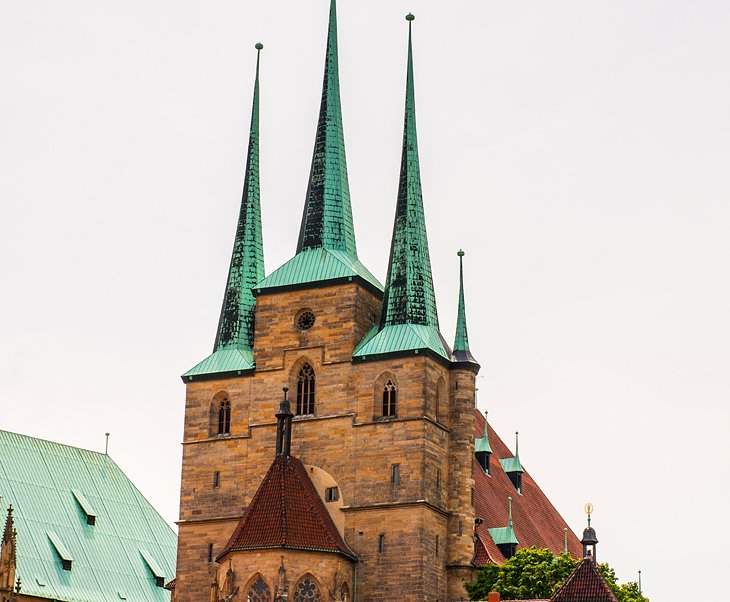
St. Severus Church, or the Severikirche, was first mentioned in 1121. Perched atop Erfurt's Domberg (Cathedral Hill), this lovely Early Gothic hall-church boasts double lateral aisles and a richly furnished interior, which includes the tomb of St. Severus from 1365 and a spectacular 15-meter-high font.
Joined to Erfurt Cathedral via a 70-step staircase, these two structures dominate the Domplatz, the historic cathedral square with its handsome old buildings. Also here is the 18th-century Grüne Apotheke (Green Pharmacy) and Zur Hohen Lilie, one of the finest Renaissance buildings in Erfurt.
Guided tours of St. Severus Church are available for a small charge, and can be combined with a tour of the neighboring cathedral.
Address: Severihof 2, 99084 Erfurt
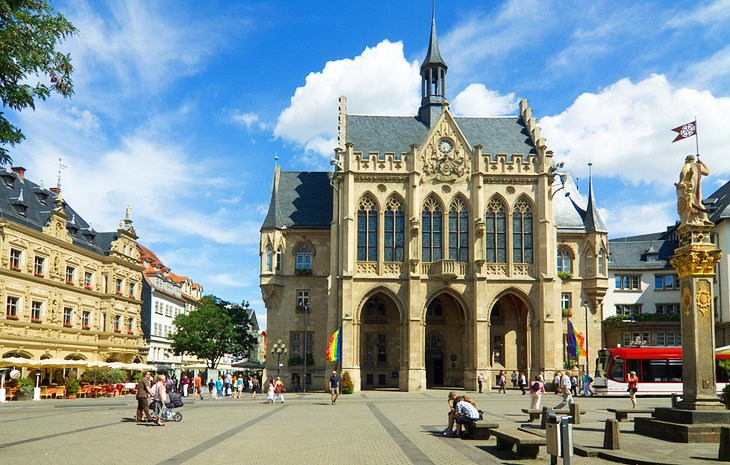
Erfurt's Marktstrasse leads into the Fischmarkt, or Fish Market, where the city's old trade routes once intersected. Highlights of the old square are a figure of Roland from 1591, and Zum Roten Ochsen and Zum Breiten Herd, two richly decorated Renaissance buildings.
Also of note is the attractive Neo-Gothic Town Hall (Rathaus). Built in 1874, it's notable for the large murals of local legends and characters adorning its interior walls. And be sure to look out for the Church of St. Aegidius . Located at the east end of the Old Merchant Bridge (see #5 below), it offers excellent views of the old city from its tower.
Address: Fischmarkt 1, 99084 Erfurt, Germany
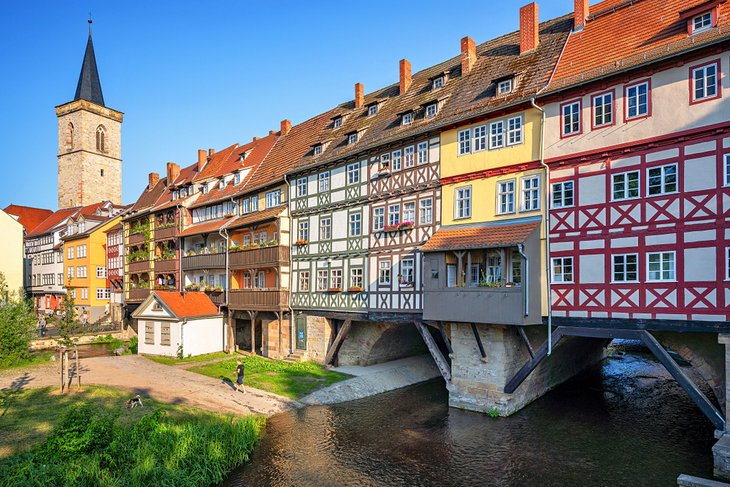
A short stroll to the northeast of the Fischmarkt is the city's famous Krämerbrücke, or Merchants' Bridge . First written about in 1117, this magnificent 125-meter-long medieval bridge spans the River Gera and is unique for the many old houses lining its sides. Little changed in 500 years, it's the longest such bridge in Europe.
It's a wonderful place to explore on foot - especially during the Merchants' Bridge Festival in June - and is full of quaint galleries, boutique shops, cafés, and restaurants. It's also still home to some 80 residents, who occupy the pleasant old townhomes that line the bridge.
Address: Krämerbrücke, 99084 Erfurt
Official site: www.kraemerbruecke.de/en
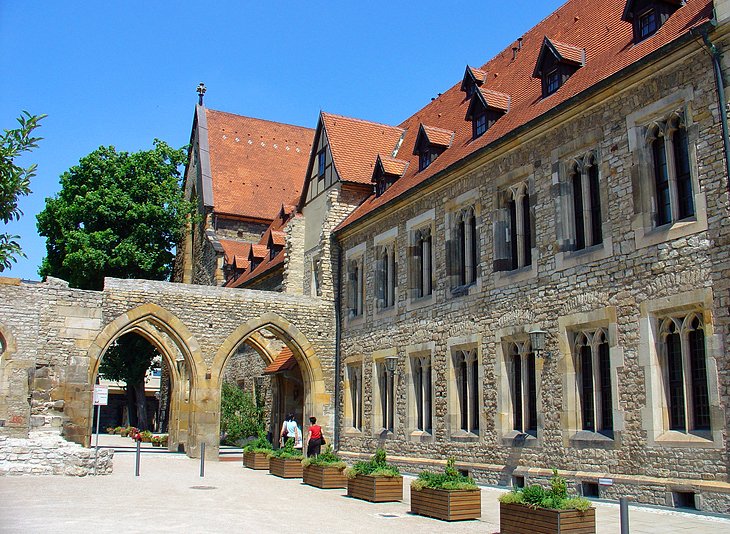
Augustinerstrasse is best known for its splendid 13th-century Augustinian Monastery (Augustinerkloster). Founded in 1277 and known in full as Protestant Augustinian Monastery Erfurt, it was here that the young Martin Luther became a monk in 1505. The property can be visited by guided English language tours, which include a look at Luther's tiny room, the Lutherzelle.
Other highlights include the beautiful Comthureihof from 1593 and the St. Elisabeth Chapel with its murals. There's also a fascinating exhibit called Bible Monastery Luther, which details the famous Reformer's time here.
Also of interest are the Georgenburse , the former student quarters where Luther resided as a 17-year-old in 1501. Other highlighths include the Luther Stone , a monument marking the place where the Reformer pledged to become a monk after being saved from death during a storm; and the Luther Trail , which connects Erfurt with 30 other sites across Thuringia. For a truly memorable experience, look into booking an overnight stay at the monastery.
Address: Augustinerstraße 10, 99084 Erfurt
Official site: www.augustinerkloster.de/en/
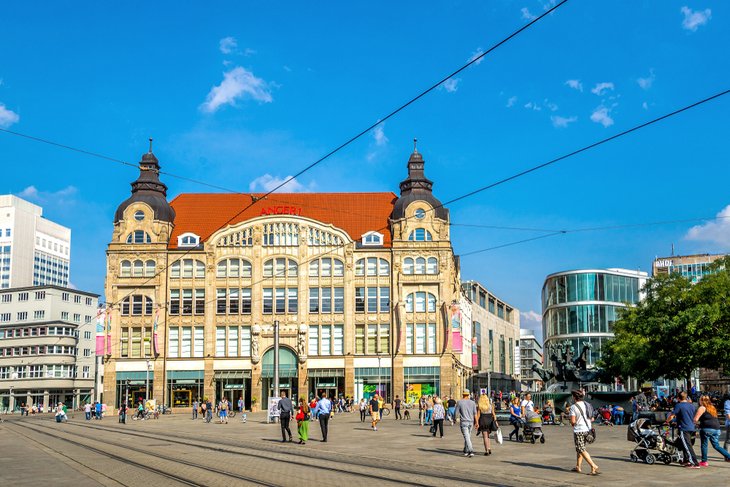
One of Erfurt's oldest streets, Anger has traditionally been the city's main shopping and trade area. Where once textiles, wool, and wheat were traded in Angerplatz , the central square where the street starts, numerous shops can now be found, from small craft and antique shops to fancy boutiques, galleries, and department stores.
Other tourist attractions include the Angermuseum , housed in the richly decorated Baroque Packhof, with displays of arts and crafts from the Middle Ages to modern times; and the Municipal Museum , housed in the richly decorated Haus Zum Stockfisch. This Late Renaissance building dates from 1607 and outlines the history of the city through informative displays and artifacts.
Anger is also where you'll find St. Bartholomew's Tower (Bartholomäusturm). This 12th-century structure is famous for its carillon of 60 bells.
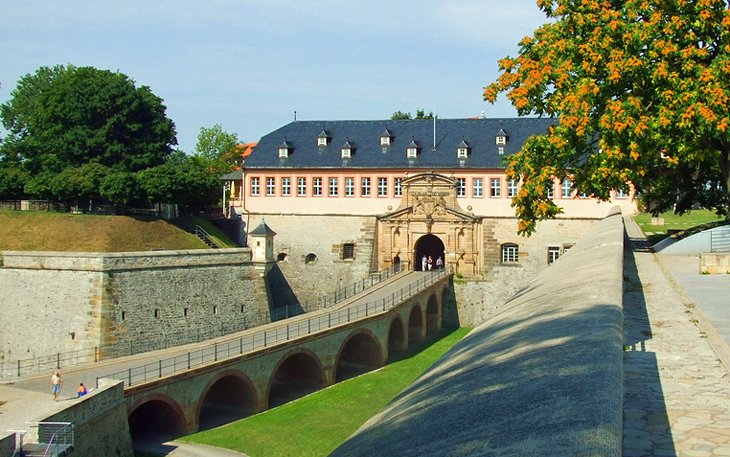
Another old district of Erfurt that must be visited is Petersberg, or St. Peter's Hill. Here, you'll find St. Peter's Church (Peterskirche), a splendid Romanesque aisled basilica built on the site of an 11th-century monastery and one of the earliest buildings of the Hirsau school in Thuringia.
Also of interest is Petersberg Citadel (Zitadelle Petersberg). Considered one of Europe's largest and best-preserved Baroque fortresses, the citadel is famous for its over two kilometers of sturdy stone walls. It was built in the 17th-century, and a highlight is exploring the fort's extensive maze of underground tunnels. These are accessible as part of a two-hour guided tour of the fortress. Along the way, you'll also see evidence of a Napoleonic-era tunnel, which joined Petersberg Citadel to the smaller Cyriaksburg Citadel.
Also worth visiting is the fort's fully-restored 19th-century bakery, which also includes a café. English language tours are available and can be organized through the local tourism office.
Address: Petersberg, 99084 Erfurt

To the north of Erfurt, on the Roter Berg, is the family-friendly Erfurt Zoo. This fun attraction is home to over 1,060 animals representing some 193 or so species. The zoo is particularly well known for its rare breeds of monkeys, including black-and-white colobuses, John's langurs, Entellus langurs, and Douc langurs.
Other highlights of this 153-acre site overlooking the old city are its African elephants, lions, giraffes, and white rhinos. There's also an interesting aquarium that's worth seeing. Also notable is the fun petting zoo area for those traveling with children, as well as a playground with water activities.
Guided tours are available, and an on-site restaurant, café, and snack bar serve a variety of family-friendly meals.
Address: Am Zoopark 1 99087 Erfurt
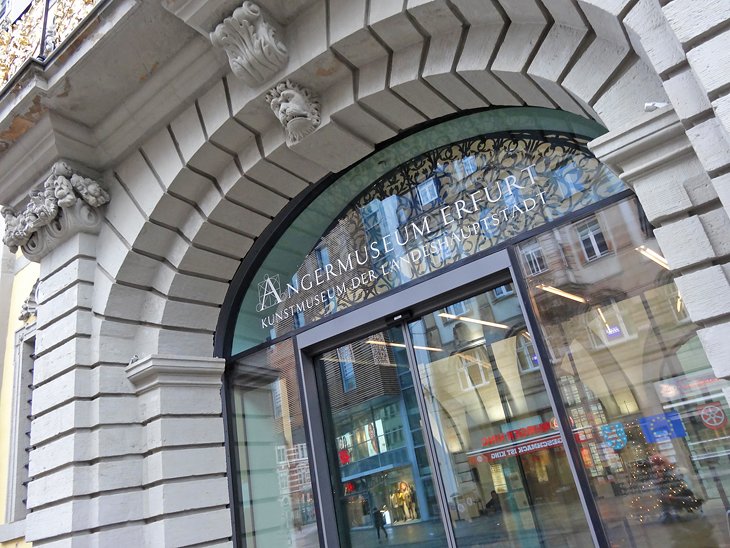
The city's first public museum, the Angermuseum was established in 1886 in a historic building notable for housing Erfurt's old public scales. Highlights of the museum's impressive collection of artwork includes examples by such notable German artists as Friedrich Nerly the Elder, famous for his paintings and sketches of Venice.
All told, the museum now houses over 700 paintings of scenes from Italy. German Expressionists represented here include Emil Nolde, Max Pechstein, and Gerhard Marcks, along with a number of rare murals by Erich Heckel.
Also on view are fine examples of graphic art, as well as medieval religious sculptures and paintings. German crafts are represented by a number of rare glass pieces (some as old as 800 years), porcelain, and jewelry.
The Erfurt Natural History Museum (Naturkundemuseum Erfurt) is also worth a visit. It's notable for its interesting displays relating to the geology and animal population of Thuringia.
Address: Anger 18, 99084 Erfurt
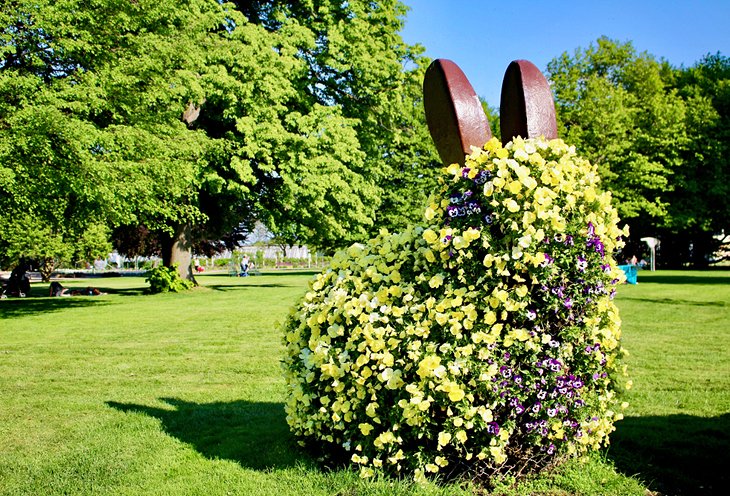
Erfurt is also known for its many pleasant public parks and green spaces. One of the best is egapark Erfurt . Established in the 1960s, it's notable for its many period sculptures, and for being home to Europe's largest ornamental flowerbed.
Other attractions here include a pleasant Japanese rock and water garden, a rose garden, and a number of tropical greenhouses. If traveling as a family, be sure to take the kids to the butterfly house. Afterwards, let them blow off steam in what's billed as the state's biggest playground, which includes a petting farm.
Also of interest is Cyriaksburg Castle . Although a relatively small citadel, it's worth visiting for the German Horticultural Museum (Deutsches Gartenbaumuseum), with its interesting displays and exhibits relating to the country's strong affinity to gardening over the centuries.
Address: Gothaer Str. 38, 99094 Erfurt
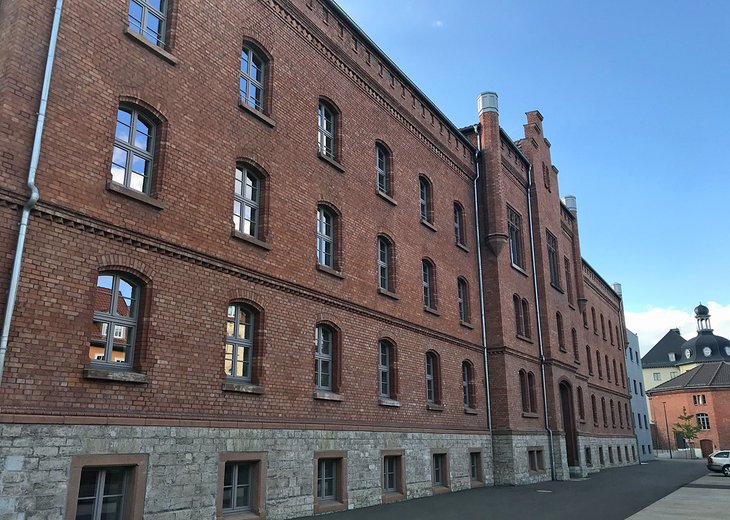
Erfurt is also where you'll find two important museums that deal with more recent history: the Nazi and Communist regimes. The first of these, the Memorial and Education Centre Andreasstraße (Gedenk- Und Bildungsstatte Andreasstrass) deals with the socialist dictatorship that occupied the region after the war and until the fall of the Berlin Wall in 1989.
Housed in a former prison run by the infamous Stasi police, the museum's permanent exhibits include fascinating multi-media presentations covering matters such as revolution and imprisonment, as well as a chilling look at the nature of dictatorship. Other highlights include the chance to visit a fully restored prison wing. English language guided tours are available by arrangement.
Equally sobering is Remembrance Topf & Sons - Builders of the Auschwitz Oven (Erinnerungsort Topf & Söhne - Die Ofenbauer von Auschwitz). Housed in the former factory where the infamous ovens and related equipment used to murder millions in Auschwitz was made, this educational center and museum has, since 2011, served as a chilling reminder of the horrors of the Nazi dictatorship. This shocking story of industrial collaboration includes displays from the company's archives and artifacts from the concentration camps in which they were complicit in genocide.
Address: Andreasstraße 37a, 99084 Erfurt
Official site: https://stiftung-ettersberg.de/en/andreasstrasse/
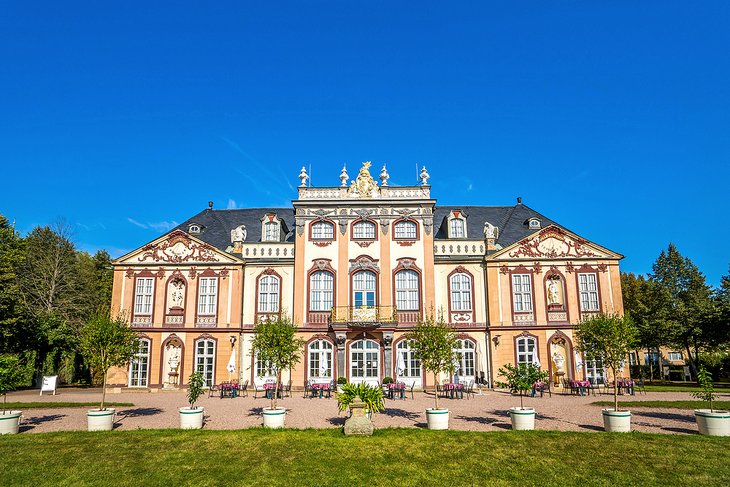
Just 10 kilometers southwest of Erfurt, the moated Molsdorf Palace and Park (Schloss Molsdorf) is one of the finest Rococo palaces in Thuringia. Built by Count von Gotter as a summer palace between 1736 and 1745 and thoroughly restored, it's now a museum open to the public.
Highlights include a hidden spiral staircase in the Count's bedroom; sumptuous period interior décor; and numerous pieces of artwork, including statues and vases. An on-site museum offers fascinating details of the palace's construction and history, as well as the colorful life of Count von Gotter. Guided tours are available.
A café is on-site and overlooks the beautiful park, laid out in 1826 and fun to spend time exploring.
Address: Schloßplatz 6, 99094 Erfurt
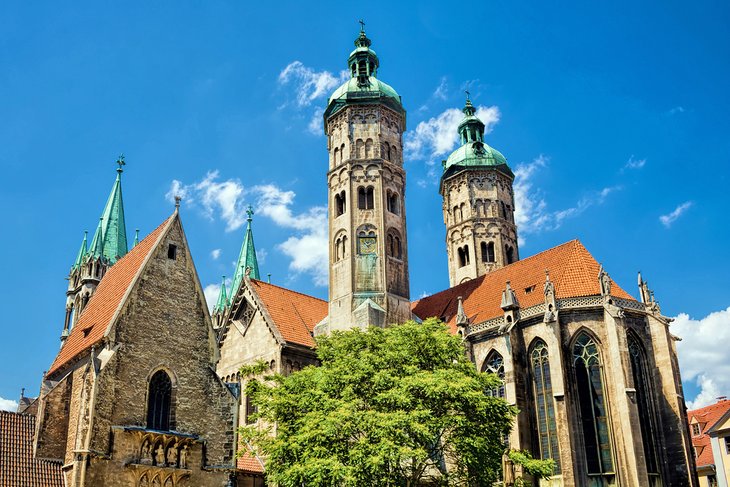
Located about 100 kilometers northwest of Erfurt is the Late Romanesque and Early Gothic Cathedral of Saints Peter and Paul (Naumburger Dom St. Peter und St. Paul) in Naumburg. Widely regarded as one of Europe's finest cathedrals - it was also recognized as a UNESCO World heritage Site in 2018 - this aisled cruciform basilica with its vaulted roof, twin choirs, four towers, and Romanesque crypt, was built in 1170. It's perhaps best known for the 12 figures of the donors who funded its construction.
Set in the West Choir, these life-size masterpieces, known locally as "Stifterfiguren," were carved from limestone by an unknown local artist in 1250 and include two that have since become known as the city's most famous couple: Ekkehard and Uta.
Other interior highlights of outstanding quality in Naumburg Cathedral are the reliefs of the Passion on the west choir screen, the medieval stained glass in some of the windows, several altars and sculptures, and a number of fine monuments. On the south side of the cathedral, incorporated in the cloister, is the parish Church of St. Mary (Marienkirche).
Address: Domplatz 16, 06618 Naumburg (Saale)
Official site: www.naumburger-dom.de/en/
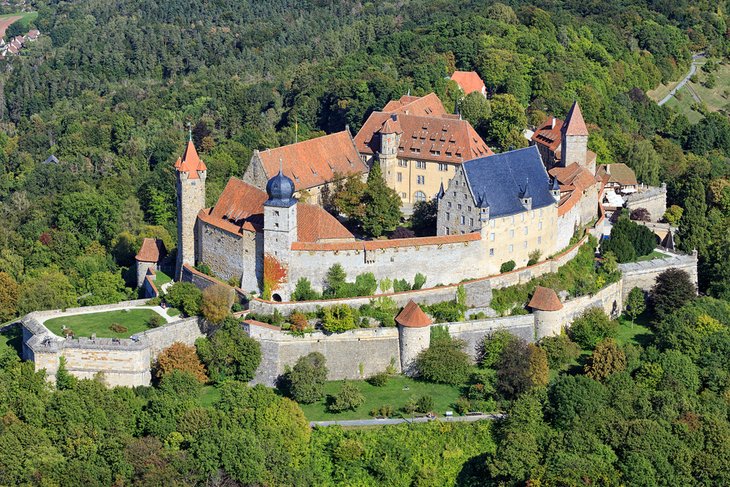
Located about 90 kilometers south of Erfurt, the former ducal capital of Coburg lies on the southern slopes of the Thuringian Forest on the river Itz, a tributary of the Main. Looming over the city, Coburg Fortress (Veste Coburg) is one of the largest castles in Germany, dating mainly from the 16th century and restored in the 19th and 20th centuries.
The art collections in the Luther rooms here feature impressive displays of old glass, porcelain, and decorated earthenware. Extending up the hill to the castle lies the beautiful Hofgarten (Court Garden) with many important monuments and the mausoleum of the Dukes.
Other Coburg palaces to visit include the magnificent Ehrenburg , formerly the ducal palace, Schloss Rosenau, and Callenberg Palace , a medieval castle with centuries of royal history to reveal.
In the town center, the attractive Markt is a lovely place for a stroll with its Town Hall (Rathaus) dating from 1579 and the former government offices in a richly decorated Late Renaissance building of 1599.
Address: Veste Coburg 1, 96450 Coburg
Official site: www.kunstsammlungen-coburg.de/en/home/
We recommend these conveniently located hotels in Erfurt with easy access to the Old Town:
Luxury Hotels :
- When it comes to a luxury stay in Erfurt, you won't be disappointed when you check into the elegant Dorint Hotel am Dom Erfurt . Just steps away from top tourist attractions, including Erfurt Cathedral and the Old Synagogue, this attractive modern hotel boasts large suites (some with kitchenettes), gorgeous décor, and great amenities, including a fine-dining restaurant overlooking the city.
- Other great choices for centrally located luxury accommodations include Hotel Zumnorde , a chic boutique inn with a variety of larger suites (some with balconies and kitchens); and Victor's Residenz-Hotel Erfurt , an elegant four-star affair offering spacious suites with separate living areas, two restaurants, and complimentary breakfast.
Mid-Range Hotels :
- Mercure Hotel Erfurt Altstadt is a great mid-priced choice of hotel, popular for its friendly staff; central location; and comfortable, quiet rooms.
- Other mid-range hotels to consider include the Best Western Plus Hotel Excelsior , which offers large rooms and suites with work desks and separate seating areas, and Hotel Am Kaisersaal , located close to the cathedral and offering a number of larger rooms with pullouts that are great for those traveling with kids.
Budget Hotels :
- A good option that's very affordably priced can be enjoyed at Pension Gerber . Rooms are basic but clean and comfortable, with some of the larger suites able to sleep up to four guests.
- Other good options include re4hostel , a high-rated yet no-frills hostel-style establishment, which offers a number of private accommodation options in a great central location; and B&B Hotel Erfurt , offering free breakfasts and clean, comfortable rooms.
More Related Articles on PlanetWare.com
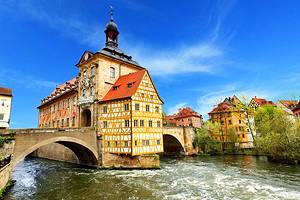
Take the Train : Just 15 minutes east of Erfurt by rail is Weimar . Widely considered the cultural capital of Germany, it's here you'll find Goethe House, the home for 50 years of famed writer Johann Wolfgang von Goethe, as well as the Bauhaus Museum, a superb facility that commemorates Germany's most important design movement.
Just 45 minutes farther east are the attractions of Leipzig , including its historic Mädlerpassage, a superb old shopping arcade that is a delight to explore on foot. Bamberg , 45 minutes by train to the south, is another must-visit, this time for its Old Town Hall (Altes Rathaus), famous for being built in the middle of a bridge.
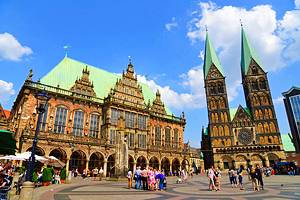
Magnificent Marketplaces : Germany's historic towns and cities are wonderful places to explore, especially those that have managed to preserve their old marketplaces, or Marktplatz (which is a lot of them!). Favorites include historic Hanover , whose Old Town area centers around the Marktplatz and its attractive church, Marktkirche, as well as the northern port city of Bremen , known for its Marktplatz statue of Roland, the country's best-known knight.
Another important Marktplatz can be enjoyed in Wittenberg . Famous as the birthplace of Reformer Martin Luther, the city's Marktplatz has been declared a UNESCO World Heritage Site for the sheer number of important historic buildings located around it.
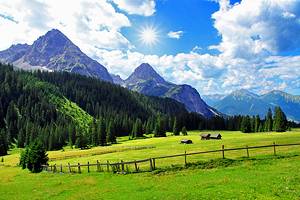
Bavaria Bound : Bavaria is not only one of the most famous of Germany's states, it's also one of the top places to visit. Fun things to do here include exploring the Bavarian Alps, home to the spectacular Zugspitze, part of the popular Garmisch-Partenkirchen resort region , and the Berchtesgaden National Park, a popular destination for hikers from across Europe.
Bavaria is also where you'll find beautiful Lake Constance , popular for its historic old towns and villages, its lakeside hiking and biking trails, as well as for being home to the magnificent 'flower island' of Mainau.
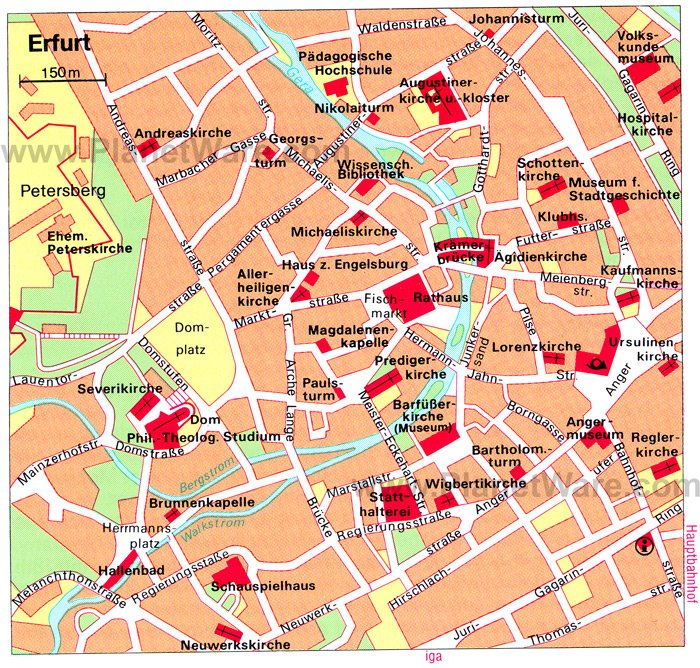
More on Germany


Germany Footsteps
16 Incredible Things To Do In Erfurt For An Amazing Trip [Don’t Miss Them]
Discover the top 16 activities and must-see attractions in Erfurt, a hidden gem nestled in the heart of Germany with a charm that whispers tales from the Middle Ages through to the modern day. This guide will be your compass to the city’s finest experiences, from historical wonders to contemporary delights.
Often ignored by foreign tourists, Erfurt offers a lot for those that make the small amount of effort to come here. As soon as I arrived in the Old Town of Erfurt and wandered through the cobblestone streets, it quickly became one of my favorite places in Germany. Then I saw Cathedral Hill and walked across Krämerbrücke (Merchant’s Bridge) and I was fully in love with Erfurt. 😍
I love the atmospheric Old Town, the history, everything really!
And whether you’re peering up at the awe-inspiring spires of the Erfurt Cathedral or walking across the famed Krämerbrücke, a sense of wonder is guaranteed.
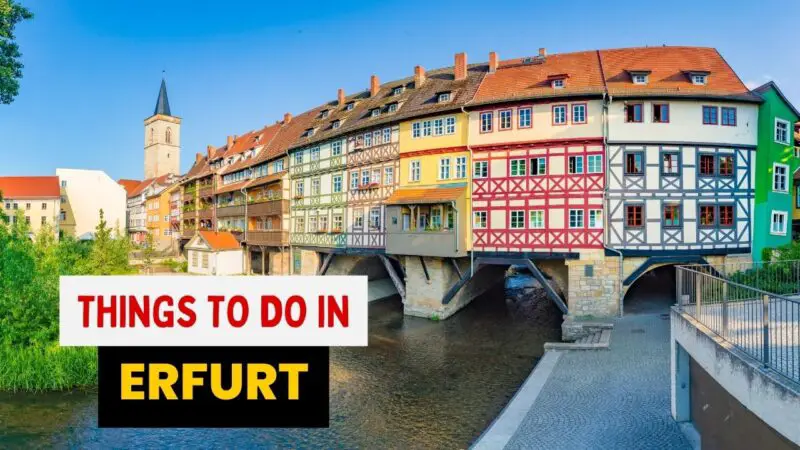
While the city skilfully honors its past, it also embraces the present with lively cafes, boutique shops, and a buzzing atmosphere that invites you to dive in and explore.
In a city brimming with rich history and picturesque views, pinpointing the very best things to do in Erfurt can be a delightful challenge. That’s precisely why I’ve curated this list, featuring a combination of well-loved classics and hidden treasures that are as intriguing as they are accessible.
Ready to uncover the historical heart of Germany? Let’s step into the story that is Erfurt, one extraordinary experience at a time.
Love Germany? Click here to download your free guide to ALL of Germany’s Amazing UNESCO sites . See all 52 of them!
Don’t miss the best hotel savings in Germany here >>
Table of Contents
A Brief History of Erfurt
Erfurt, the capital city of the state of Thuringia in central Germany, boasts a rich and varied history that stretches back over a millennium. Its origins can be traced back to the prehistoric era, but the city’s significant development began with its establishment in the early Middle Ages.
Erfurt was first mentioned in 742 AD by Saint Boniface, the famed missionary who considered it an ideal site for spreading Christianity. The city’s advantageous position at the intersection of old Germanic and European trade routes, most notably the Via Regia, which connected Eastern and Western Europe, fostered its rapid growth and importance as a commercial hub.
The establishment of a bishopric in the 8th century further elevated Erfurt’s status, and by the 10th century, the city was a prominent religious center. The construction of the Erfurt Cathedral and the Severikirche, both perched on the Cathedral Hill, encapsulate the city’s medieval ecclesiastical significance.
The Middle Ages saw Erfurt rise to prominence as a center of learning and enlightenment. The University of Erfurt, founded in 1379, is one of the oldest universities in Europe. It became a cradle of humanist thought during the Renaissance with notable scholars, including Martin Luther, who studied there in the early 16th century.

This intellectual heritage was integral in shaping Reformation ideas that would sweep across Europe.
During its history, Erfurt has faced many turbulent periods including the Peasants’ War in 1525 and the Thirty Years’ War from 1618 to 1648, which brought about much destruction. However, the city continued to thrive economically due to its production of woad, a plant used for blue dye, which was a highly prized commodity in Europe.
The modern industrial era introduced railway manufacturing and other industries to Erfurt, further securing its economic relevance. During World War II, the city suffered damage, although less extensive compared to other German cities. In the post-war period, Erfurt became part of the German Democratic Republic (East Germany) until the reunification of Germany in 1990.
After reunification, Erfurt underwent substantial preservation and restoration efforts to revive its historical buildings and cultural heritage. Today, it is known for its well-preserved medieval city center, the renowned Krämerbrücke (Merchant’s bridge), and as a vibrant cultural location that honors its multifaceted past while looking towards a dynamic future.
Top 16 Incredible Things To Do In Erfurt

The first 12 Erfurt attractions in the list are in Erfurt itself. The next three are half or full day trips you can make from Erfurt.
Something I really loved about staying in Erfurt was the easy access to some great other towns in Germany that are well worth the day trip. So consider doing them!
1. Erfurt Cathedral and St. Severus Church (Erfurter Dom und Severikirche)
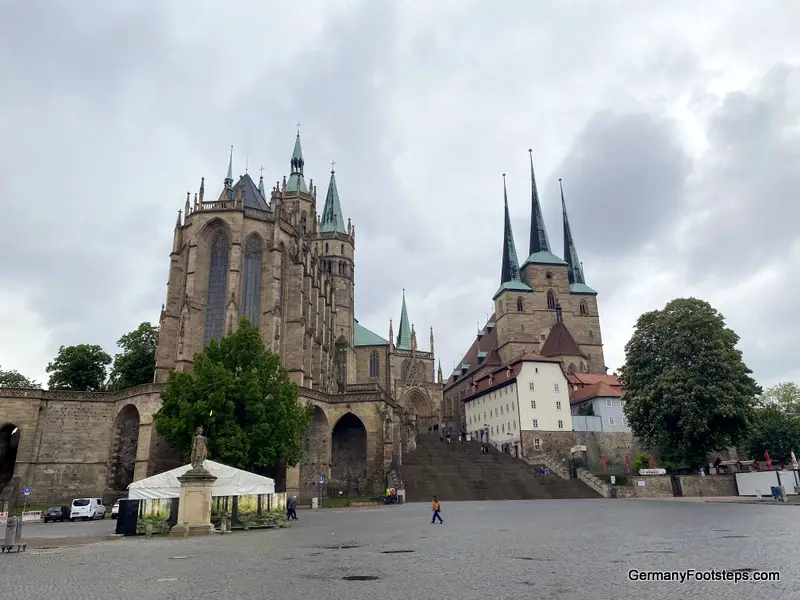
Situated on a hill, Domberg (Cathedral Hill) that really shows off the majesty of these churches, the Cathedral of St. Mary and the St. Severus Church are jewels of Gothic architecture and the spiritual center of the city.
I got a shock when I turned a corner and saw these churches looking over me from the massive Domplatz.
The cathedral started its life in the 8th century as a simple cathedral and now is a stately Gothic church most famous for being where Martin Luther was ordained as a priest.

It boasts the world’s largest free-swinging medieval bell, the Maria Gloriosa. You can marvel at the cathedral’s stunning stained glass windows and check out the Wolfram, an 850 year old candelabrum.
In the adjacent St. Severus Church, the three naves speak volumes about its architectural evolution since the late 13th century. It’s home to some treasures too including the sarcophagus of St Severus which was brought here from Ravenna via Mainz in the 9th century.
Together, they offer not just a historical and religious excursion but a remarkable architectural journey as well.
2. Amazing Squares
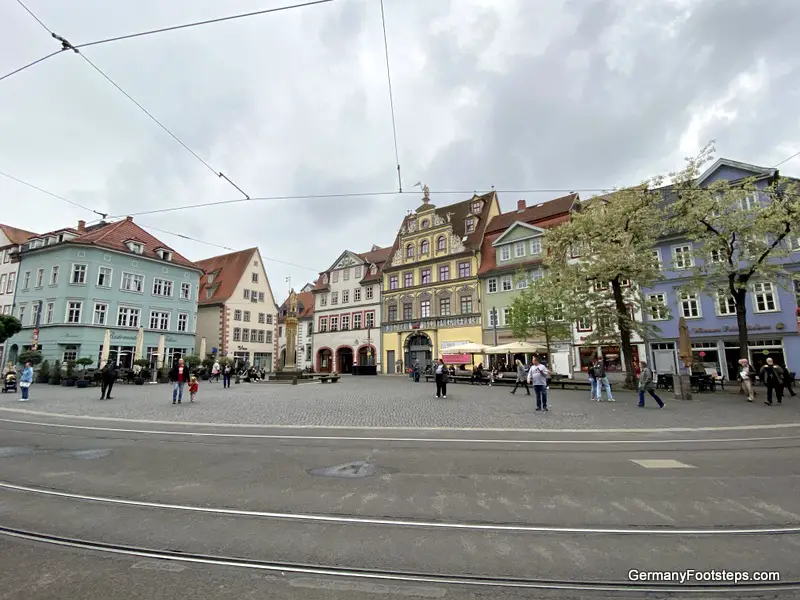
Exploring the historic quarters of Erfurt is like leafing through the pages of time. The main squares such as Domplatz, the site of the magnificent Erfurt Cathedral, Anger, Wenigemarkt, and Fischmarkt are hubs of public life, surrounded by traditional and Renaissance buildings.
Domplatz is particularly notable for hosting events like the Christmas market under the watchful eyes of Erfurt Cathedral and St. Severus Church.
Anger, once a medieval trade and processions route, now basks in its evolution as a modern shopping haven.
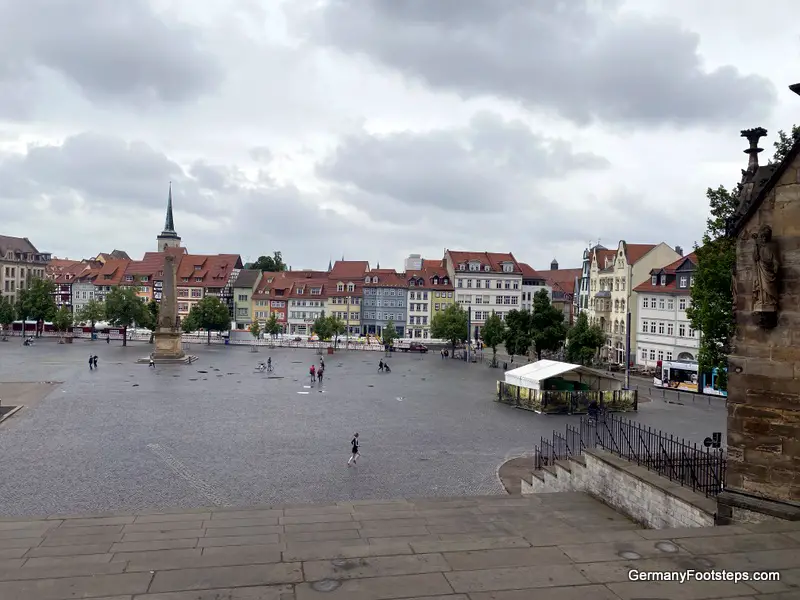
Wenigemarkt, with its quaint cafés and crafts shops, offers an intimate town square feel, while Fischmarkt, the political center, is home to the neo-Gothic Erfurt Town Hall as well as many other stunning buildings. These squares are living museums, perfect for travelers seeking to touch the city’s heartbeat.
I recommend you wander between these, soaking up the Old Town atmosphere and visiting other attractions in Erfurt on this list.
3. Merchant’s Bridge (Krämerbrücke)

Krämerbrücke is one of Erfurt’s architectural marvels – a bridge not only traversed by people but inhabited by them. Its history dates back to the 12th century, though its current appearance was formed in the 16th century.
With its continuous row of half-timbered houses on both sides, the bridge has a lively micro-community feel, hosting art galleries, cafés, and antique shops that maintain the historical charm of this medieval marvel.

This really must be one of the most charming places in the world. It seemingly goes on and on with so much beauty and things to look at. Don’t believe me? Here’s just a short section:
It’s the only bridge north of the Alps that’s still inhabitated with people living above the small shops.
At the eastern end of the bridge is a small church with a tower you can climb for views from above (coming up next!).
Strolling across Krämerbrücke is a must-do Erfurt attraction for the atmospheric experience it offers. You can savor traditional Thuringian cuisine, purchase unique handcrafted souvenirs, and immerse themselves in a living piece of history that encapsulates the merchant spirit of old Erfurt.
See and learn more about Krämerbrücke in our full guide here.
4. St Aegidien Church (Ägidienkirche )
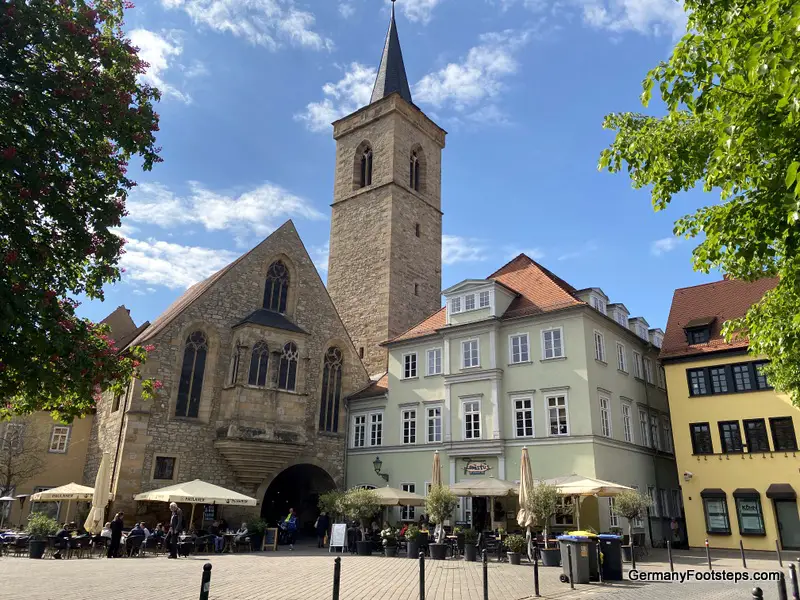
Where you enter the bridge from Wenigemarkt you actually go under this church. From underneath, there is a door to take you up to the church level.
From here, you can pay to climb the tower pictured for pretty views of the bridge and Erfurt.

It’s not the longest tower climb so it’s relatively easy. It’s worth it for the views!
Even if you don’t want to climb up the tower, go up the stairs to the church level and you can see the bridge’s shop and road from above here too. It’s super pretty!
5. Petersberg Citadel (Zitadelle Petersberg)
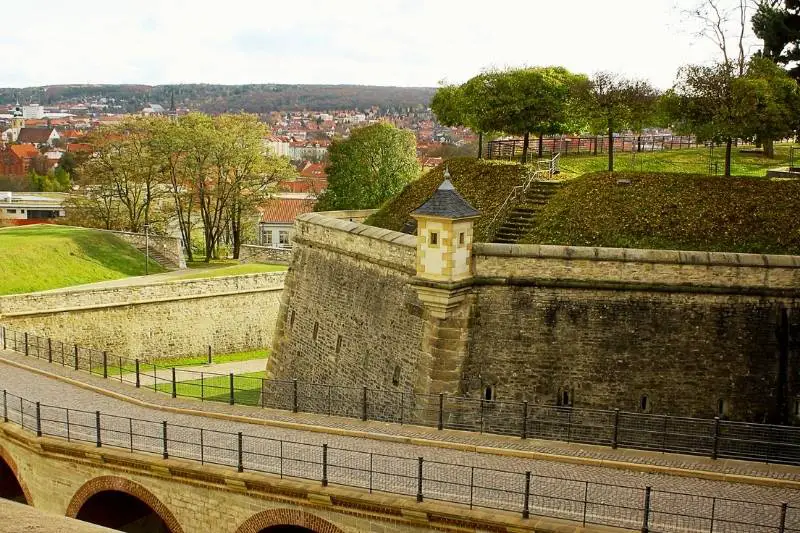
Petersberg Citadel, a breathtaking example of European baroque military architecture, reigns as a formidable structure reflecting Erfurt’s historical strategic relevance. It’s one of Europe’s best preserved and largest baroque fortresses.
Built in the 17th century atop Petersberg hill, it represents centuries of military history, with its intact bastions, casemates, and underground passages. The citadel not only tells tales of military prowess but also offers a peaceful park landscape, giving stunning elevated views of the city.
The Citadel’s ingenious design and the panoramic views of Erfurt’s timeworn treasures it provides make it a must-visit for history enthusiasts and photographers alike. There’s also a fun “ERFURT” sign.
Most buildings are closed, but there are regular tours of the underground tunnels in German. You can also wander the grounds for free.
6. Old Synagogue (Alte Synagoge)

The Old Synagogue in Erfurt is an emblem of endurance, surviving centuries of varied history. As one of the oldest synagogues in Europe, established around the late 11th century, it has witnessed Erfurt’s Jewish community’s highs and lows.
The synagogue was inadvertently protected over the ages as it was built over and forgotten after the Black Death pogrom in 1349.
It now serves as a museum displaying pieces such as the Erfurt Treasure—a collection of coins, goldsmith’s work, and Gothic hallmarks—and the Erfurt Hebrew Manuscripts. You get to engage with an ancient history that is fundamental to understanding the diverse cultural fabric of medieval Europe, making the Old Synagogue an invaluable historical visit.
Combined with the Mikveh, and the Stone House in Erfurt, this is a UNESCO World Heritage listed site.
7. St. Michael’s Church (Michaelskirche)

The magnificent St. Michael’s Church (Michaelskirche) offers an insightful peek into Erfurt’s ecclesiastical heritage.
This church dates back to the late 12th century and is home to an organ from 1652. It was a key place for protestants in the 16th century and for people towards the end of the German Democratic Republic.
It’s a beautiful church which is well worth a peak.
8. Augustinian Monastery (Augustinerkloster)
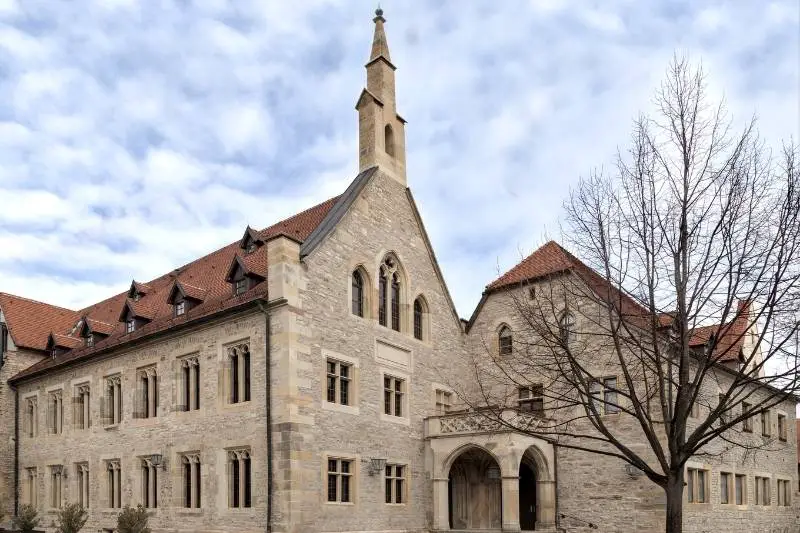
For anyone interested in history, particularly the Reformation and Martin Luther, you won’t want to miss visiting this one of the things to do in Erfurt.
The Augustinian Monastery was home to Martin Luther from 1505 to 1511. It’s where he was ordained as a monk and read his first mass.
Today, the monastery is an oasis for reflection and houses a museum that offers insights into Luther’s life, showcasing original artifacts from his time as well as a re-created Luther cell. The monastery also still hosts services in its Gothic stained-glass window church and you can roam the grounds and attend a service.
Unfortunately, you can only visit the museum and cell as part of a German language tour. You can visit the church individually.
9. “Little Venice” (Venedig)

Adorning the banks of the Gera River, the “Little Venice” area is a green and peaceful part of Erfurt. While not reminiscent of the famed Italian city at all, it does have gentle waterways and nice parkland as well as walking and biking paths.
This enclave of greenery provides a tranquil contrast to the city’s bustling centers. Here, you can enjoy the simple pleasure of a waterside stroll, offering a chance to unwind and soak in the serene atmosphere.
10. Museum of Thuringian Folklore (Museum für Thüringer Volkskunde)
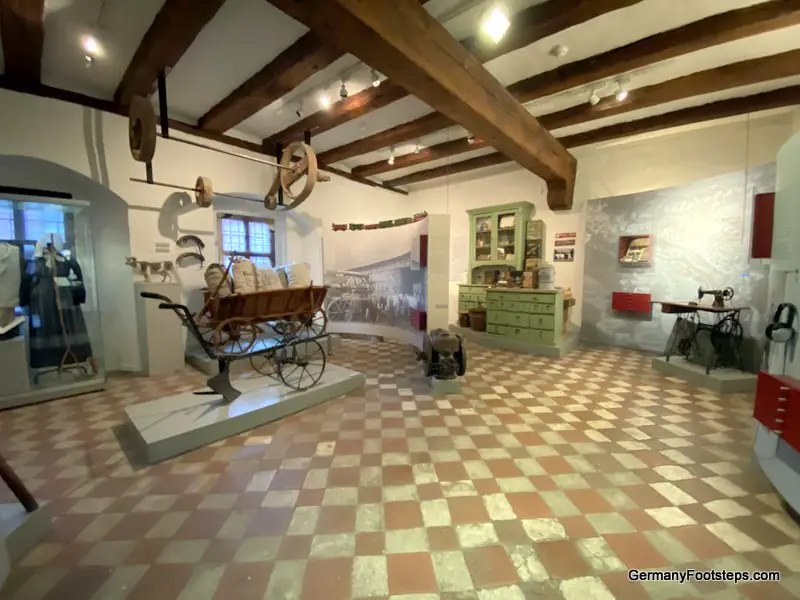
The Museum of Thuringian Folklore is a celebration of local culture, exhibiting a rich array of traditional artifacts, textiles, and crafts that paint a colorful picture of rural life in Thuringia throughout history. It’s one of the largest of its kind in Germany.
It provides a detailed narrative of everyday life, folk traditions, and the regional identity that has shaped the people of this area. Located in a former hospital director’s house, the museum itself is a part of the story, adding an authentic backdrop to the impressive collections.
You can leave with a deeper understanding of the customs, artistry, and historical lifestyle that are integral to Thuringia’s cultural heritage.
I found I learned a lot in this museum, but it’s worth noting that it’s only in German. I used my phone and Google Translate a lot, which was annoying but did the job.
11. City Museum (Stadtmuseum)

Housed in the late-Renaissance Haus zum Stockfisch, the City Museum stands as a guardian of Erfurt’s cultural narrative. Its exhibitions detail the city from its early settlement days through to life under Nazism and socialism to the present, presenting numerous artifacts, documents, artworks, and interactive displays.
Key parts of the collection relate to Erfurt’s university, its economic history as a trading center, and its urban development. Each themed area within the museum helps stitch together a cohesive and comprehensive tapestry of what makes Erfurt historically significant.
The museum, through its engaging storytelling, ensures every visitor cultivates a stronger connection with the city’s past and its evolving identity. This museum also has a lack of English.
12. Angermuseum
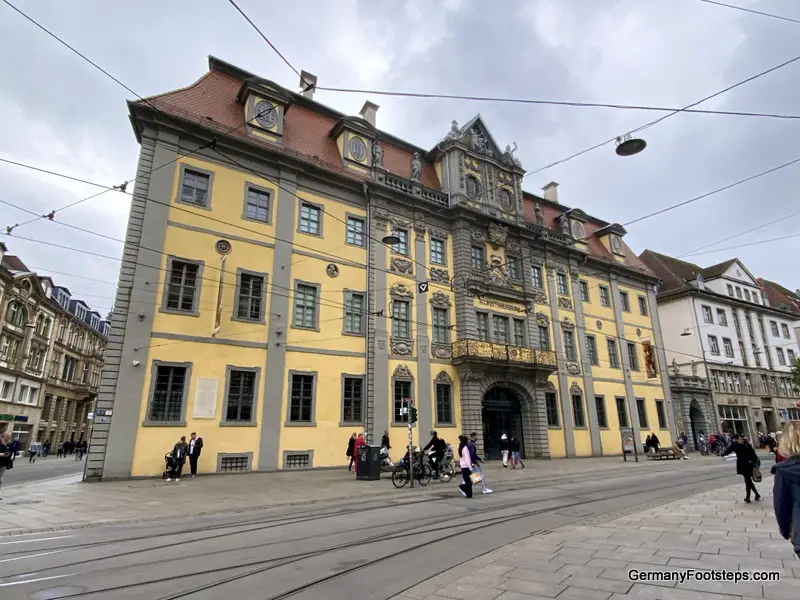
The Angermuseum, Erfurt’s main art museum, graces a former baroque city palace and serves as a custodian of Thuringian art and cultural history. Its vast collection spans from the medieval period to contemporary art, with an emphasis on medieval panel paintings and early modern art.
This historical repository impresses with the Erfurt Picture Atlas, remarkable works of the Middle Ages, and vibrant modern exhibitions. The architecture of the museum itself, with its vaulted ceilings, adds to the atmosphere, embodying the art it protects.
A haven for art lovers, the Angermuseum offers an insightful perspective on the cultural evolution of Erfurt and Thuringia through its creative expressions.
13. Egapark Erfurt and the German Horticultural Museum (Deutsches Gartenbaumuseum)
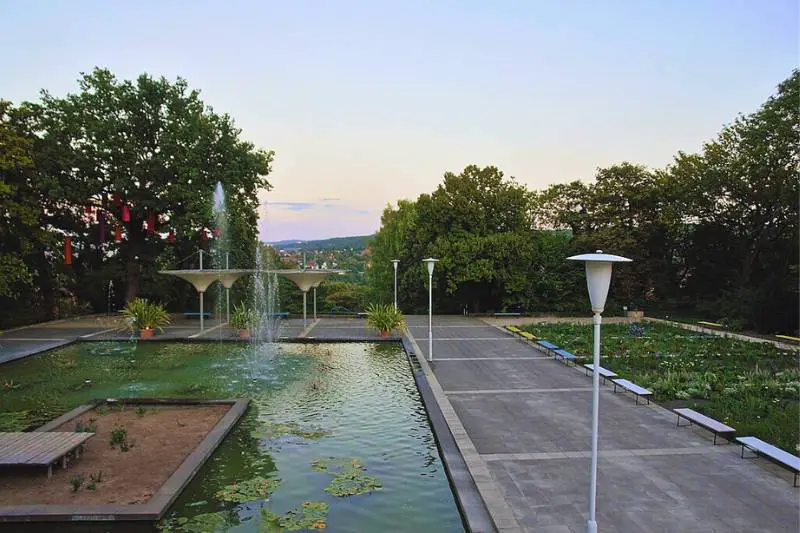
Egapark Erfurt serves as a verdant retreat spread over a vast expanse, considered one of the largest in Germany. It’s a horticultural paradise, providing an array of sensory experiences throughout its meticulously maintained gardens.
From the fragrance-filled rose garden to the largest ornamental flowerbed in Europe, each section of the park is designed to showcase the diversity and beauty of flora through thematic landscaping. The butterfly house enchants with its array of colorful species fluttering amidst tropical plants.
The park also hosts the German Horticultural Museum, located within the historic Cyriaksburg Citadel. This museum is wholly dedicated to the art and craft of horticulture, featuring exhibitions that trace gardening history from antiquity to the present.
It houses a sweeping collection of historic gardening tools, books, and models, providing you with a detailed look at how gardening science and styles have evolved over time.
Together, they offer a living gallery that educates, inspires, and delights. The blend of natural wonders with cultural insights makes the Egapark and the German Horticultural Museum a destination that’s both a feast for the eyes and the mind.

Just a short 15-minute train ride from Erfurt, a day trip to Weimar is an unmissable experience for any visitor to Thuringia. Brimming with cultural and historical significance, Weimar is a testament to Germany’s intellectual past, famously associated with literary giants Goethe and Schiller, and the birthplace of the Bauhaus movement.
The city’s history is palpable, with UNESCO World Heritage sites such as the Duchess Anna Amalia Library, which houses a vast collection of books from the Enlightenment, and the homes of Goethe and Schiller, both now meticulously preserved museums. You can also explore the Bauhaus Museum for a dose of 20th-century art and design innovation.
For those seeking to engage with Germany’s profound literary and philosophical heritage, or simply to soak in the charming streets and parks that inspired some of the country’s most celebrated intellectuals, Weimar is a captivating destination. It has such a grand feel as you wander the streets and is well worth the effort even if you only have half a day free.
It takes less than 15 minutes to get here by train from Erfurt, so there’s really no reason not to visit.
Click here to read our full guide to Weimar.
15. Wartburg Castle and Eisenach
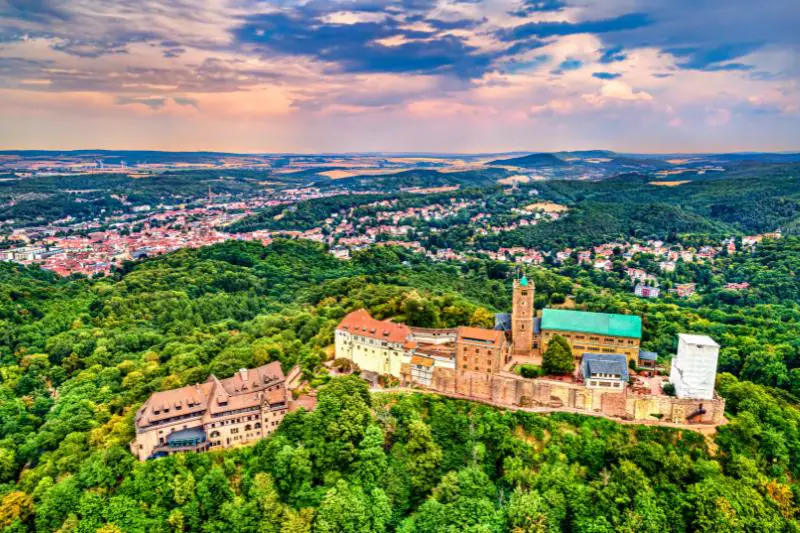
A day trip to Eisenach, less than an hour’s train journey from Erfurt, is an essential addition to any traveler’s itinerary looking to capture the spirit of German history and culture.
Eisenach is most renowned as the home of Wartburg Castle, a UNESCO World Heritage site where Martin Luther translated the New Testament into German, profoundly shaping the future of Christianity and the German language. It’s an amazing place to visit and do a tour.
History enthusiasts will revel in the town’s well-preserved architecture and the Bach House, where you can immerse yourself in the life and music of the legendary composer Johann Sebastian Bach who was born in this very house. Nature lovers can venture into the lush surroundings of the Thuringian Forest for hiking or simply taking in the scenic landscapes.
Meanwhile, automotive fans can’t miss the opportunity to visit the Automobile Welt Eisenach museum, celebrating the region’s contribution to car manufacturing.
The seamless journey from Erfurt to Eisenach, with regular train services linking the two towns, means that you can step back in time within the imposing walls of the Wartburg Castle or wander the leafy pathways once trodden by Bach and Luther, all with the convenience of a short return trip to Erfurt in time for dinner.
Click here to read our full guide to Eisenach.
16. Mühlhausen

Nestled within the lush, green heart of Thuringia, a day trip to Mühlhausen offers a delightful escape to a town rich in medieval history and charm. An easy 45-minute train ride from Erfurt, Mühlhausen greets you with an impressive array of historical structures, including well-preserved city walls and a skyline punctuated by numerous church spires, earning it the nickname “City of Towers.”
Mühlhausen’s fascinating past as a once-powerful member of the medieval Hanseatic League is still evident today as you wander through its cobbled streets. The town’s highlight is the 13th-century Divi-Blasii church, where the great Johann Sebastian Bach once served as an organist.
The Müntzer Memorial at St. Marien, commemorating the preacher Thomas Müntzer, provides insight into the turbulent times of the Peasants’ War. One upon a time, a lot happened here!
It’s a lovely place to just wander and the prettiest Old Town by far of the day trip options here. There are many half timbered houses and more – it’s everything I love about a German Old Town.
Historic sites, coupled with quaint cafés and local shops, make Mühlhausen a charming retreat for history buffs and casual explorers alike. Accessible, intriguing, and picturesque, Mühlhausen is an inviting complement to the cultural experience of anyone visiting Erfurt.
Click here to read our full guide to Mühlhausen.
Where To Stay In Erfurt
There’s a solid range of hotels in Erfurt and you won’t have problems finding somewhere to stay.
I decided to stay at Pension Neuerbe as it’s a short walk from both the Old Town and the train station (for all my day trips) and had apartment-style accommodation for a great price.
Pension Neuerbe

It took me eleven minutes to walk to Pension Neuerbe from the train station, and I was soon in my studio apartment. Thankfully, it was only one floor up as there are no elevators.
The main part of my room was as pictured above – a big bed, a desk area with two chairs and there was also a small book shelf complete with German books and a smaller television mounted on the wall. There was a big cupboard with some extra bedding. Unfortunately, it wasn’t the cleanest.
The kitchen area seemed fully equipped, with pots, pans, cutlery and crockery. There was also a decent sized fridge and the washing machine. The bathroom came off here with shower, toilet and basin.
There aren’t any facilities at this hotel and no reception. Someone was waiting outside to check me in, and check out simply involved leaving my key in the door. Easy!
It was quiet, comfortable and a great bargain. My only complaint is that the washing machine’s spin cycle didn’t work so I was stuck with a pile of soaking wet clothes with nowhere good to hang them. Otherwise, I loved my stay here.
Click here to see the latest prices now.
How To Get To Erfurt
Venturing to Erfurt, the capital of Thuringia, is an excursion into the heart of Germany’s cultural and historical splendor. Regardless of where you’re starting your journey in Germany, getting to Erfurt is straightforward and comfortable.

If you’re setting off from major cities such as Berlin, Munich, Frankfurt, or Hamburg, direct train services are at your disposal. Deutsche Bahn, Germany’s national railway company, offers efficient ICE (Intercity-Express) and regional trains that whisk travelers across the country to Erfurt’s Hauptbahnhof, the main train station nestled near the city center.
Let the train glide through the scenic German countryside while you enjoy amenities like free Wi-Fi and onboard dining. Booking your tickets online in advance often secures you the best deals and ensures a seamless travel experience.
Click here to check out Deutsche Bahn schedules and prices.
Preferring the autonomy of a road trip? Germany’s Autobahn network leads you to Erfurt with ease. The A4 is the primary motorway connecting the city to the east-west axis, while the A71 and A73 serve the north-south travelers. Rent a car from any major city and journey through the German lands at your own pace.
Click here to check out car hire options and prices.
Coaches offer a budget-friendly alternative for your exploration. Companies like FlixBus run regular services to Erfurt from many German cities with comfortable seats and free Wi-Fi. It might take a bit longer than the train, but the savings could be worth your while.
Upon arrival in Erfurt, you’ll find the old town just a short stroll away from the central station.

Final Words
Erfurt offers a sublime blend of medieval charm and contemporary culture, with activities and sights that cater to history buffs, nature lovers, and modern travelers alike. Its well-preserved architectural treasures, like the Gothic masterpiece of the Erfurter Dom, and the quaint appeal of Krämerbrücke, make it a must-visit destination for anyone seeking to step back in time while enjoying the comforts of the present.
As you wander through the cobbled streets, indulging in regional specialties, or basking in the serenity of the Egapark, remember that Erfurt is a city that thrives on its ability to embrace the new without forsaking its storied past.
Whether your journey here is for leisure, cultural enrichment, or simply to experience the unique charm of Thuringia’s capital, Erfurt promises a memorable adventure that will beckon you to return. It’s one of my personal favorite places in Germany.
Read our itinerary for Central Germany here which includes Erfurt or find our list of best places to visit in Central Germany here . Find guides to nearby Kassel here and Weimar here . Find more guides to Central Germany here .
Related Articles:

By Sharon Gourlay
Sharon first fell in love with Germany back in 2000 on her first visit. She loves the long history, the picturesque Old Towns, the castles, the food, everything really! Since then, she has visited many times and loves writing about Germany here so you can enjoy it too. In fact, Sharon loves German culture so much that she sent her kids to a German primary school in Australia. She especially loves Berlin and towns with charming Old Towns like Celle and Quedlinburg. Sharon also has a Certificate III in International Travel Sales and understands the nitty gritty of travel planning. Through this site, she'll help you have the perfect trip to Germany whether it's your first or tenth time!
Leave a comment Cancel reply
Your email address will not be published. Required fields are marked *
Save my name, email, and website in this browser for the next time I comment.
This site uses Akismet to reduce spam. Learn how your comment data is processed .
Must-see attractions in Erfurt

Zitadelle Petersberg
Situated on the Petersberg hill northwest of Domplatz, this 36-hectare citadel ranks among Europe’s largest and best-preserved baroque fortresses. While…

Erfurter Dom
Erfurt's cathedral, where Martin Luther was ordained a priest, grew over the centuries from a simple 8th-century chapel into the stately Gothic pile of…

Augustinerkloster
It’s Luther lore galore at the monastery where the reformer lived from 1505 to 1511, where he was ordained as a monk and where he read his first Mass. You…

Krämerbrücke
Flanked by photogenic half-timbered houses on both sides, this charming 1325 stone bridge is the only one north of the Alps that's still inhabited. To…
Alte Synagoge
This is one of Europe's oldest Jewish houses of worship, dating in part to the 11th century. Following the 'Black Death' pogrom of 1349 it was used as an…
Severikirche
The late-13th-century Severikirche – which together with the adjacent cathedral forms Efrurt's iconic architectural ensemble on Domberg (Cathedral Hill) –…
Egapark Erfurt
It’s easy to spend hours amid the riotous flower beds, Japanese rock garden, Schmetterlinghaus (butterfly house) and greenhouses of the rambling GDR-era…
Angermuseum
Housed inside a fully restored baroque building completed in 1712, the Angermuseum has a strong collection of medieval art, paintings ranging from the…
Stadtmuseum
Behind the magnificent chequerboard facade of the late-Renaissance Haus am Stockfisch ('House of Stockfish', or dried cod) lies a fascinating exploration…
Museum für Thüringer Volkskunde
This folklore museum is one of the largest of its kind in Germany, with an interesting collection focused on the applied arts, with household objects,…
Michaeliskirche
Dating to the late 12th century, the old university church boasts a magnificent organ (1652), made by local master Ludwig Compenius, and was a key…
Kunsthalle Erfurt
Erfurt's most experimental art space offers a rigorously curated program of exhibitions, incorporating graphic art, audiovisual art and installations.
Travel and Lifestyle Blog

Watch The Design Tourist Airing on

11 Things to See in Erfurt Germany: Your Essential Guide
- May 3, 2024
- Categories: Destination Guide , Europe , Travel
- Author: Karen LeBlanc

Table of Contents
If you’re looking for a European city steeped in history, brimming with architectural beauty, and offering unique experiences, then Erfurt, Germany , is a fantastic choice! As the capital of Thuringia, Erfurt exudes a delightful mix of medieval charm and modern vibrancy. Its cobbled streets, picturesque half-timbered houses, and rich heritage make it a captivating city to explore. Let’s dive into some of the top things you won’t want to miss:
Must-See Spots in Erfurt
Visit krämerbrücke (merchant’s bridge).
Erfurt’s most iconic landmark, the Krämerbrücke , is more than just a bridge – it’s a living piece of history. This unique medieval structure is lined on both sides with charming half-timbered houses and shops, creating a bustling atmosphere reminiscent of centuries past.

- Step Back in Time: Lose yourself in the narrow, cobbled street and imagine the merchants of the Middle Ages plying their wares.
- Shopping Delight: Browse the delightful shops offering traditional crafts, antiques, Thuringian specialties, and beautiful souvenirs.
- Architectural Gem: Admire the craftsmanship of the half-timbered houses, some dating back over 500 years.
- Photographic Hotspot: Capture picture-perfect moments of this extraordinary landmark.
Tip: Visit the bridge’s eastern end to climb the tower of the Church of St. Aegidius for stunning views of Erfurt.
Admire Erfurt Cathedral and St. Severus Church
Standing side-by-side on Erfurt’s Domberg (Cathedral Hill), the magnificent Erfurt Cathedral and St. Severus Church form a breathtaking architectural duo. These imposing Gothic structures represent centuries of faith, history, and artistry.

Erfurt Cathedral Highlights
- Gothic architecture: Admire the intricate details, towering spires, and stunning stained glass.
- Gloriosa bell: Hear the sound of the largest medieval free-swinging bell in the world that you can hear it ring only on holidays.
- Martin Luther connection: Discover the site of the famous reformer’s ordination.
- City views: Climb the tower for breathtaking panoramas of Erfurt.
St. Severus Church Highlights
- Early Gothic design: Appreciate the beauty of this architectural style.
- St. Severus sarcophagus: See the ornate resting place of the saint.
- Stained glass art: Marvel at the vibrant 14th-century windows.
Tip: Visiting the ensemble of Cathedral and St. Severus Church, a unique landmark in Germany, is doubly rewarding!
Erfurt Christmas Market
Get into the holiday spirit at the Erfurt Christmas Market. It’s one of the biggest and best Christmas markets in the German state of Thuringia.

The market is in the beautiful, old part of Erfurt, and has a special Christmas feeling. Held on Domplatz (Cathedral Square) and surrounding areas from late November to December, it’s a must-experience for anyone visiting Erfurt during this time.
What you’ll find:
- Yummy treats: Try warm roasted chestnuts, tasty Thuringian sausages, and sweet Erfurt Schittchen (a special Christmas cake).
- Handmade gifts: Buy unique gifts from local artists, like glass ornaments, wooden toys, and pretty lace. Find everything you need to decorate your home for the holidays — from traditional glass ornaments to hand-carved nativity scenes.
- Christmas magic: See the Erfurt Cathedral lit up with beautiful lights and walk by the big Christmas tree.
- Fun for kids: Visit the fairytale forest with scenes from favorite stories. Enjoy carols, music, and even plays!
Get to see more Erfurt Attractions with these Guided tours:
Best Shops to Visit in Erfurt
Erfurt’s shopping scene is filled with hidden treasures and one-of-a-kind finds. Ditch those generic chain stores and step into a world of craftsmanship and unique souvenirs. Here’s a taste of what awaits:
Qnik Papeterie

More than just a stationery store, this delightful shop is a haven for paper lovers, crafters, and anyone seeking beautiful, unique gifts. Find the perfect pen, notebook, or card to elevate your writing and gift-giving. Qnik offers one-of-a-kind paper art that reflects the minimalist elegance inspired by the owners’ studies at the renowned Bauhaus University in Weimar.
Schmuck & Objekt Ute Wolff-Brinckmann
Schmuck & Objekt Ute Wolff-Brinckmann is a jewelry store located in Erfurt, Germany that sells handmade jewelry. Admire contemporary jewelry designs handcrafted with passion and precision. Browse eye-catching necklaces, earrings, and bracelets, each piece a testament to the artist’s skill and unique vision.

The store is owned by Ute Wolff-Brinckmann. If you are looking for unique, handmade jewelry, Schmuck & Objekt Ute Wolff-Brinckmann is a great place to start your search!
Erfurter Blau
Experience a Thuringian tradition with a visit to an Erfurter Blau shop. The artisans specialize in blue-dyed textiles they extracted from a plant called “woad” using centuries-old techniques.

Find everything from decorative items and clothing to souvenirs showcasing this distinctive blue hue.
If you’re traveling with little ones, or simply love whimsical items, Maboni is a must-visit. Their bright and cheerful shop offers delightful toys, charming children’s clothing, and unique decorative items guaranteed to bring a smile.

Goldhelm Schokoladen
Indulge your sweet tooth with exotic chocolates and delightful confections. Goldhelm is known for its commitment to quality ingredients and an irresistible selection of handmade treats.

Every chocolate is crafted by hand, and they even have their own farm and dairy where they produce milk for their chocolate creations. They make pralines, truffles, chocolate bars, and sauces.
If you love the charm of things made with care, you’ll adore Tilibom Teddy Bear Shop! Andrea Hesse Wagner puts her heart into each adorable, collectible bear, spending hours hand-sewing every detail.

These bears aren’t just toys – they move and some even have that sweet, worn-in look like a well-loved childhood friend. Maybe they’ll even make a little bear noise for you! Experience the magic of a truly handcrafted treasure with a Tilibom Teddy Bear.
Where To Stay in Erfurt
Stay in style at hotel krämerbrücke.
Choose a hotel right in the city center so you can step out your door and be in the middle of it all! Hotel Krämerbrücke offers this unforgettable experience.

- Unique Location: Nestled among the historic houses of the bridge, you’ll be stepping directly into the city’s vibrant atmosphere.
- Historic Charm: The hotel’s rooms blend modern comforts with the building’s centuries-old character.
- Central to Everything: Erfurt’s top attractions, cafes, and shops are literally at your doorstep.
On a Budget? No problem! Erfurt has plenty of hotels and budget-friendly hostels as well. Check out discounted hotel deals here:
Best Time To Visit Erfurt
Erfurt is a great place to visit any time of year! But to get the most out of your trip, let’s figure out the best time for you .
- Love Mild Weather? Spring and fall are perfect. Fewer crowds, pleasant temperatures, and you might even see those gorgeous fall colors in the countryside.
- Festival Fanatic? Summer is packed with lively outdoor events and beer gardens to enjoy. It can get a little warm, but the city’s parks are perfect for a break in the shade.
- Christmas Markets Your Thing? December is the time to go! Bundle up and get ready to be enchanted by Erfurt’s twinkling Christmas market.
- Mostly into History and Sights? Honestly, any season is good for exploring. If it’s outdoor activities or specific events that are your focus, that’s when seasonality matters more.
How To Visit Erfurt
Getting to Erfurt is super easy, so let’s figure out what works best for you:
- By Plane: Erfurt-Weimar Airport (ERF) is the closest airport to Erfurt, located a short distance from the city center. Many major European cities offer direct flights to Erfurt-Weimar, making it a convenient option. Check with your preferred airline for flight schedules and availability.
- Need a ride from Erfurt Airport? If you’d like someone to pick you up from Erfurt Airport and drop you off to you hotel, consider hiring a car service below:
However, if you wish to rent a car in the city, you can find the best deals here:
- By Trains : Erfurt’s connected to most big German cities by train. It’s a great day trip option or part of a longer adventure. Check trainline and book your seat today!
- By Car: The highways to Erfurt are good, but keep in mind that parking in the city center can be tight. If you’re arriving by car, make sure your hotel has its own parking lot.
- Exploring on Foot: The best way to see Erfurt’s highlights is walking! The main attractions are all close together.
Erfurt has a way of stealing your heart – whether you love getting lost in history or just adore a charming town. Its medieval streets and hidden surprises will keep you coming back for more.
FAQ’s about Things to See in Erfurt Germany
What is the most famous landmark in erfurt.
The Krämerbrücke (Merchants’ Bridge) is Erfurt’s most iconic landmark. This unique bridge lined with colorful, half-timbered houses is unlike any other bridge in Europe. It’s a must-visit for shopping and soaking up the town’s medieval atmosphere.
Is Erfurt worth visiting?
Absolutely! Erfurt offers a delightful blend of medieval charm, stunning architecture, and historical significance. Its compact Old Town, iconic Krämerbrücke, and imposing Gothic churches make it a fantastic destination for a day trip or even a longer stay.
What can you do in Erfurt for free?
Erfurt has plenty to enjoy without spending a dime: Explore the Old Town: Admire the half-timbered houses, picturesque squares like Fischmarkt, and the unique Erfurt Cathedral. Window shop on the Krämerbrücke: Experience the atmosphere of this historical bridge even if you don’t buy anything. Relax in parks: Spend some time in parks like Egapark (which has some paid attractions but also free areas) or unwind by the Gera River.
Can you do a day trip to Erfurt from Berlin?
Yes, Erfurt makes a good day trip from Berlin. It takes around 2 hours by high-speed train, leaving ample time to explore the main sights, savor a Thuringian meal, and soak up the atmosphere before returning.
More Germany Travel Guide and Tips
6 Best Things To Do in Augsburg Germany
Regensburg Germany Attractions: 7 Best Things To See and Do
Discovering Lauscha Germany: The Cradle of Christmas Ornaments
Related posts:

Karen LeBlanc
Share the post on social media, leave a reply cancel reply.
Your email address will not be published. Required fields are marked *
Sign me up for the newsletter!
Sign up for the latest travel news and insider tips
Email address:
Latest blog posts

How to Keep Your Bedroom Allergen-Free Year-Round

Ukai: Japan’s 1300-Year-Old Fishing Tradition in Inuyama

Choosing the Right Renewable Energy System for Your Family

Karen LeBlanc is a travel host and writer with a popular travel show, The Design Tourist, and a companion lifestyle blog. As a widely published travel journalist and content creator, Karen is a member of the North American Travel Journalists Association. She also serves as the Design and Travel editor of the national lifestyle magazine, LaPalme. Karen believes that every destination has a story to tell through its local art, architecture, culture, and craft. This immersive creative exploration begins with authentic accommodations where the narrative of place unfolds through art, accessories, accouterments, furnishings, fixtures, and food.

NATJA Gold Award

NATJA Bronze Award

Copyright 2024 © The Design Tourist | All rights reserved.
Design and Developed By

Borders Of Adventure
Leading Culture and Adventure Travel Blog by Becki Enright. Looking at the world with a different angle to change perceptions of misunderstood places, for the best in travel.
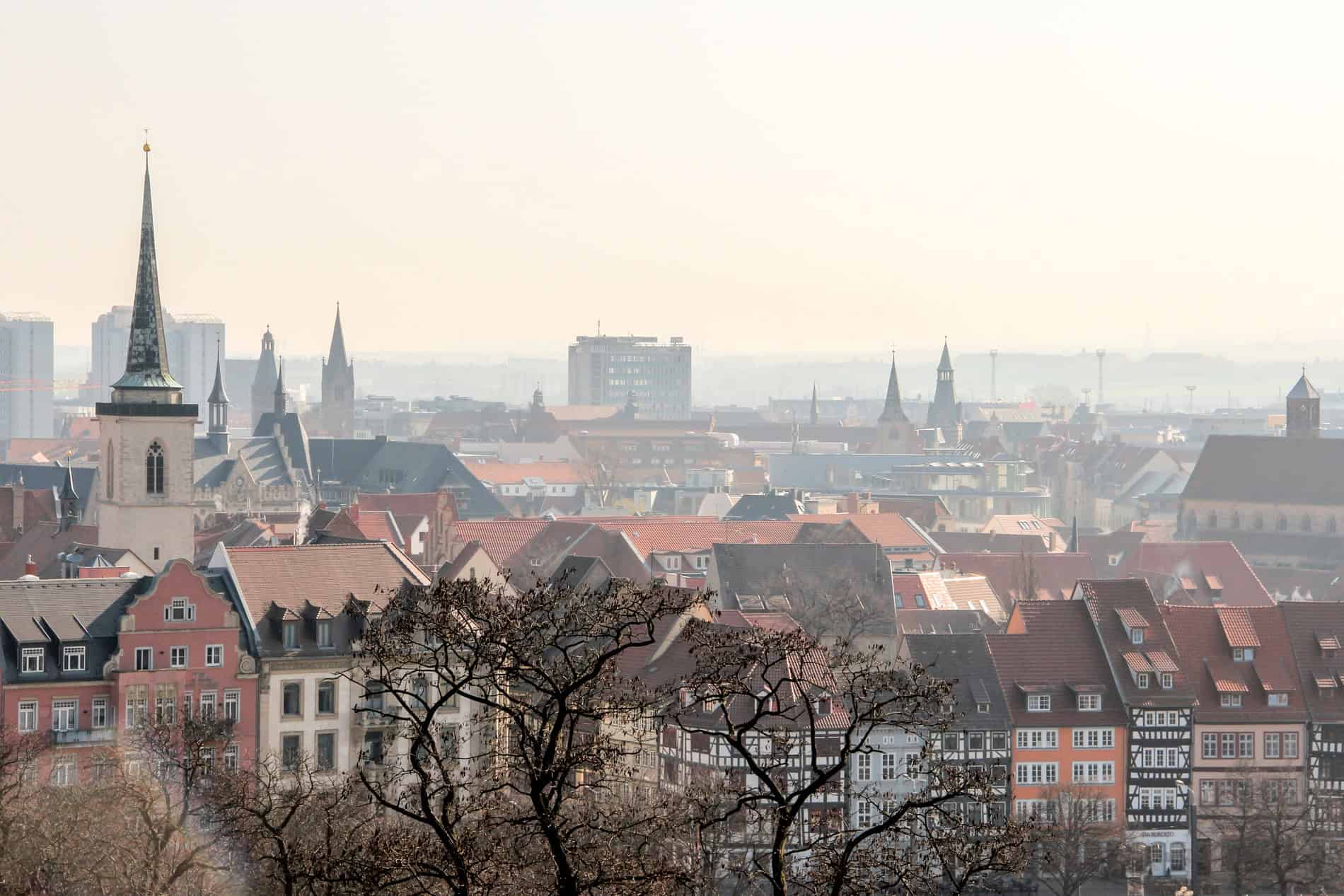
Cultural Travel , Germany
Things to do in Erfurt, Germany – From Socialist Rule to Stunning Restoration
Disclaimer: This post contains affiliate links to handpicked partners, including tours, gear and booking sites. If you click through or buy something via one of them, I may receive a small commission. This is at no extra cost to you and allows this site to keep running.
Here are all the things to do in Erfurt, Germany, which show how the city – dubbed the “picture book of German history” – has regained a stunning restoration after socialist rule.
“Erfurt is such a bright place now, but much of its past isn’t.” This phrase stuck in my mind at the end of my time in Erfurt, Germany. It was in response to my announcement of it as my second favourite German city after Berlin.
On the surface, this restored medieval area is nothing short of what German writer Arnold Zweig describes as “a picture book of German history,” yet it’s easy to forget its darker days when it was a part of the former socialist East Germany.
Passing through, it looks completely untainted; there’s no hint of ‘East Germany’ unless you look hard enough. From its time as a prime European trading route in the Middle Ages, to its cultural and politically rich present following the reunification of Germany, to visit Erfurt means understanding than just its elegant exterior.
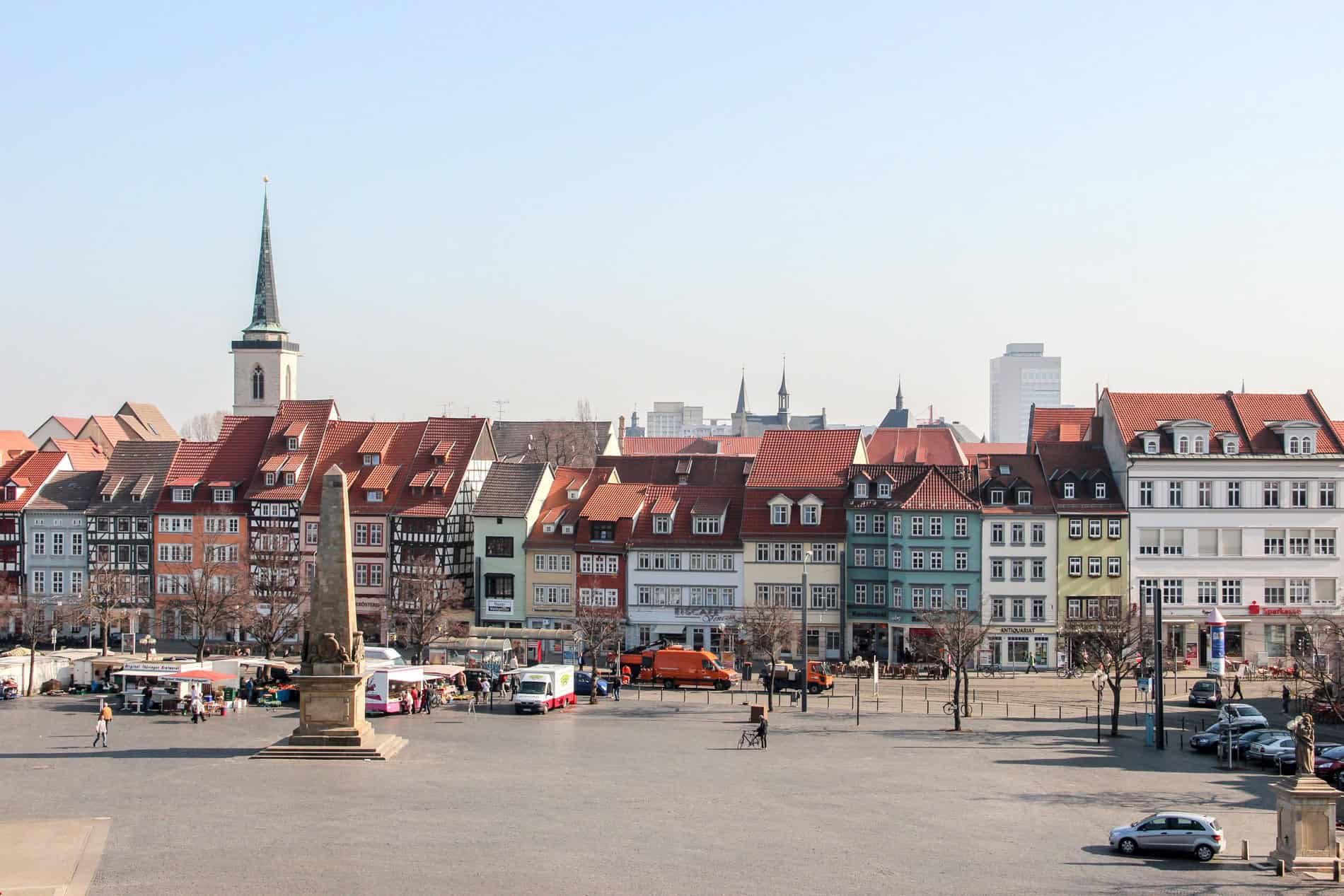
Things to do in Erfurt, Germany – the “picture book of German history”.
Erfurt – Germany’s Biggest Single Preservation Area
The 1270-year-old history of Erfurt lives on in its cobbled streets and charming restored Renaissance buildings. A city perched within the green heart of Germany, everywhere you look is picturesque, living up to its name of ‘Thuringia’s Rome’.
Culturally, it shines, having been home to artists and intellectuals, including Bach and church reformist Martin Luther, who paved the way for its rich heritage and artistic vibrancy. It’s an incredible space to wander around – compact, easily navigable, and mostly pedestrianised. Different architectural designs and colours stand perfectly aligned on every corner, side street, and winding alley; its long-established history is preserved while sitting side by side with sporadic modern additions.
Erfurt survived much of the Second World War untouched, yet its buildings were left to decay during its East Germany days. The Soviets had little money to bulldoze and rebuild here in their distinct style.
Erfurt was occupied, but it was never destroyed
With the fall of the Berlin Wall, the city was lovingly restored, able to retain its old history without the lingering Cold War reminders of Russian architecture.
From the Cathedral and Church of St Severus, the Old Synagogue, and the cobblestone street of 32 half-timbered buildings of the Merchants’ Bridge (Krämerbrücke Bridge) to the boutique shops, street cafes, and riverside hangouts, Erfurt mixes medieval splendour with metropolitan sheen.
You can wander the boutiques, galleries, and medieval craft workshops on the bridge before enjoying a drink in one of the beer gardens behind it; get lost in the tiny streets before lounging in a café on one of the more modern thoroughfares.
BOOK: A 90-minute walking tour of Erfurt Old Town and visit the historical highlights with a local.
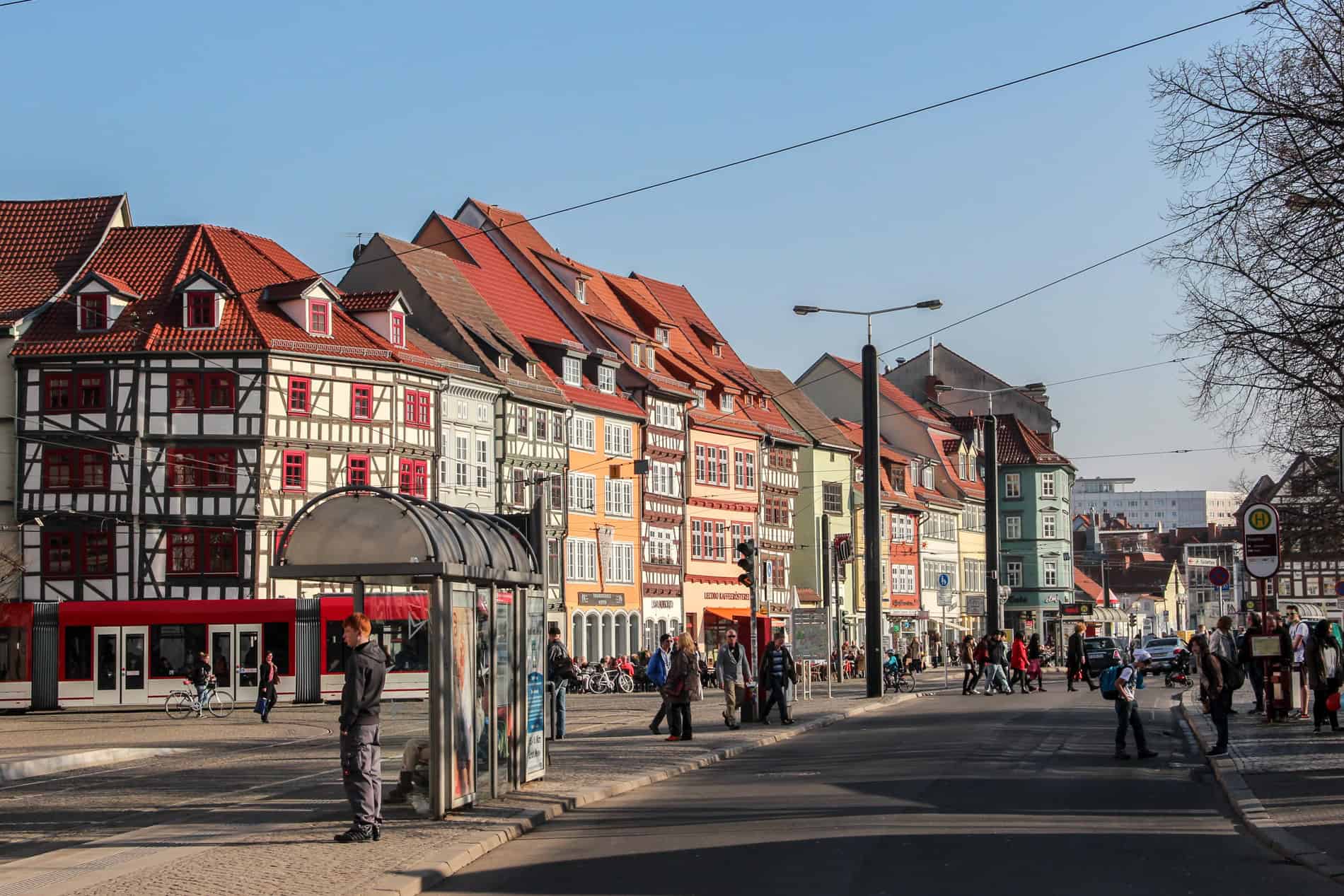
Erfurt’s restored Renaissance buildings.
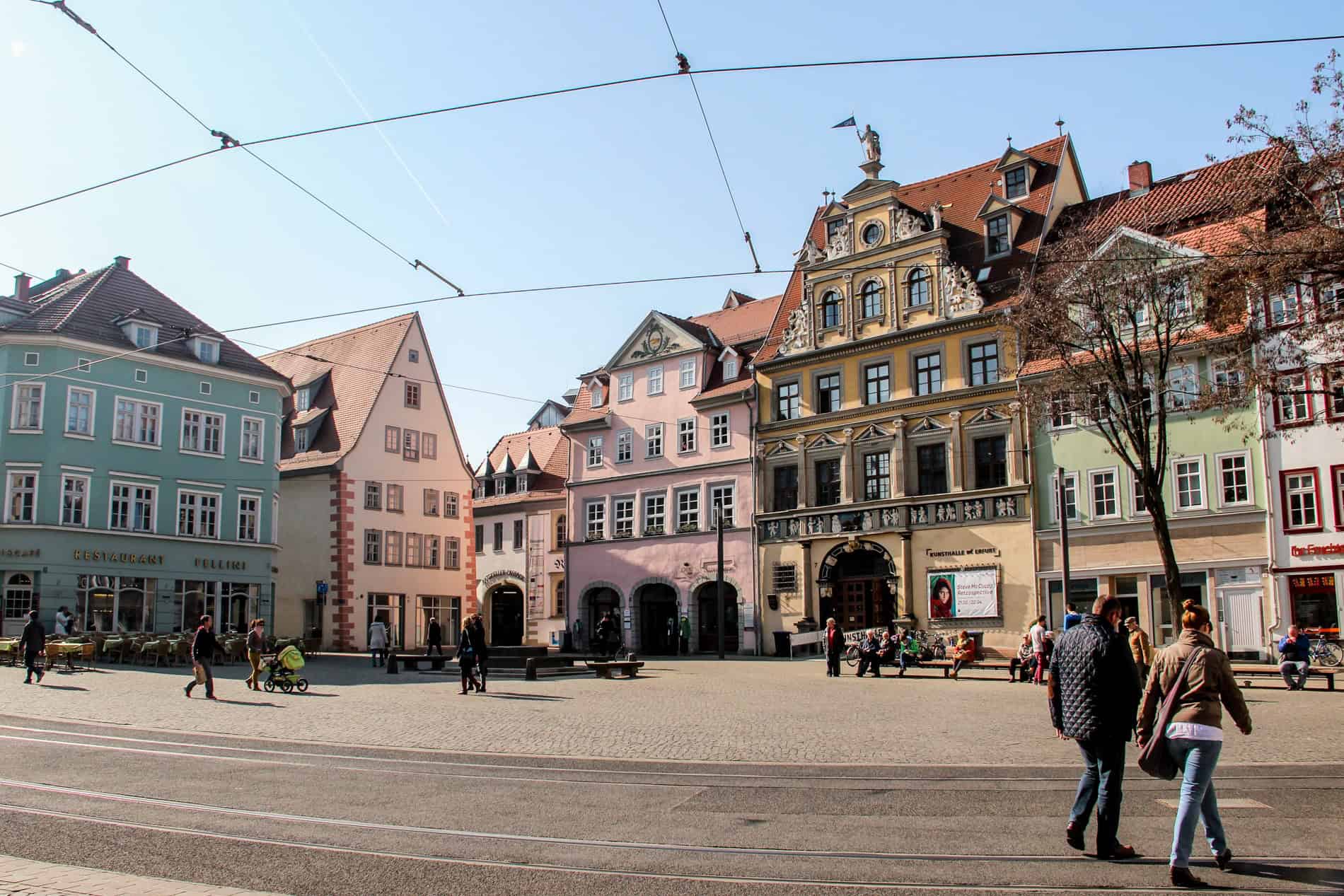
Fischmarkt Square, Erfurt.
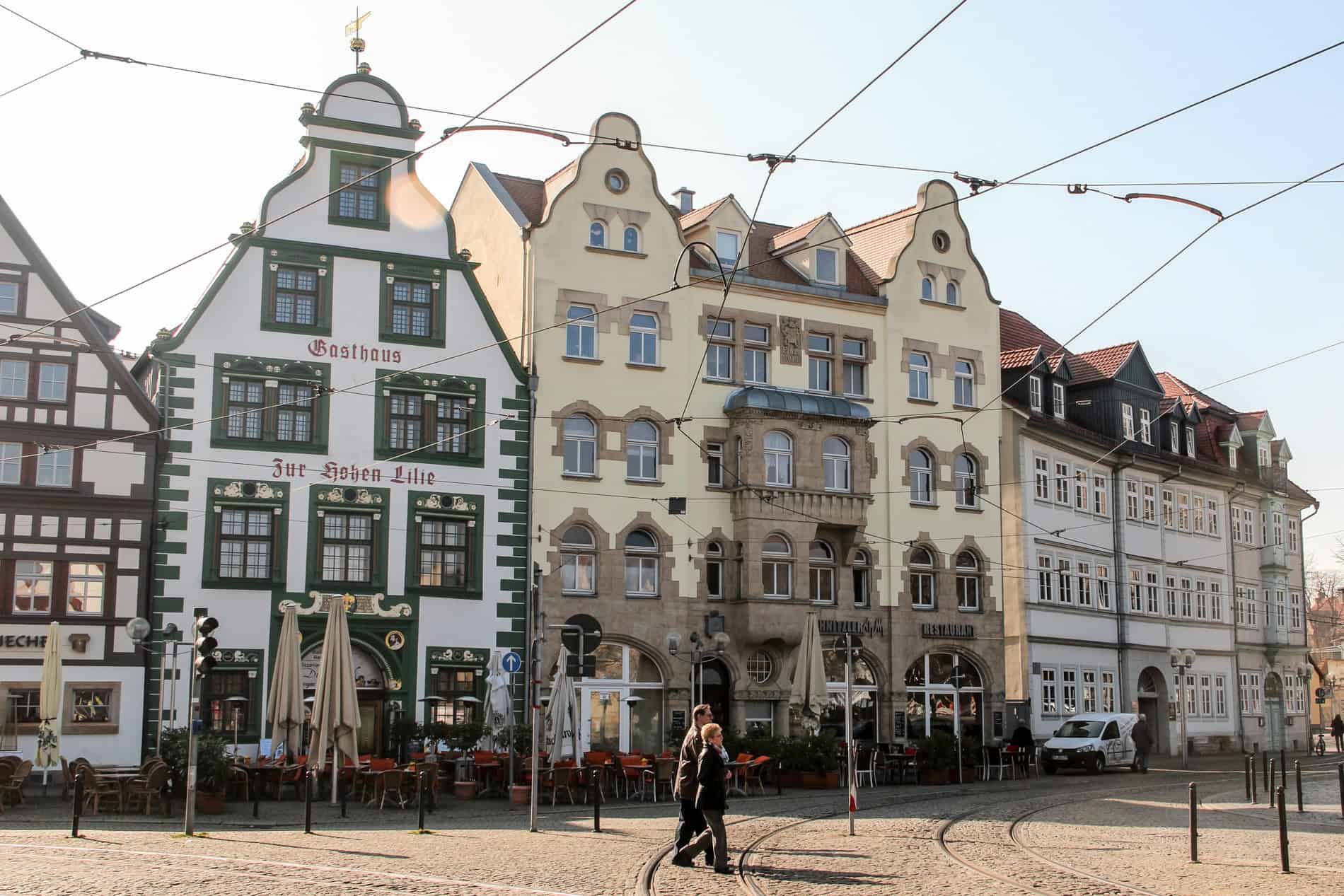
Domplatz architecture, Erfurt old town.
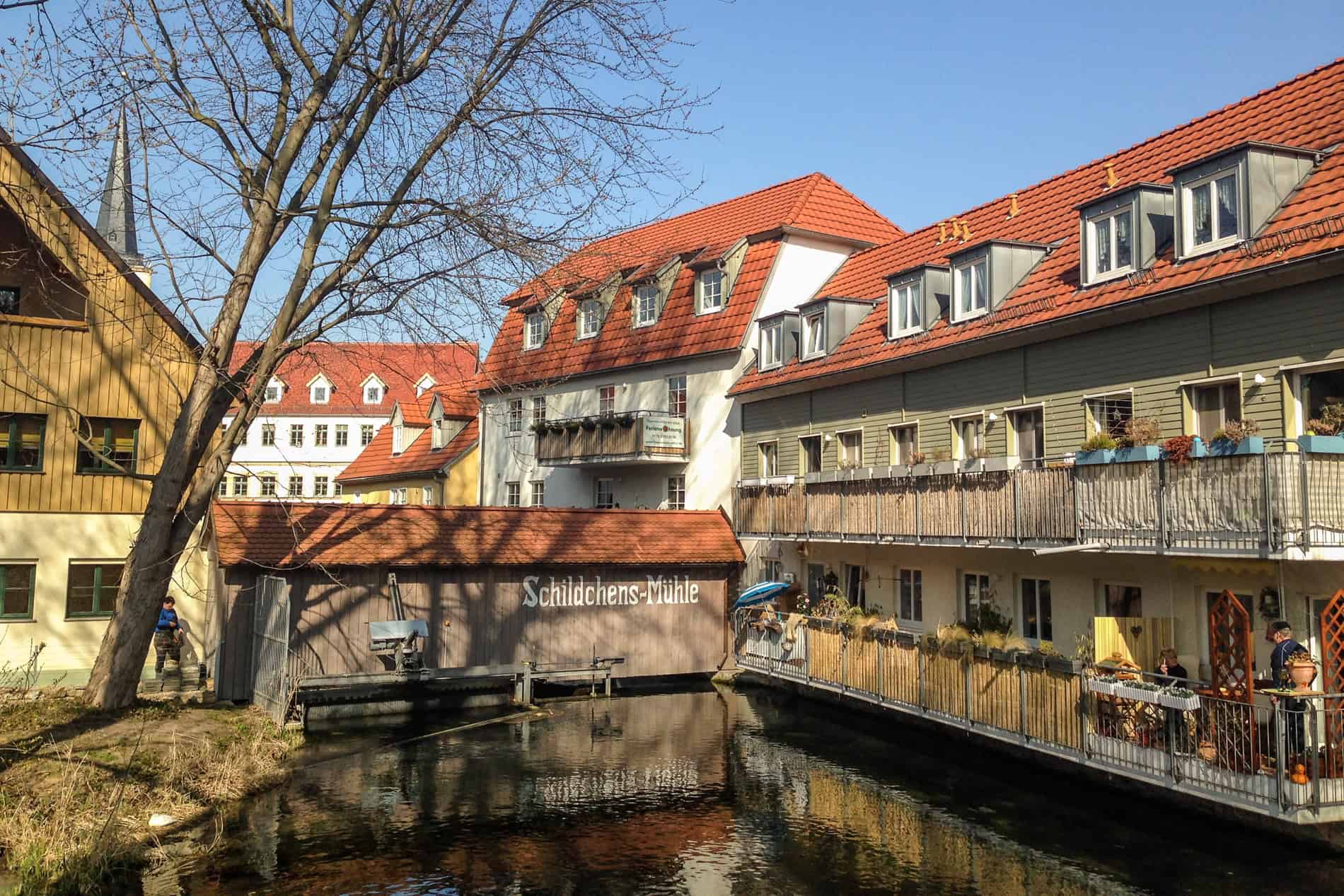
Krämerbrücke (Merchant’s Bridge), a landmark of Erfurt city.
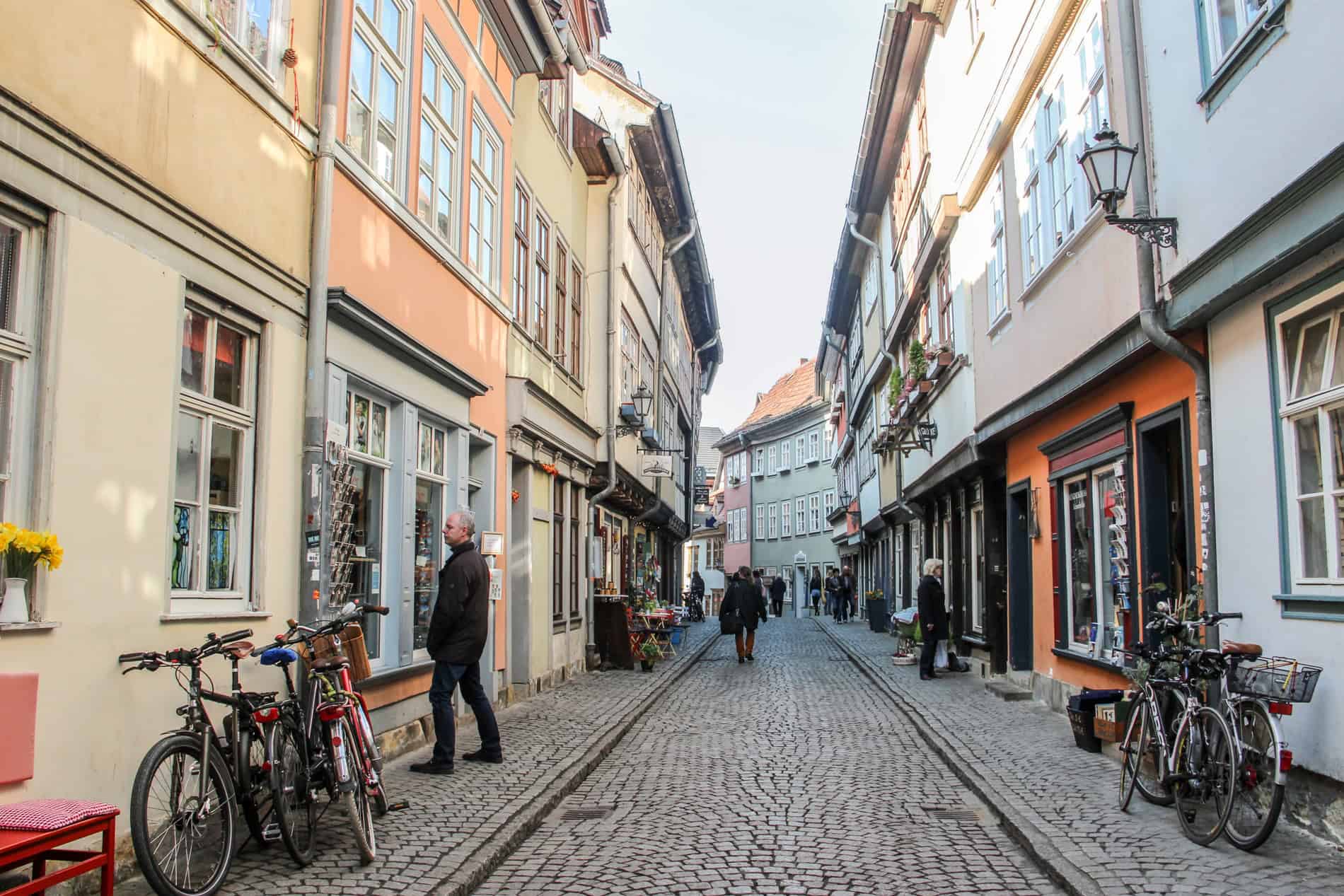
A cobbled street of galleries and shops on the Krämerbrücke.
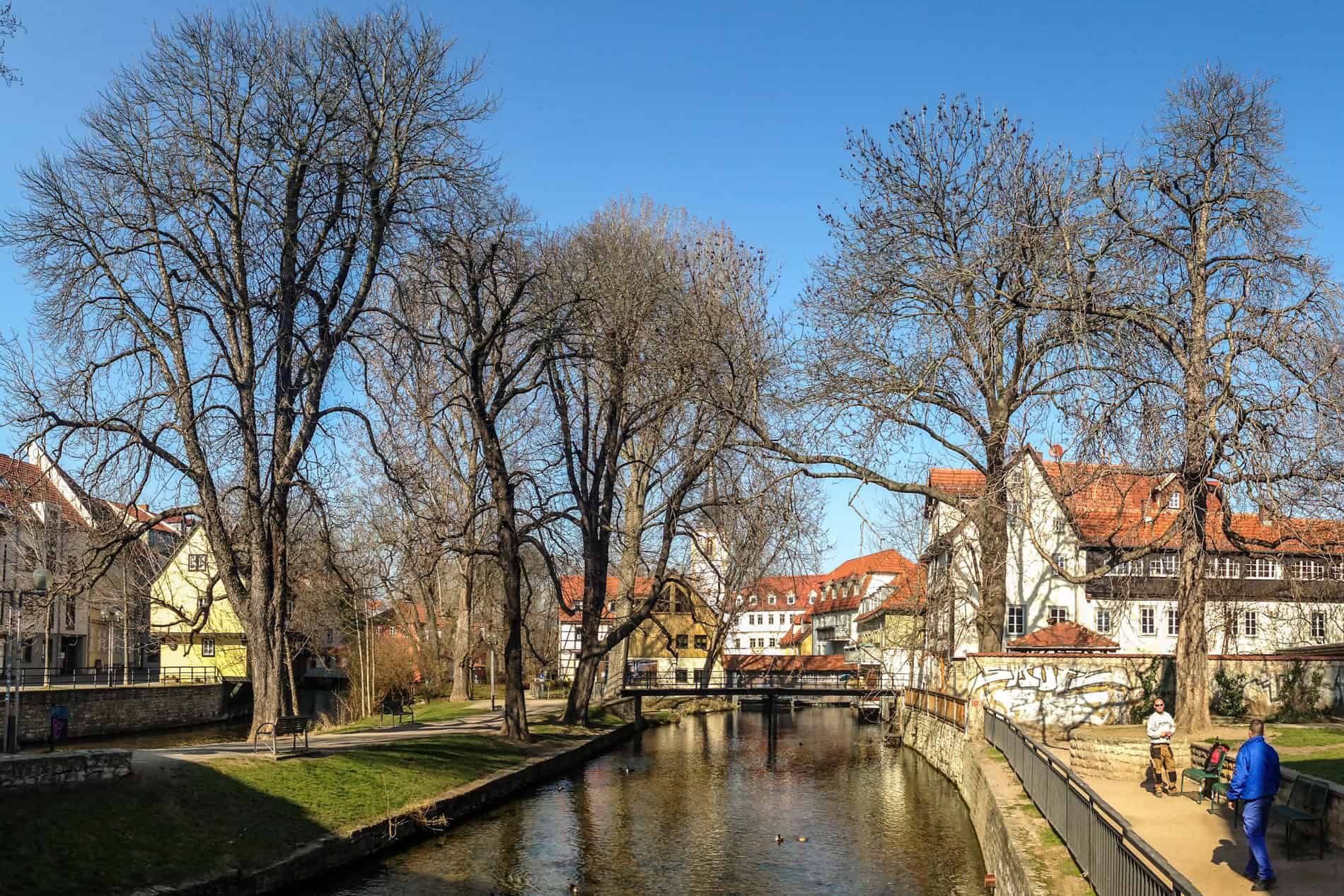
River Gera waterfront in Erfurt.
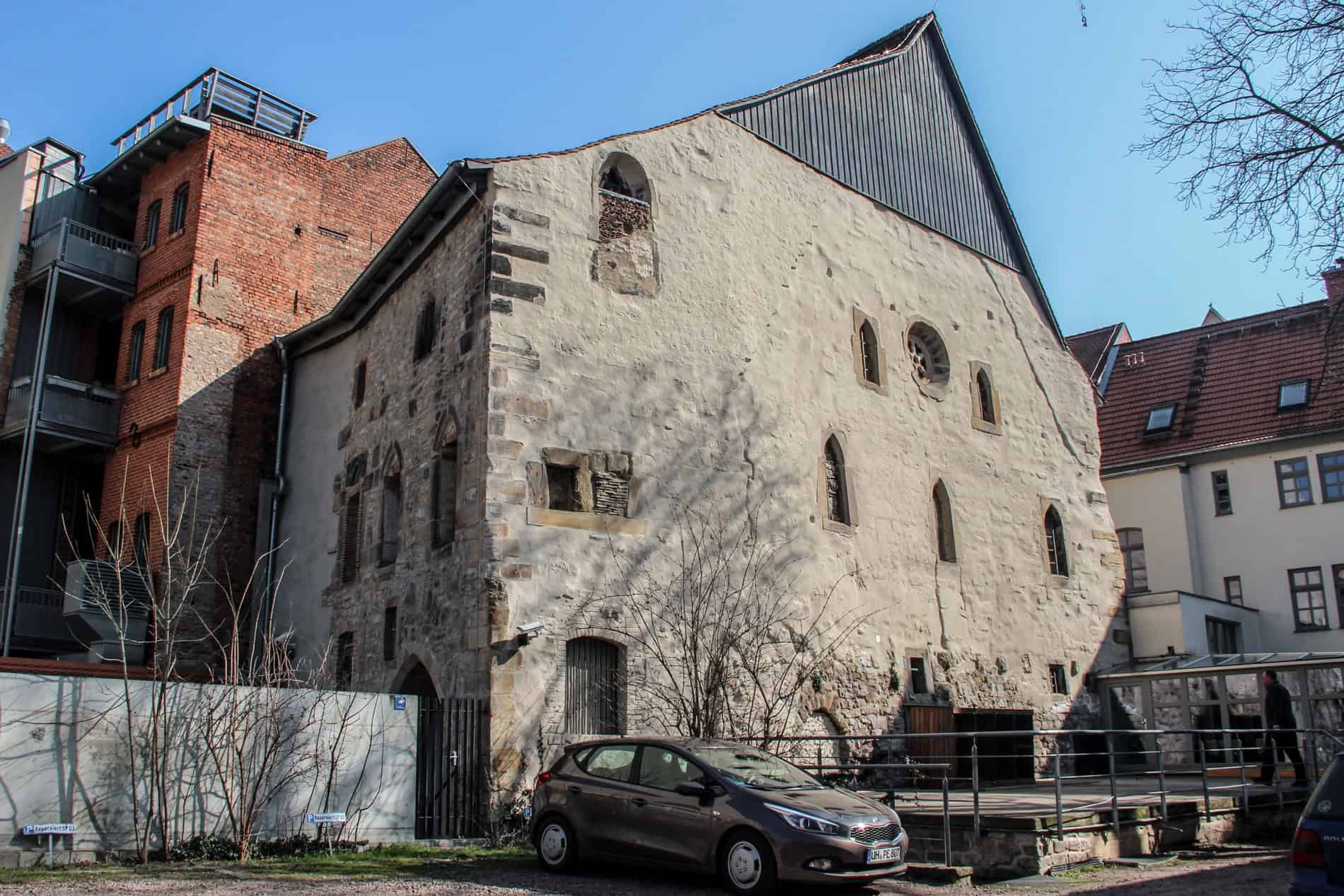
Die Alte Synagogue (Old Synagogue), from the first Jewish community in Erfurt.
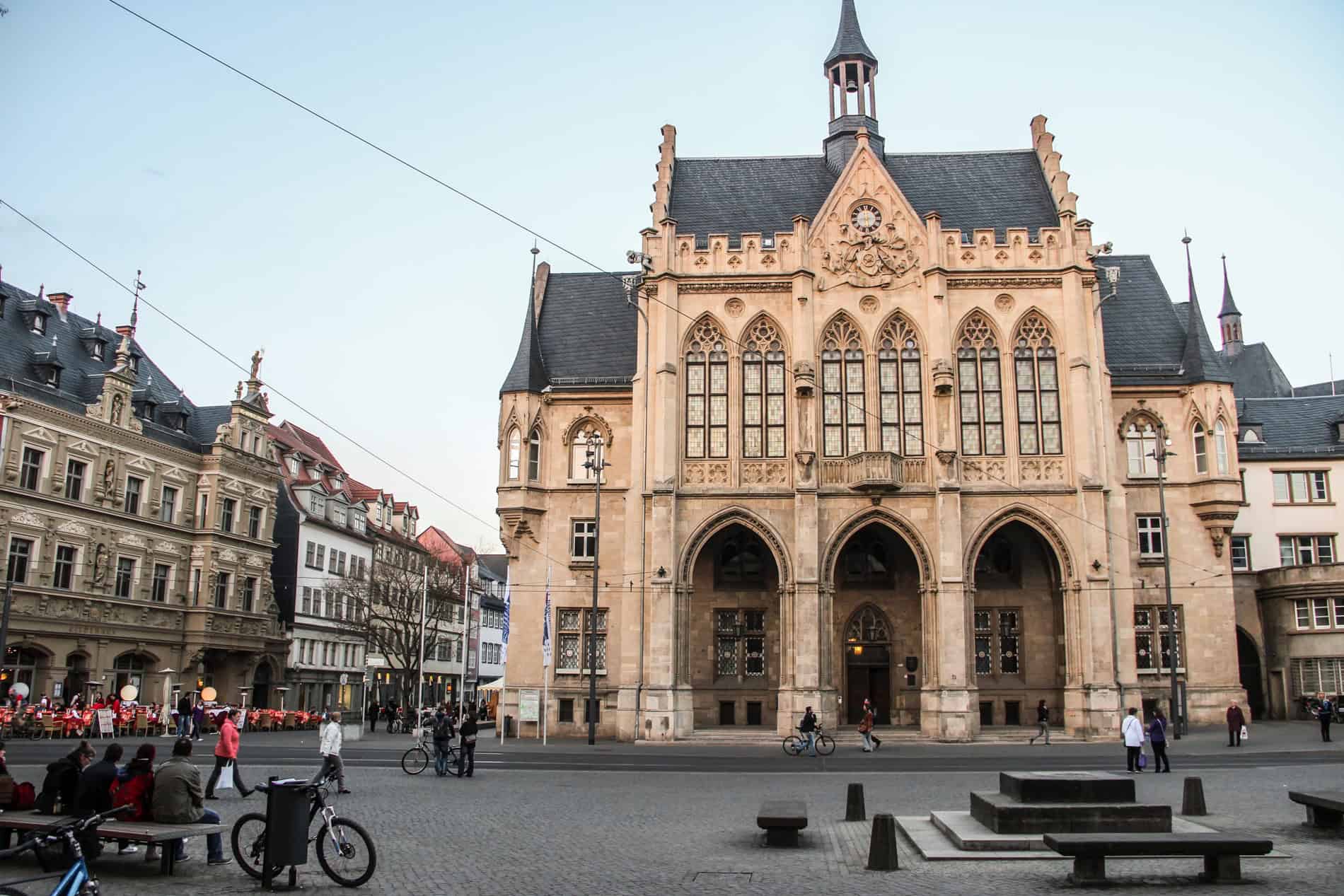
Erfurt neo-Gothic City Hall.
Erfurt’s Cold War History is Not Forgotten
It wasn’t until I visited the fortress Petersberg (Zitadelle Petersberg) and stood high on the famous Cathedral steps down into the Domplatz (Cathedral Square) that Erfurt’s Cold War history became most apparent.
The fortress may provide an incredible view across the city and a mysterious space where you can wander within its tunnel-like passages or take a guided tour with an expert . However, it was also the place where the Nazis executed deserters, and the Soviets later took over as a base for its state security operations.
Today, expensive apartment rentals are part of the area’s conversion, standing next to the building where the Stassi files are now kept (locals can now look up what was documented about them during the time of socialist rule – as is the norm across former East Germany states). Historical tours return it to its former glory.
At the bottom of the hill is the Erfurt-Memorial-and-Educational-Site-Andreasstrasse ( Erfurt Stasi Museum – the site of the former Stasi prison) – a dominating and looming building that is hard to walk past and forget about. If you want a comprehensive historical overview of Erfurt outside of its medieval charm and educational insight into the Cold War and Soviet occupation, then this educational and captivating museum is necessary. It’s chilling, but you leave with a better understanding and appreciation for Erfurt and what it has become today.
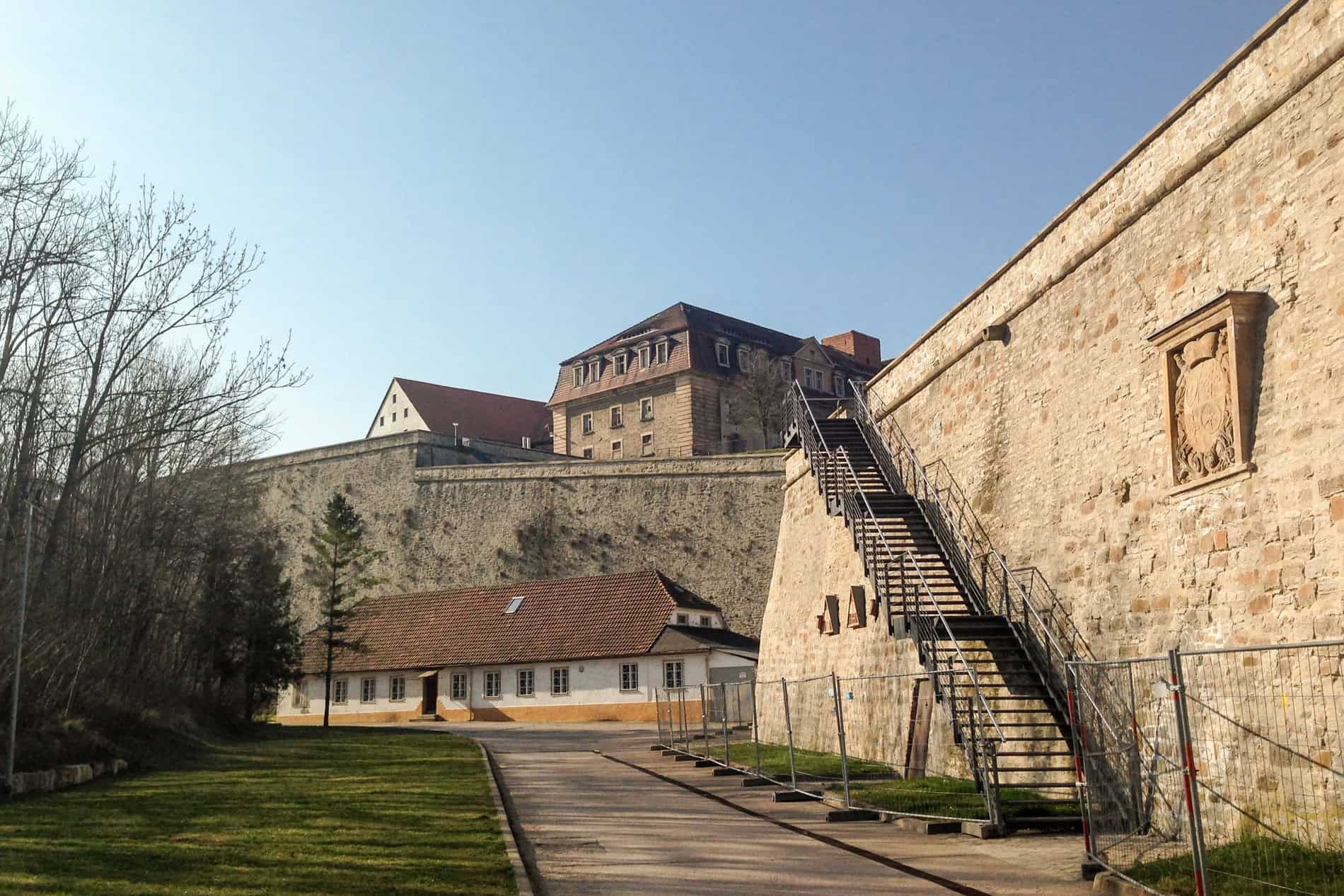
Erfurt’s Zitadelle Petersberg.
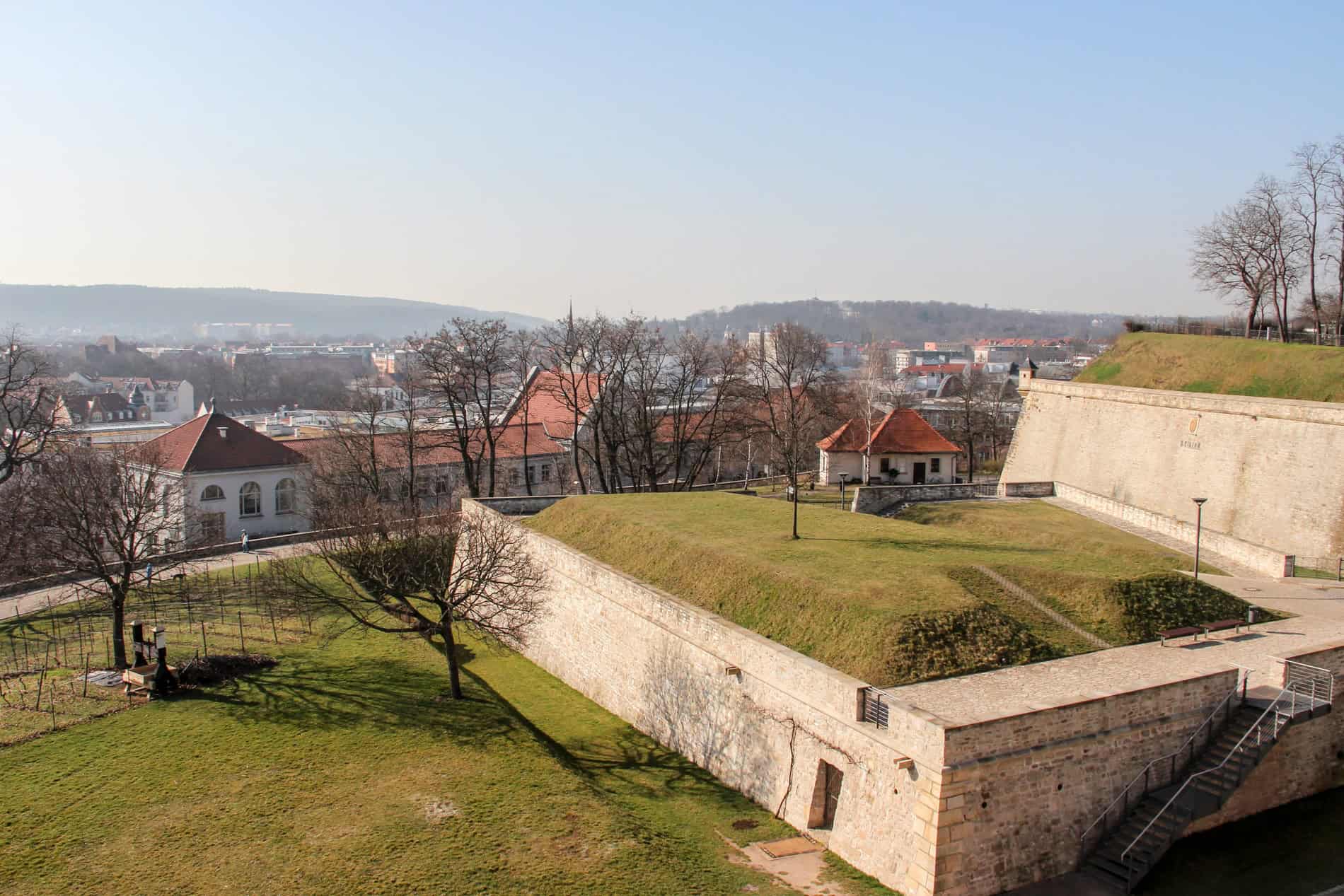
Erfurt city views from the Petersberg fortress.
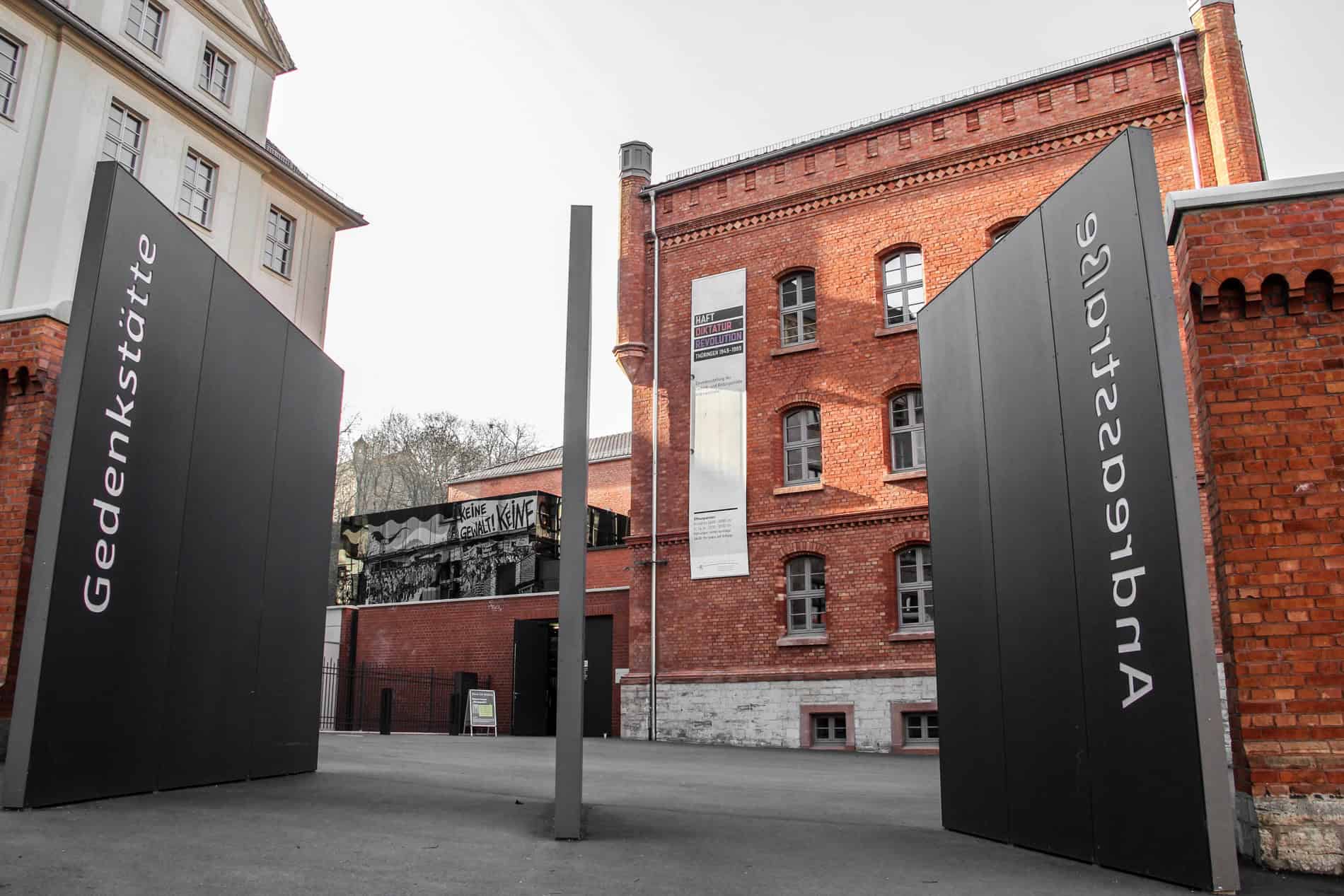
Erfurt Memorial and Educational Site Andreasstrasse (Stassi Museum).
And when you wander down the Cathedral steps, look out into the square. While Leipzig started the ‘Peaceful Protest’ movement, smaller gatherings took place elsewhere, and Erfurt was one of them. Locals rallied to peacefully end division, for the country to be unified, and for the Iron Curtain to be dissolved.
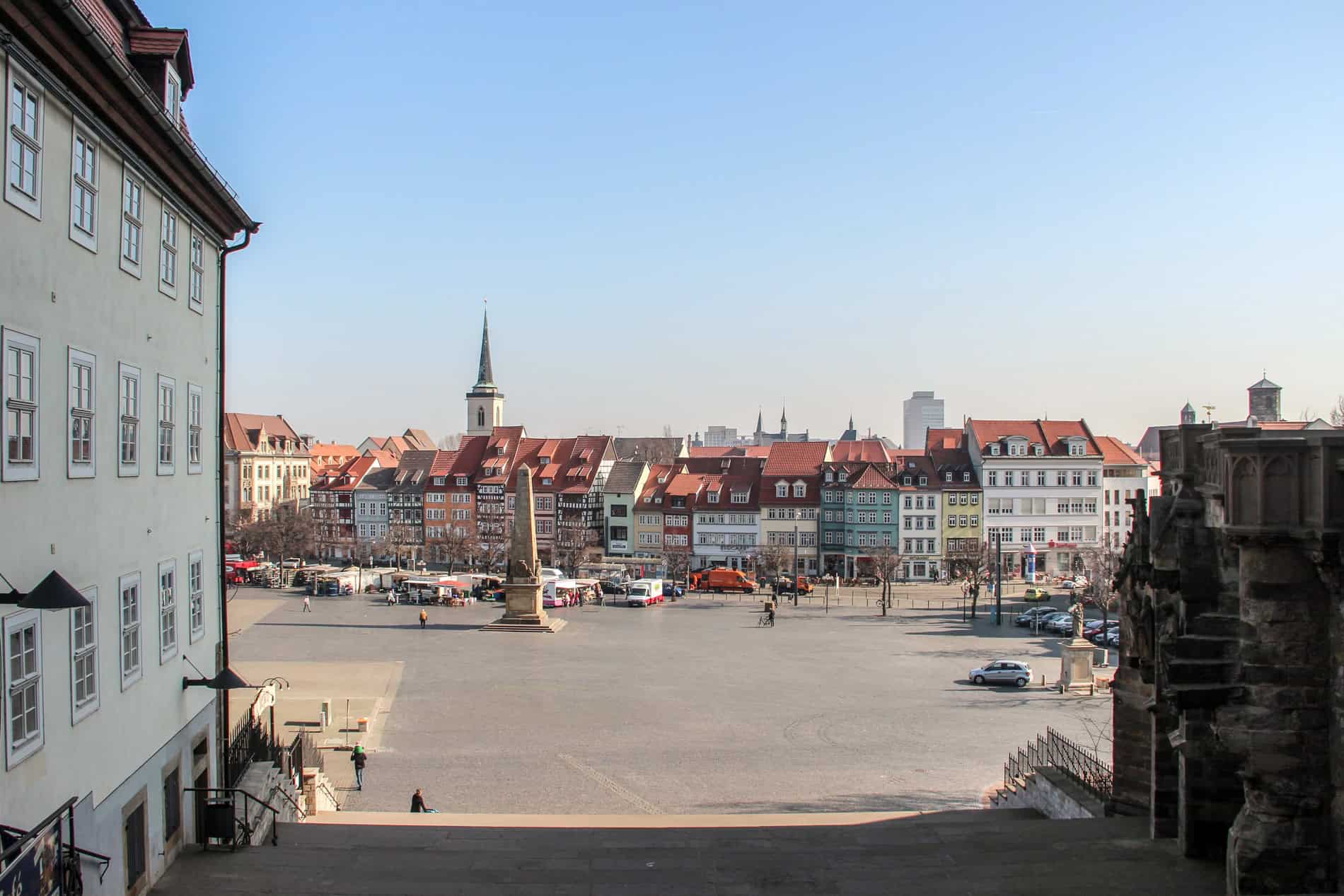
Walking down the steps of Erfurter Dom (Erfurt Cathedral) into Domplatz.
When I posted a ‘then and now’ picture on Facebook, fellow traveller Steve Hänisch posted his memories of this place. At that point, it really hit home how recent this history is and how it affected my generation and my friends.
“As a young person, it wasn’t that bad living here. Thuringia was directly at the border with West Germany, so we couldn’t go any further to visit our family there (even though they could visit us). In reality, I knew of nothing else,” comments Steve on his time living in the area when Erfurt was part of East Germany.
“I was only 7 years old when I took part in the peaceful protests, and for me, it was more like an adventure – I just realised later the role we played in the whole thing. I was shouting the slogans ‘Schwarz-Rot-Gold, Wir sind das Volk’ and have it still in my ear when I’m thinking about it today. I’m glad I now have the freedom to do things my grandparents never had the chance to do – travel the world freely. I feel more aware of how lucky I really am.”
How lucky we are, too, to experience the freedom of a united Germany and to enjoy the long-established history of such beautiful and charming destinations.
We must do so without forgetting the tough pasts that helped shape them into their modern-day brilliance.
Places to Go in Former East Germany
Erfurt was my fourth stop on my ‘Fall of the Wall’ trip to former towns and cities of East Germany. It was a chance to see the modern face of Germany since reunification and how these towns and cities have changed, adapted, and become destinations worth visiting. Why not combine one or more with Erfurt on a historical journey?
- Day Trip to Potsdam from Berlin – How the city neighbouring Berlin reinvented itself.
- How to See Weimar – A cultural hotspot with a complex history.
- What to Do When You Visit Leipzig – A city that stylishly reinvents itself.
- Things to Do in Dresden City – Where old is new and what’s new is old.
This post is in conjunction with the German National Tourist Office and my report on looking at the country after the fall of the Berlin Wall. All opinions remain my own.
About Becki
Becki Enright is a British Travel Press Award-winning writer whose work focuses on changing perceptions about misunderstood aspects of destinations. Her writing combines storytelling with insight into the social, historical, political and economic factors that shape the country or place in relation to tourism. Becki has appeared live on Sky News and CNN and has contributed to high profile media including National Geographic, Time.com, Guardian online, New York Times, Grazia and Buzzfeed.
15 January 2020 at 11:31 am
That’s a nice sum up of Erfurt, historically and in photography. I guess you also walked along the impressive Anger.
30 April 2014 at 4:19 pm
Hear, hear, it amazes when people talk to me about the east and west side of Berlin, I think I am slightly too young to appreciate it. As I don’t remember the wall being torn down. When I visited the city with some other bloggers who were older and had memories of the day, they told me it’s like September 11th, everyone knows where they were when they heard what had happened. Similarly, regarding the Iron Curtain, one of the drivers I had with Busabout this summer has memories of his home being part of a communist country, and told us of his family waiting for their car and when it eventually turned up it was the wrong colour- they never said anything because then they’d have had to wait even longer!
Lauren says
25 April 2014 at 2:37 am
I’m glad that the past is not forgotten because this is the only way we can make sure it doesn’t happen again. Very thoughtful and engaging post. I love your photos!
Jen Seligmann says
23 April 2014 at 8:25 am
I love hearing about stories of change in the world but at the same time, every story of change comes with a story of loss and unspeakable atrocities which makes me sad. It looks like a really pretty town.
23 April 2014 at 12:53 pm
Sadly, I think that’s how much of the world is. Everywhere has it’s own story – we just have to appreciate and celebrate the positives that come from dark pasts…without forgetting.
NZ Muse says
30 April 2014 at 7:26 am
Choosing to celebrate the positives: that is a great way to put it, i must admit toward the end of my RTW trip this was starting to wear me down – realising everywhere I went had a history of oppression or slavery or war, everywhere was built essentially on blood and fighting.
Sofia Rhodes says
23 April 2014 at 7:48 am
I have never been to Germany but, looking at the pictures it is really looking nice and I’ll definitely visit this place. Thanks for the post.
Leave a Reply Cancel reply
Your email address will not be published. Required fields are marked *
- Article Archives
- Work with me
- Privacy Policy


Home » Destinations » Europe » Germany » 15 Fantastic Things to Do in Erfurt, Germany (+ Our Tips)
15 Fantastic Things to Do in Erfurt, Germany (+ Our Tips)
Links in this article may earn us a little money if you book/ order stuff. More here .
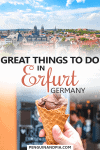
Here Are Some Great Things To Do In Erfurt, Germany!
Looking to add more beautiful places in Germany to your list? Then you should definitely check out Erfurt, Germany!
From beautiful attractions like the Erfurt Cathedral and the Krämerbrücke to exploring Egapark, there is plenty to do, see, and eat!
We were lucky enough to discover Erfurt recently on the way to the south of Germany. We spent a night in the medieval city – and we are SO glad we did.
Because it’s loaded with history, it’s now become one of Eric’s favourite German cities – seriously.
That said, we wanted to check out the things to do as well as things to eat. So, this post is loaded with attractions as well as great Erfurt cafes and Erfurt restaurants to try when you go! Just grab this post and an Erfurt city map – let’s get exploring!
Table of Contents
Top Things To Do In Erfurt
Now that we have covered the basics about Erfurt, here’s a list of things that you can do.
Keep in mind, this list includes most of the major attractions with the exception of the Zoo because we don’t usually promote them.
That said, if you’re travelling with kids, the Thuringian Zoo Park is highly rated and located quite north of the city centre.
Walk the Krämerbrücke
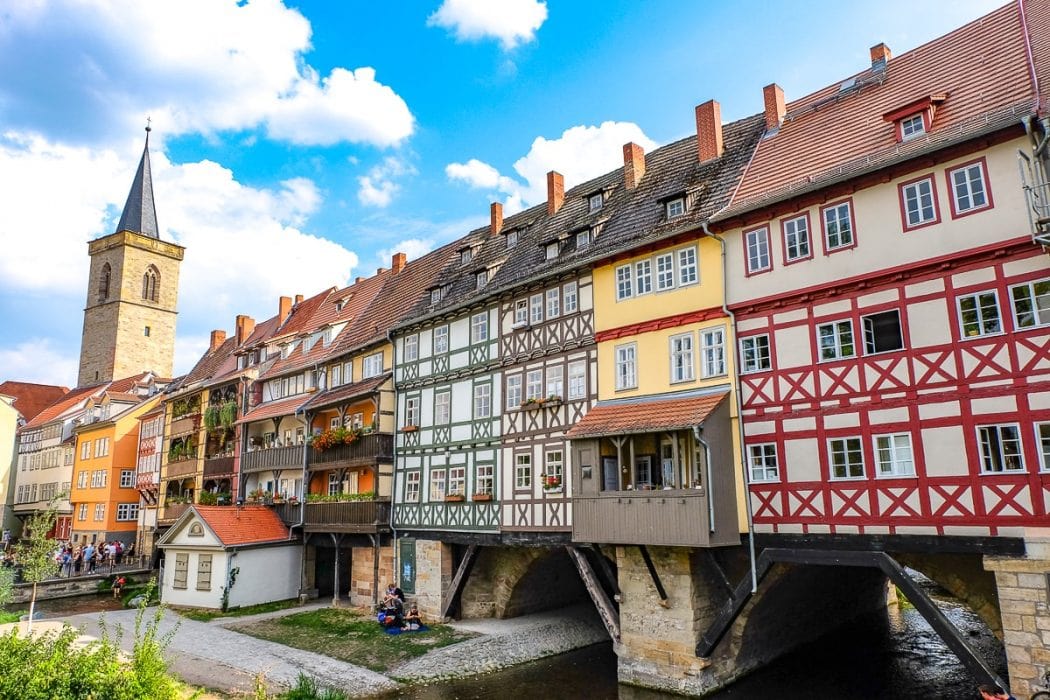
You will not visit Erfurt and miss the Krämerbrücke. You simply cannot!
Also known as the “Merchant’s Bridge”, the Krämerbrücke is a gorgeous medieval-era stone arch bridge that was originally built back in 1325.
In fact, the stone bridge walkway was built first – the wood timber houses were done in the 1480s!
Fun Fact: The bridge is one of the very few remaining medieval bridges with dwellings on it that still stands to this day!
If you walk beside the bridge, you can actually go under it to reach the exterior sides – and you’ll be able to snap some great photos of the side of the bridge next to the river.
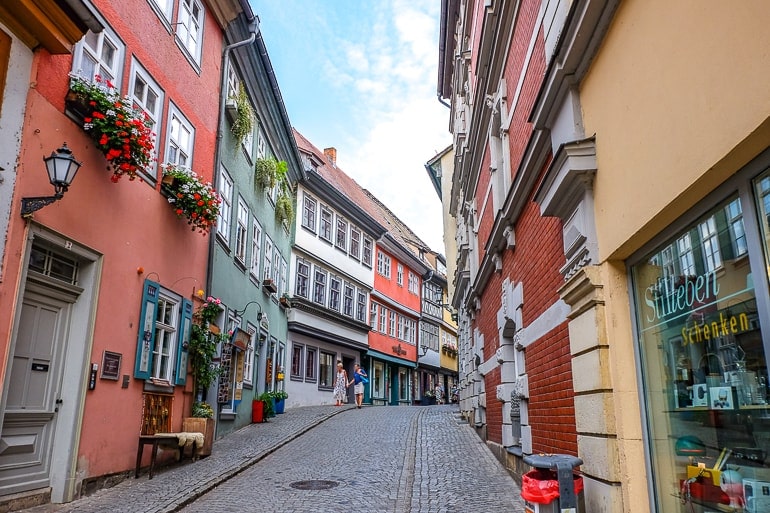
If you walk over the bridge which spans the “Breitstrom” (a part of the Gera River), you’ll be greeted by numerous shops, galleries, or cafes that inhabit the colourful houses today.
It’s also a good way to get between the public squares at each end – each with their own cafes, restaurants, and shops, too.
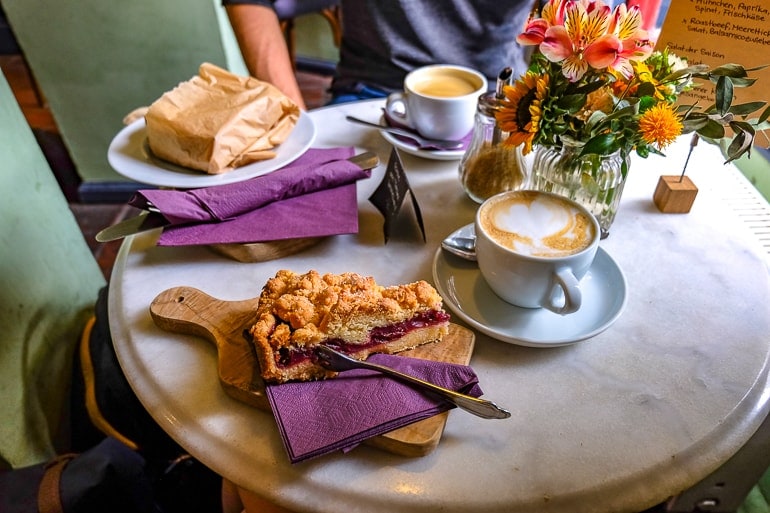
Walking the bridge is like being transported in time – honestly. While we were exploring, we actually popped into a small cafe called Mundlandung.
We had coffees and a cake which were great.
Eric got a sandwich which was okay, but better stick to sweets because Lisa’s cake was absolutely delicious.
The best part was the window view from our table – people seemed a little jealous we were perched up in the bridge!

Another place you can check out on the bridge is the Haus der Stiftungen. This was a small museum (in all German) that is dedicated to telling the story of the bridge.
It’s neat to see but don’t spend all day there – there’s more waiting for you!
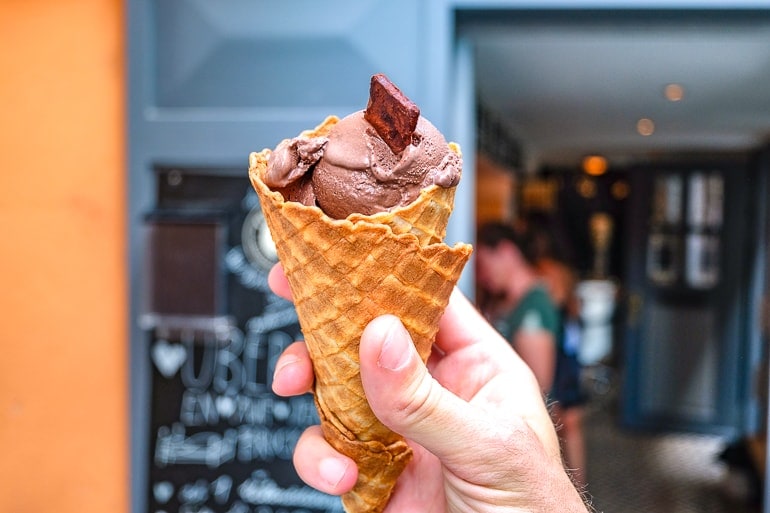
If you approach the bridge from Fischmarkt, you’ll find lots of great things at the other end of the bridge.
Namely – you’ll see a church tower which you can climb (mentioned further down) and you’ll also see ice cream!
Yes, if you’re an ice cream fan you must try some at Goldhelm Eiskrämer . They are located at Krämerbrücke 15, 99084 Erfurt but you’ll likely see a line up if the weather is nice out!
Address of the Bridge: Krämerbrücke, 99084 Erfurt
Wander Fischmarkt
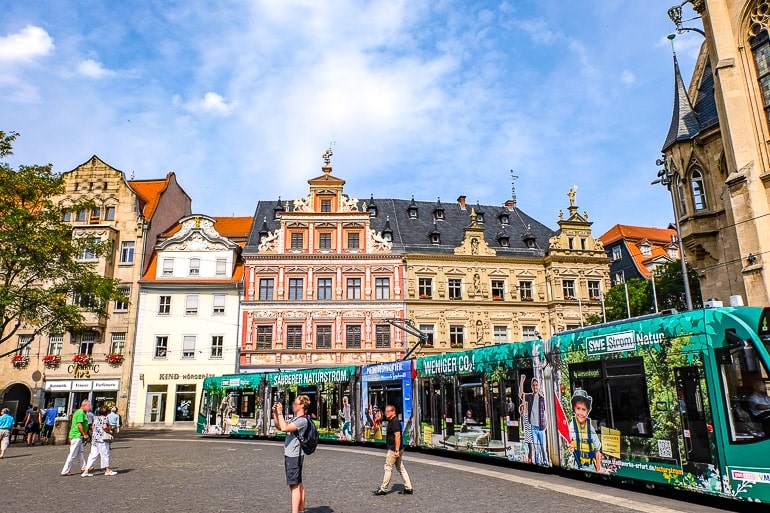
One of the places that you absolutely have to check out – and likely will by accident anyway – is Fischmarkt. This central square is known to be the main square in all of Erfurt.
Always a central meeting place with the town hall right there, the square today is a hustle and bustle of activity – yet still really lovely to hang out in.
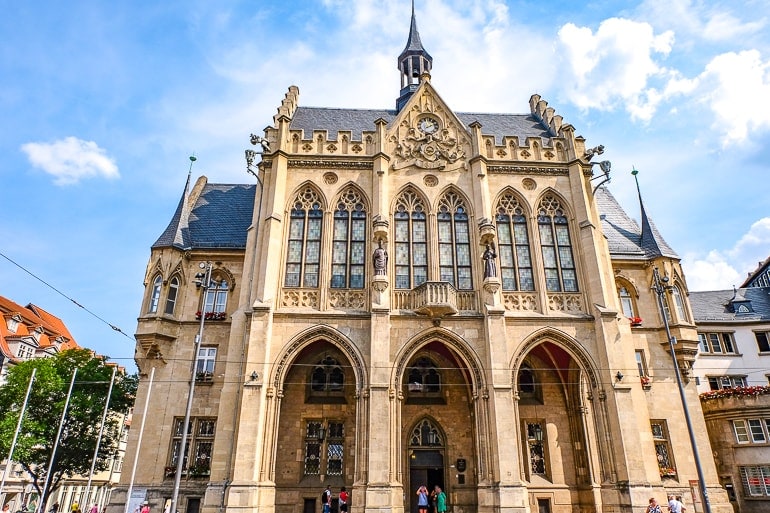
The buildings surrounding the square are gorgeous and built in a Renaissance-style.
The town hall (Rathaus) was built in the 1880s in Neo-Gothic, but the original town hall was said to have stood in the location around 1275!
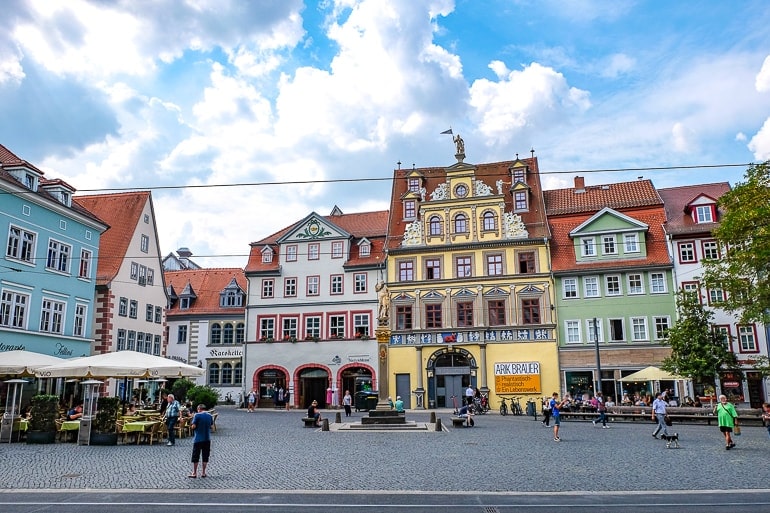
Aside from a transport hub for the trams, you’ll also find “Der Römer” standing in the middle of the square.
A symbol of independence in the city of Erfurt, this statue – similar to Bremen’s Roland – was put up by the town people in 1591.
These days, there are loads of cafes and restaurants around the edges of the square so you can sit and have a nice coffee, snack, or full meal.
We really liked the square because it never got too busy so you got to enjoy a historic centre without loads and loads of people around.
Just watch where you are standing when you snap those pretty photos because the tram will come through!
Address: Fischmarktplatz, Erfurt
Visit The Erfurt Dom (Cathedral)
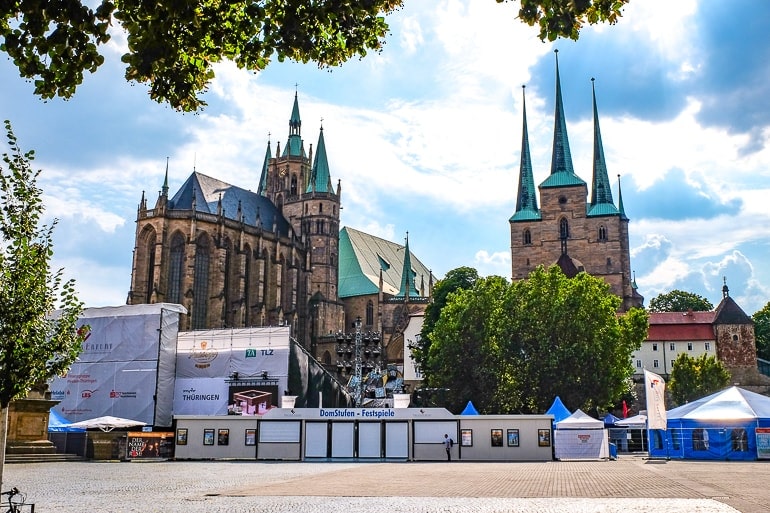
Standing high above the city from the top of Domberg Hill you’ll find one of the top sights in Erfurt: the Erfurt Cathedral.
Also known as the St. Mary’s Cathedral, this unique cathedral is the oldest and largest church in all of Erfurt.
The current building has roots dating from the 12th century but the site has held religious buildings since before 742!
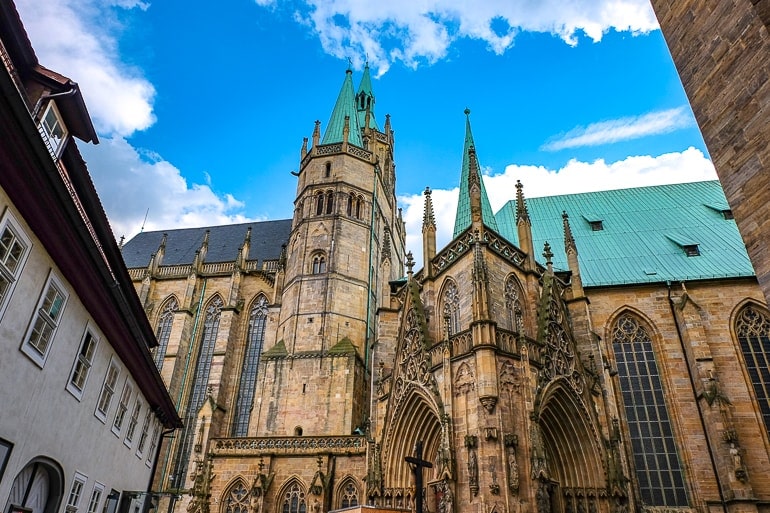
You can find the cathedral right beside St. Severus’ Church (mentioned right below) and there are usually a grand set of steps to walk up between them as you explore the area.
When we visited Erfurt, there was a performance happening so the stage and seating blocked the stairs but it was still great to see.
We walked from the side of the square (also called Domplatz) and entered the cathedral. Admission is free – and the inside is quite grand.
The cathedral has both Romanesque and Gothic elements which make it beautiful.
Fun Fact: The Cathedral is home to “Gloriosa” – the largest medieval bell in the world! You can actually book a guided tour up the central tower to see the bell.
You can learn more about visiting the Cathedral here .
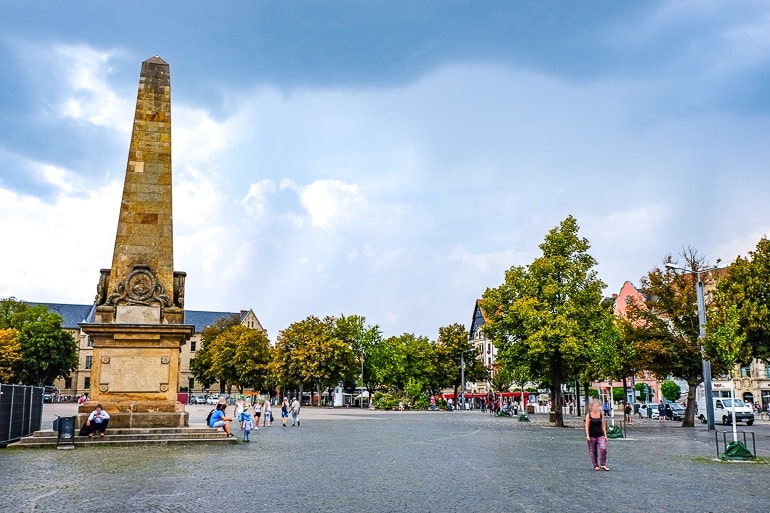
Besides the cathedral, Domplatz is a very large square where you can get a good view of the citadel (mentioned below).
There are also lots of restaurants or cafes lining the square so you can also relax here in the shadow of the grand cathedral!
Address: Domstufen 1, 99084 Erfurt, Germany
Check Out The Churches
If you didn’t already know, Erfurt is home to A LOT of churches, monasteries, places of worship, etc. In fact, the city centre alone has over 20 churches!
These churches dot the skyline with their towers and make for great photos from the high vantage points.
We were lucky enough to check out a handful of the churches for the architecture. There are mostly in Gothic style but you’ll also find Romanesque and more!
You might pass the ruins of the Barfüßerkirche – we did and it was fascinating to see! Below are a few we explored deeper:
Severikirche
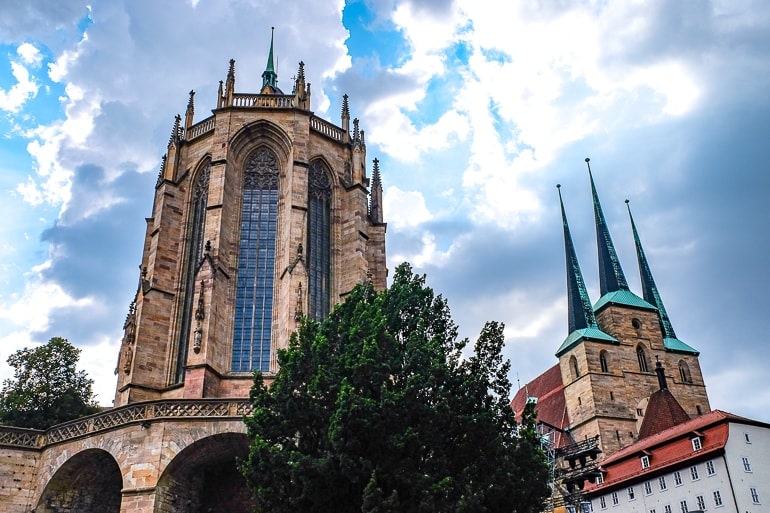
Known as St. Severus’ Church in English, the Severikirche stands right beside the Erfurt Cathedral atop Domberg Hill.
Its three spires are gorgeous – and the second-largest church in Erfurt also makes a statement having been built around 1300.
Address: Severihof 2, 99084 Erfurt, Germany
Predigerkirche
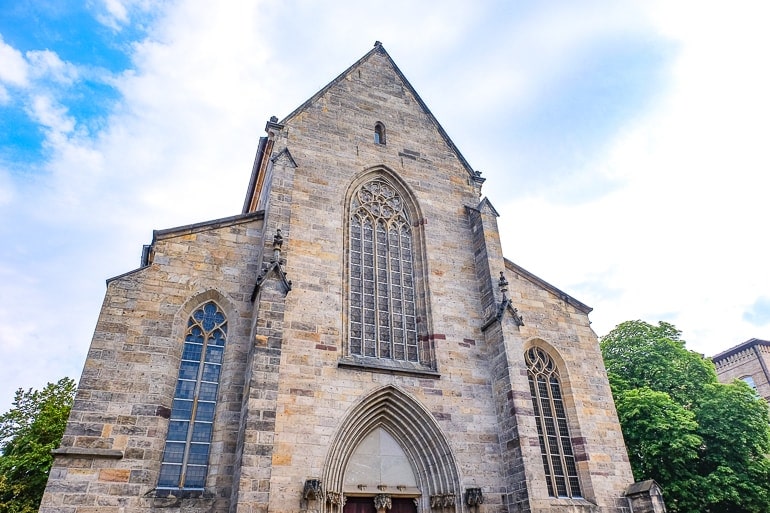
Constructed back in the 13th century, the Predigerkirche is a stone Gothic monastery church.
Located in the city centre, we walked by accidentally and actually stopped to check out its interior. Turns out it’s the main Protestant church of Erfurt!
We wandered inside and honestly it was pretty impressive considering it’s one of the “regular” churches in the city.
The interior was quiet and very simple compared to other wildly-decorated church interiors we had recently seen!
Address: Predigerstraße 4, 99084 Erfurt, Germany
Protestant Augustinian Monastery Erfurt
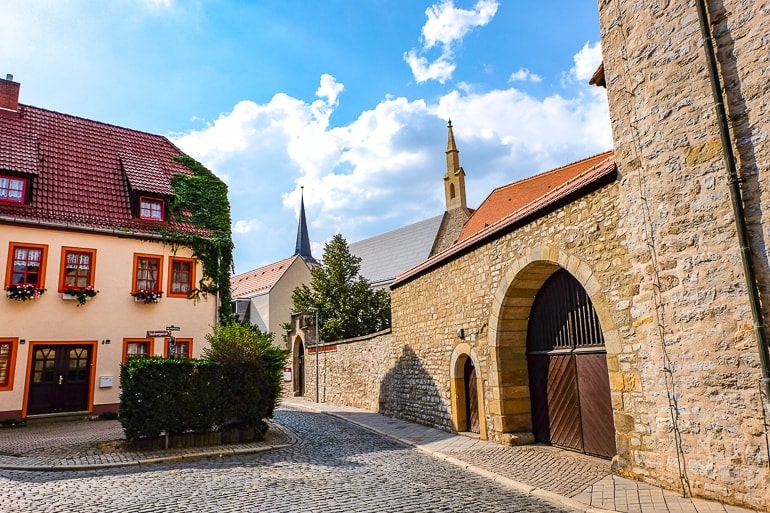
Dating back to 1277, St. Augustine’s Monastery is full of significant history. Martin Luther actually lived there from 1505 to 1511 when he was studying to be a monk.
These days, the large complex is still an active church as well as a conference centre and a lovely hotel you can stay at .
We walked by and stayed very, very close to it at our accommodation just north of the heart of the city centre.
Address: Augustinerstraße 10, 99084 Erfurt, Germany
Climb the Ägidienkirche Tower
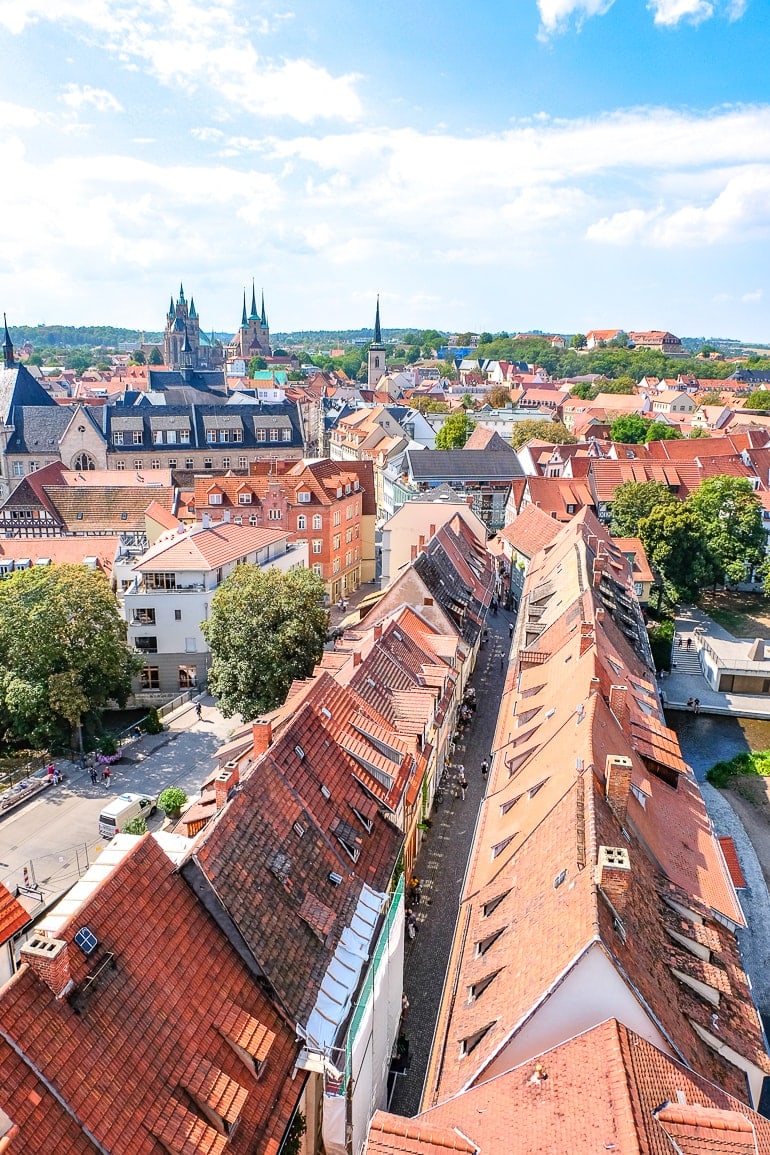
One of the best things to do in Erfurt – and one of our personal favourites – was to climb the Ägidienkirche Tower and enjoy the amazing views!
The tower itself is easy to find – just head for the end of the Krämerbrücke and you’ll see it towering up.
The tricky part for us was the opening times. You enter below through the large wooden door which is in the covered part of the bridge (and under the actual Ägidienkirche – a functional church in the building above the road).
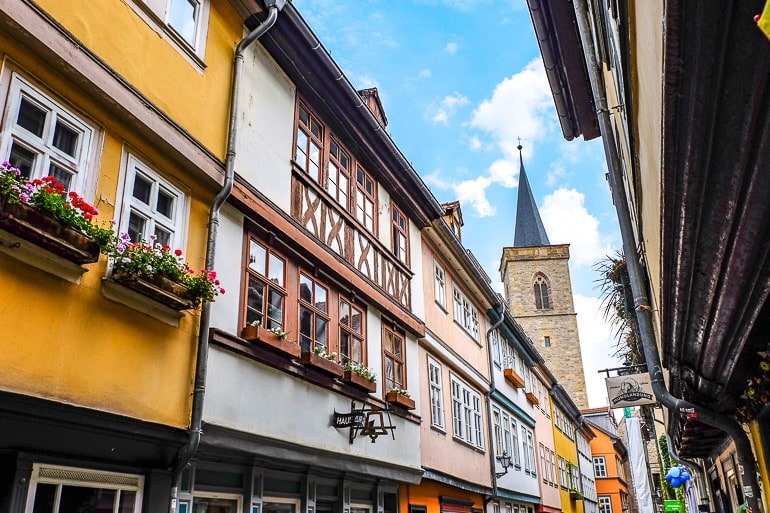
When we arrived for opening at 11:00 am, the door was closed. We waited for over 30 minutes before finally giving up and agreeing to come back later.
This is a shame because we even saw a tour group basically change their plans in real-time because it wasn’t open (when it clearly said it would be – Lisa is German so we didn’t misread).
Luckily, we came back in the afternoon and the door was open. We were asked to give a small donation to enter, and up we went climbing the old wooden stairs.
It’s pretty steep so if you have mobility issues it might not be for you.
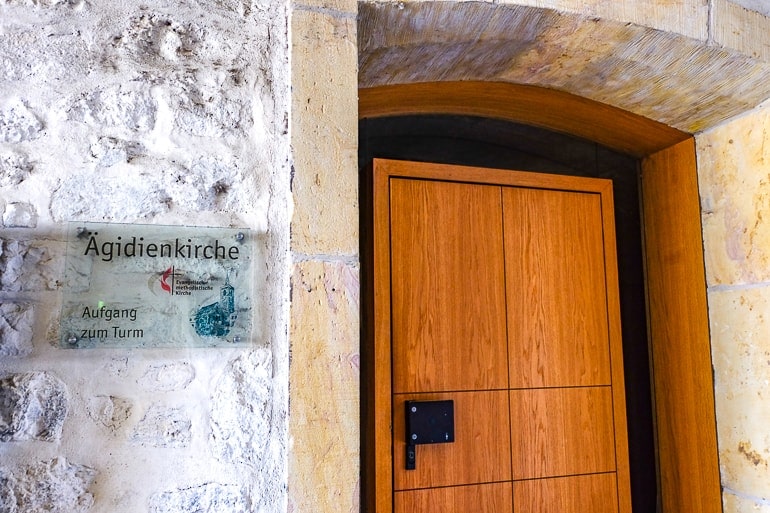
That said, views around the whole tower of the city below are incredible. The photos we got speak for themselves – and it really gives you a unique perspective of the city.
The best part was that there was only one small group up there – then we had the whole lookout for ourselves!
So, we’d say definitely do it – but watch out because it might not be open when it says it should be.
We aren’t sure if this is a staffing issue – we’d read other Google reviews that said (another time) the opening time wasn’t observed – so plan ahead if you can.
Address: Wenigemarkt 4, 99084 Erfurt, Germany (at the end of the Krämerbrücke)
Explore the Petersberg Citadel
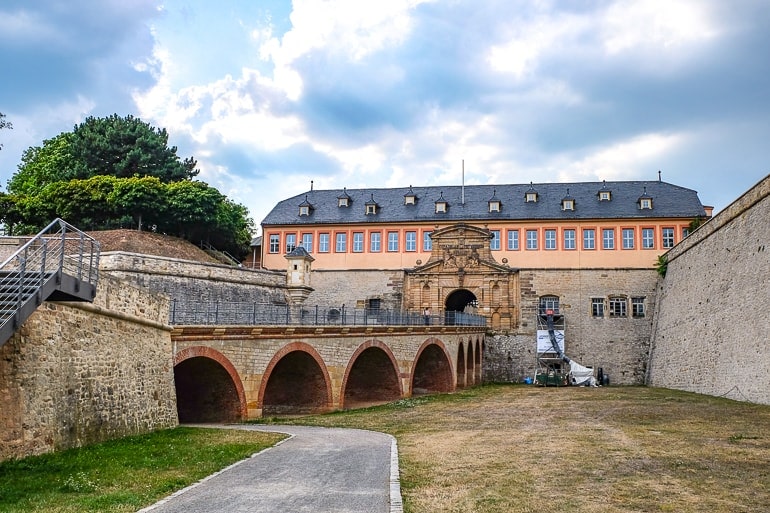
If you haven’t had enough of the great views all over Erfurt, then head to the top of Petersberg Hill for another! At the top, you’ll be greeted by an imposing fortress – Petersberg Citadel!
Built starting around 1665 and for the next few decades, this Baroque fortress is actually one of the best-preserved town fortresses in all of Europe!
These days, you can wander the grounds (more than 85 acres) that are surrounded by thick stone walls running for over two kilometres.
There are guided tours of the confusing lower passageways through the system of tunnels.
When we visited, it was under extensive renovation for the Flower Show in 2021 so there was not that much to see. That said, we could still wander about, check out a few places, and get great views of the city below.
There’s also an elevated glass cafe – Glashütte Petersberg – where you can grab a drink or bite to eat overlooking the city!
If you want to visit the Citadel, learn more, and/or book a tour, you can check out this website . (Public tours are only in German – English would have to be booked in advance!)
Address: Petersberg 3, 99084 Erfurt, Germany
Check Out The Alte Synagoge
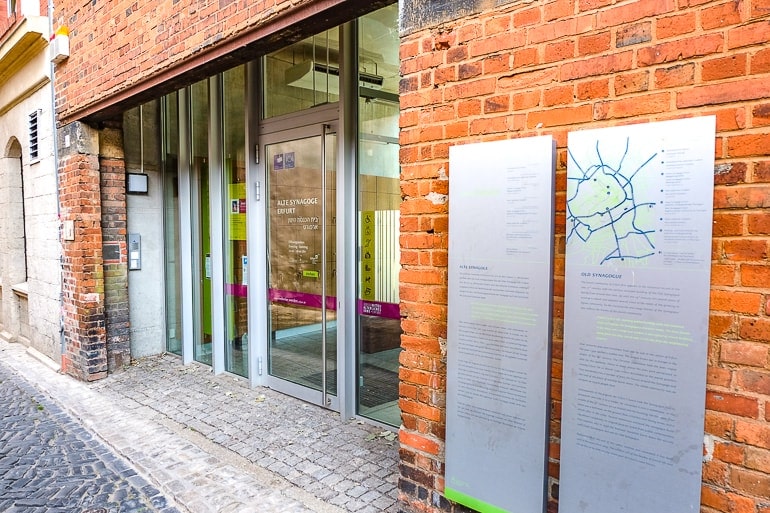
Known as the “Old Synagogue”, this is quite the historic site in Erfurt. In fact, as one of the few remaining medieval synagogues in Europe, it’s a pretty significant place to check out!
Having been originally built in the Middle Ages (as old as the 11th century) in the heart of Erfurt’s old town, much of it was later built around the end of the 1200s.
The Synagogue today includes many of the original features like the thick outer walls and the Gothic Rose window.
You can pop inside for a fee to explore the extensive museum exhibit highlighting elements of the synagogue’s past as well as local Jewish history.
You’ll also find the Erfurt Treasure – a hidden stash of coins and other items found in 1998!
We didn’t end up going inside because we ran out of time but we will be returning and will visit next time! If you plan on visiting the Old Synagogue in Erfurt, you can learn more here .
Address: Waagegasse 8, 99084 Erfurt, Germany
Walk Through Egapark
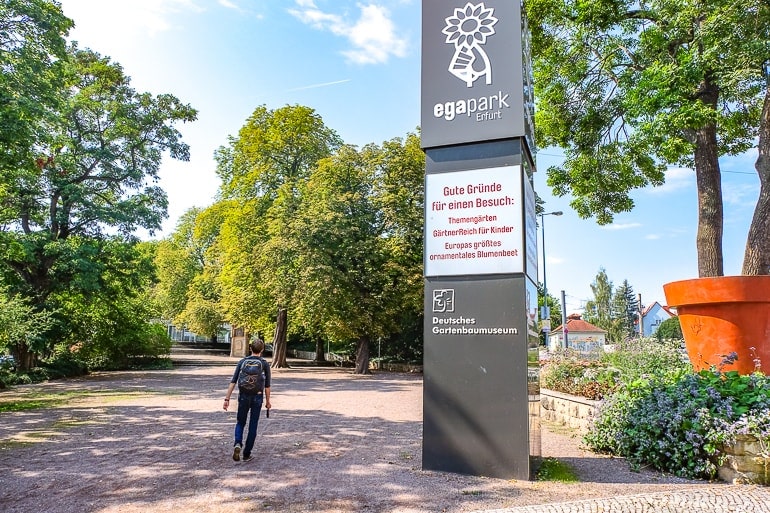
If you want to take a moment to relax while in Erfurt, you should definitely head to Egapark. This massive park – covering almost 90 acres – is one of the largest parks in Germany.
It also remains one of the few remaining gardens set up during the time of East German rule.
The site is of historical significance because an old fortress – Cyriaksburg Castle – rested atop the hill. The park itself was originally opened in 1961 for the First International Horticultural Exhibition (in Soviet Countries) but has since grown and changed over the years.
One feature that remains unchanged is the 6,000 square metre flower bed that centres the park and draws visitors each year.
The grounds are beautiful and have many old buildings like pavilions, glasshouses (for cacti and butterflies) as well as curated rose and Japanese gardens.
As if that wasn’t enough, there are activities for kids and you’ll also find the German Horticultural Museum, which highlights the complex and interesting history of the park!
If you plan to visit Egapark, you can check out the official website here (in German) for fees and opening hours.
Address: Gothaer Str. 38, 99094 Erfurt, Germany
Eat A Thuringia Bratwurst

If you want to sink your teeth into some local cuisine, then you have to try out the Thuringia Bratwurst.
There are many bratwursts (sausages) connected to different cities or parts of Germany – and Erfurt is no different.
The Thuringia Bratwurst is quite long, grilled, and generally eaten in a small roll with mustard.
It’s basically the traditional German equivalent of “fast food” – like how you’d grab a burger or burrito on the go in North America.
We grabbed ours from a small stand near the river where the shopping area in the newer town meets the Old Town. That said, you can find it sold around the city in small stalls or in restaurants.
Note: Lisa thinks the restaurant version is weird because it’s supposed to be a “street food”! In any case, it was really, really good!
Take Photos Of The KiKa TV Characters
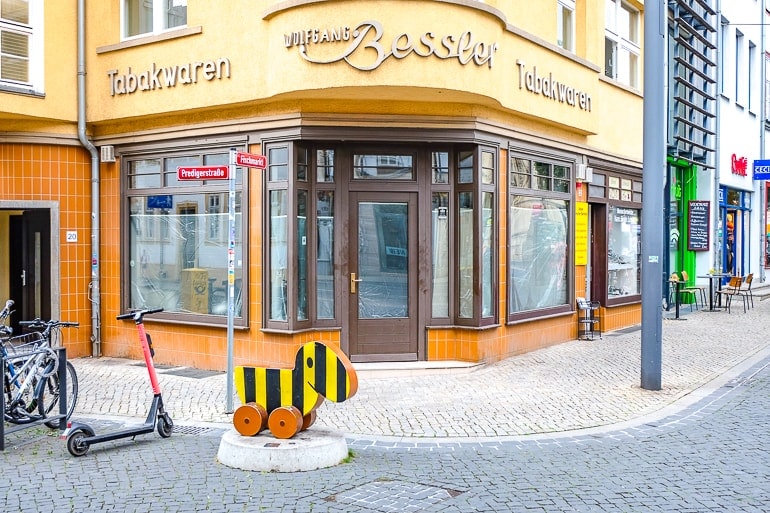
If you are wandering around Erfurt, you might notice a few “statues” that seem a little odd. If you’re a visitor from elsewhere, you’ll be confused and amused – but if you’re German, there’s a good chance you’ll recognize a bunch of them!
Erfurt is home to KiKa – a public television channel for kids. So, it’s only fitting that scattered around the city are recognizable characters from various kid’s shows!
In total, there are 7 characters around the city from Die Maus und Der Elefant to the hilarious looking “Bernd das Brot” (literally, Bernard the Bread).
You can find them scattered around the city – usually in public squares or open spaces so see if you can find all of them!
Explore The Naturkundemuseum
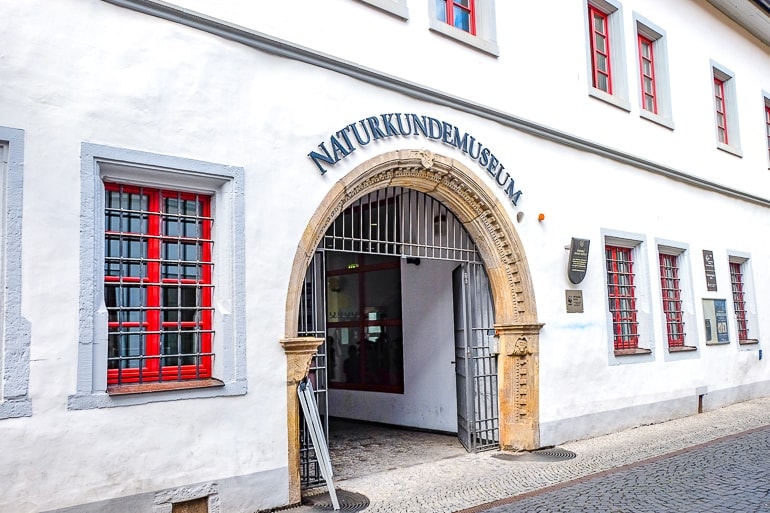
Called the “Natural History Museum of Erfurt”, this museum about the natural world packs a punch! Located down a small street very close to Domplatz, you might miss it if you aren’t looking for it!
Inside, there are exhibits about the natural history of the local area – looking at the history of plant life and geology of the region.
They also hold special exhibits – and have other permanent ones that showcase paleontology, mineralogy, and more!
When we visited, there was a MASSIVE group of what looked like school kids having their lunch in the courtyard. We think they were having a good time visiting the museum!
If you want to check it out, you can learn more about the Museum here .
Address: Große Arche 14, 99084 Erfurt, Germany
Visit The Kunsthalle Erfurt
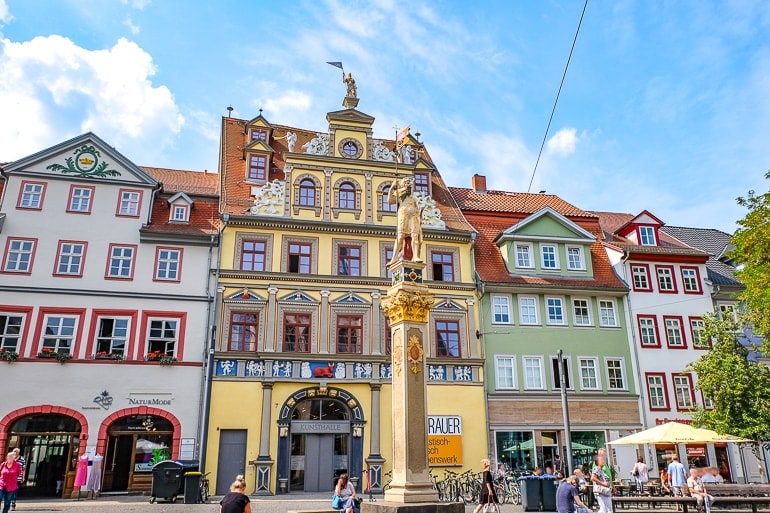
The “Art Gallery of Erfurt” is located right on the edge of Fischmarktplatz facing the Rathaus. This gorgeous Renaissance building called “Haus zum Roten Ochsen” or “House of the Red Ox” is the entrance to the gallery.
Inside, you’ll find permanent and rotating exhibits surrounding the topic of modern and contemporary visual art. For example, they have a recurring exhibit in black and white photos from 1945-2000 in West Germany!
If you want to plan a visit, you can find more information about the Erfurt Kunsthalle here .
Address: Fischmarkt 7, 99084 Erfurt, Germany
Visit the Andreasstraße Memorial and Educational Site
Should you be venturing to Germany (and Erfurt) to learn about the past, this museum is a good place to do that.
The “Stasi Museum” as it’s called, is housed in a former prison used to hold political prisoners in East Germany.
Today, the site is both a memorial and museum with the purpose of educating about and acknowledging the oppressive atrocities that occurred there.
You’ll find exhibits on the lived experiences of prisoners, what the Stasi was really up to, the Peaceful Revolution, and more.
Basically, if you want to learn about “The Stasi” – or the secret police in East Germany during the Cold War period – this is a great place to check out.
It’s located very close to Domplatz so you can take Tram 3, 4, or 6 to get close enough to walk. You can learn more about the museum here .
Address: Andreasstraße 37a, 99084 Erfurt, Germany
Check Out The Angermuseum
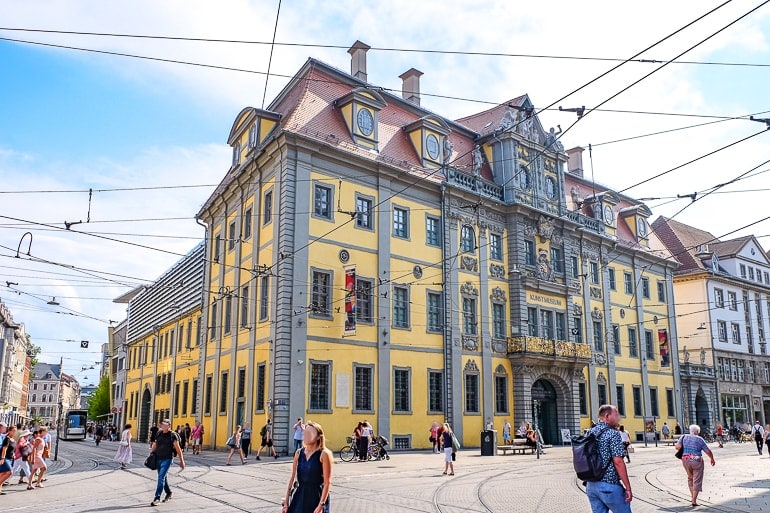
As you pass through the Old Town, you’ll notice a beautiful building at a street corner. Officially opened in 1886, this is the Angermuseum – a place that documents Erfurt’s past! The building faces Anger Square – hence the name.
The building once held the public weighing scales but has since been converted into a museum showcasing shields, medieval paintings, and special exhibits from time to time.
Some people think it’s worth visiting while others see it as a little bit underwhelming.
In any case, the Baroque building is lovely to photograph – and you MIGHT find a KiKa character nearby! You can learn more about the Angermuseum here .
Address: Anger 18, 99084 Erfurt, Germany
Check Out The Museum für Thüringer Volkskunde
Called the “Museum of Thuringian Folklore” in English, this small museum is dedicated to preserving and retelling various parts of Thuringia history told through objects.
As one of the largest Folklore Museums in the country, inside you’ll find costumes, dolls, furniture, and a glimpse of what life was like in Thuringia over the past 200 years!
If this kind of thing sparks your interest, you can learn more about visiting here .
Address: Juri-Gagarin-Ring 140A, 99084 Erfurt, Germany
Where To Eat In Erfurt: Our Tips
While we were in Erfurt, there were a few places that we went for coffee breaks, breakfast, and scouted out for a hearty German meal.
Having covered ice cream, a café and Thuringia sausage above already, you’ll find a list of other great cafes and food spots below.
Café Füchsen
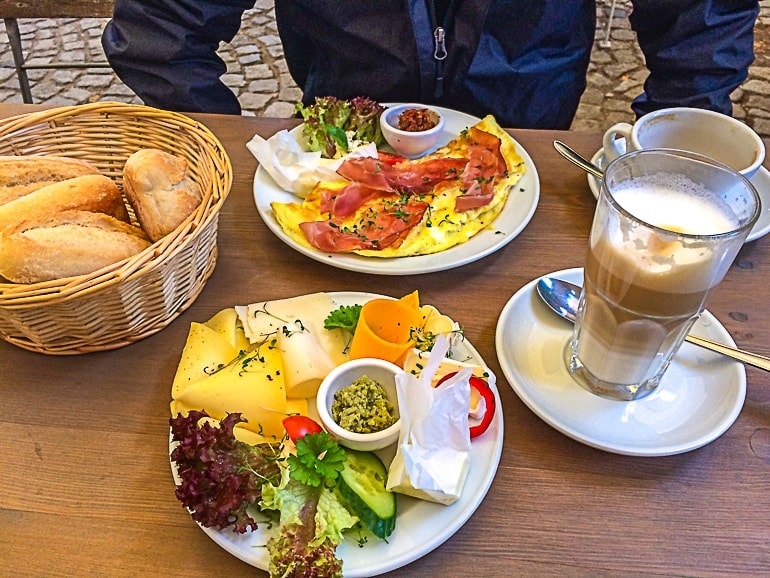
We went to Café Füchsen for breakfast our only morning and it met and exceeded expectations.
The place is this small, cozy spot beside a green park just north of the Krämerbrücke (and it was SO close to our accommodation).
We actually sat outside under a large covered area. Even with the rain, it was a lovely morning. We got coffees and then Lisa had the cheese plate breakfast while Eric had the eggs with prosciutto.
Everything comes with German bread rolls. Let’s just say we were absolutely stuffed before we headed out to explore.
We’d highly recommend – but make a reservation if it’s the weekend or you’re more than two people because we got lucky to find a spot! You can check out their Facebook Page here .
Address Café Füchsen: Hütergasse 13, 99084 Erfurt, Germany
Kurhaus Simone
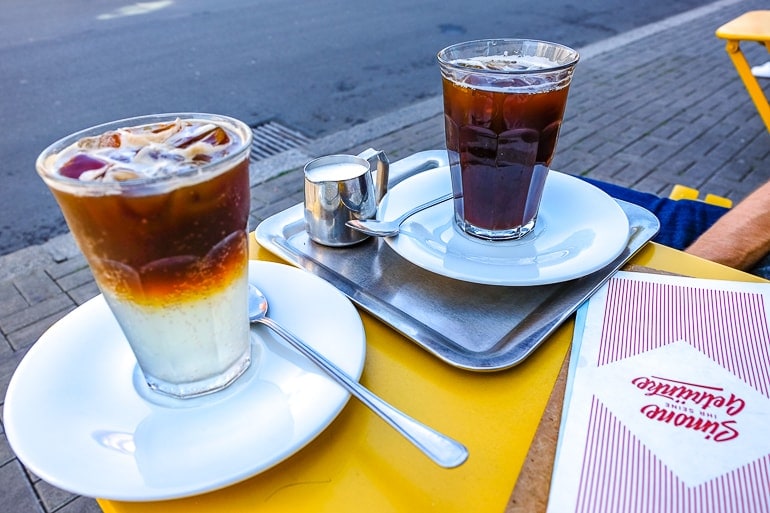
One of the last stops before we got on the train was to find a coffee or iced coffee (it was very hot that day). Luckily, at the far end of the Krämerbrücke on Wenigemarkt (an open square) we found Kurhaus Simone .
Sitting outside at a little table for two, we had the BEST spot to people watch and take in the city views of the tower.
Lisa had this weird cold drink called Caffè Warschau with espresso and lemon bitters (she loved it) while Eric had a tall iced coffee. Both were just perfect. The place is very stylish, too!
Address Kurhaus Simone: Wenigemarkt 21, 99084 Erfurt, Germany
Wirtshaus Christoffel and Gasthaus Feuerkugel
If you are looking for a hearty German dinner (serving a variety of foods from different regions), there are two classic “Wirtshaus” to check out in Erfurt: Wirtshaus Christoffel and Gasthaus Feuerkugel . These places are very popular – but for good reason.
They both offer outdoor seating but also have loads of room inside. Having done the research (and even checking out the menus), we didn’t end up going to either one because we wanted to save one of our big German meals for when we were in Bayreuth (located in Bavaria close to where Lisa grew up!).
Both of these places are located in the old town on the same street, so have a look at both and let us know how it is!
The address for Gasthaus Feuerkugel: Michaelisstraße 3-4, 99084 Erfurt, Germany and the address for Wirtshaus Christoffel: Michaelisstraße 41, 99084 Erfurt, Germany .
Augustiner an der Krämerbrücke Erfurt
Finally, if you are looking to have a beer at a quintessential German beer market, check out Augustiner an der Krämerbrücke Erfurt . We walked by a number of times just north of the Krämerbrücke.
There is a large outdoor patio area for enjoying beverages – but the old wood timbered house has these gorgeous balcony tables that overlook the river.
It looked like they had to be reserved so we didn’t go – but we will next time!
Address Augustiner Erfurt: Horngasse 3/4, 99084 Erfurt, Germany
Things To Know When Visiting Erfurt, Germany
Before you head off to check out Erfurt, there are a few things that you might want to consider. While the city is visitor-friendly and easy to get around, planning ahead is never a bad idea!
From how to get to Erfurt to how to get around and where to stay in Erfurt, here are some important topics for you to keep in mind as you plan your trip!
Oh, and if you want to see what Erfurt looks like – you can check out our Erfurt YouTube video to have a look!
General Information About Erfurt
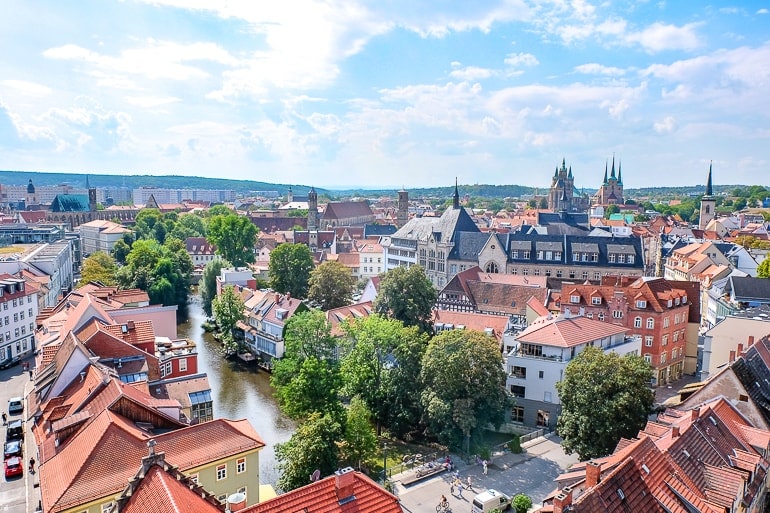
Erfurt is a beautiful city physically located in the centre of Germany. It’s also the capital of the German state of Thuringia.
Erfurt has a long history – and its central location in Europe has made it important for centuries.
The city was situated on the Via Regia – which was a medieval trade route/network across much of modern Europe. It has the Gera River running through it.
The rich medieval and religious history shows in what is considered one of the best medieval centres in Germany. The preservation of the “Altstadt” – or Old Town – is like a time machine when you walk around.
Erfurt is also known for famous Germans like Martin Luther – who studied at the University of Erfurt in 1501 before joining the Augustine Monastery (noted below) in 1505.
Today, the population of Erfurt is over 200,000 – making it a smaller city but a city nonetheless!
How To Get To Erfurt
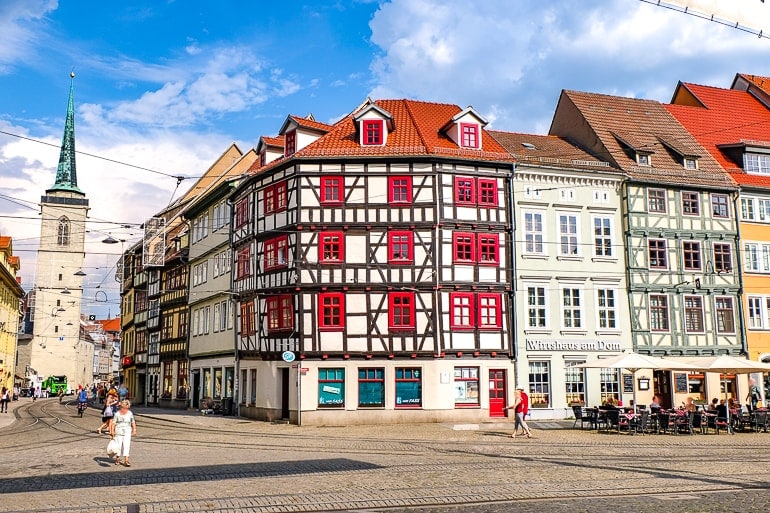
Erfurt is located in basically the middle of the country so there are a bunch of ways you can get there. Since Germany has great train travel, you can reach Erfurt easily from Leipzig, Frankfurt, or even Munich.
If you are driving and/or have a rental car, you can also get to Erfurt this way. There are plenty of downtown parking lots for easy storage and access to your car.
Getting Around In Erfurt
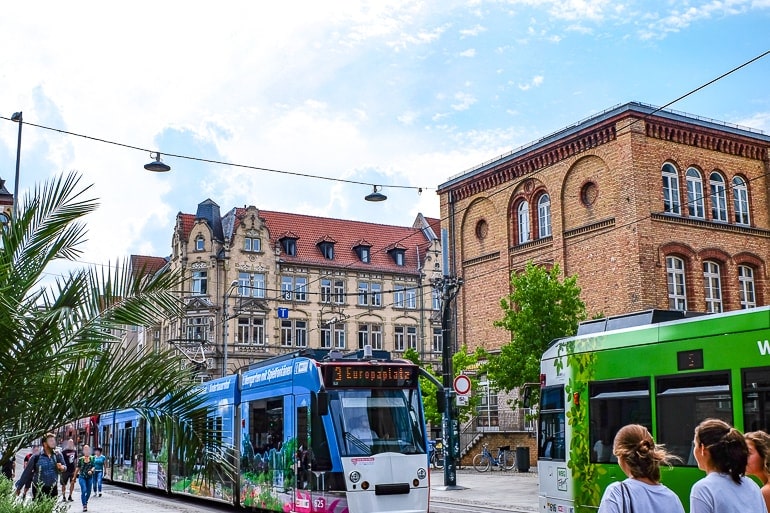
Once you are in Erfurt, the city centre is pretty flat so it’s easy to get around on foot. The train station is at the south end of the city centre so it is a quick 10/15 minute walk to the heart of the old town.
One of the only areas that is hilly is near the Citadel where you’ll climb a small hill and some steps to get up there.
As you walk around the city centre, you’ll notice lots of sets of tram tracks. The trams whiz through many parts of the city creating a network for you to get around if you so choose. There are also buses available to take.
Trams leave right from a platform beside Erfurt Train Station so you can arrive by train and connect to transit if you like. You can find the Erfurt Transit website here (in German).
You might also look into the Altstadt tour – a tram car-shaped vehicle that drives in the road – kind of like a caterpillar – and makes stops at the top attractions with a guide.
You can find information on this tour here . There is also a city tour where you ride the tracks on an actual “tram tour”. You can learn more about this here .
*These tours are regularly available in German but English seems possible if you book in advance/for a group. Might want to send a quick email to check if you’re visiting!
Read More: Don’t Forget Your Handy German Phrases
Where To Stay In Erfurt
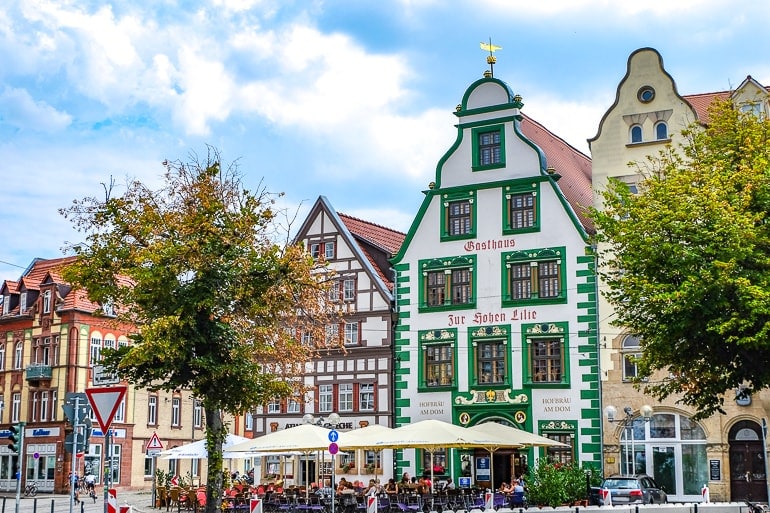
If you end up staying overnight, Erfurt is a great city to sleep in. We ended up staying at Gästehaus in der Gotthardtstraße and honestly loved it.
The place is a very simple guesthouse style accommodation in a quiet neighbourhood just a short walk from the best attractions.
The place was easy to find, safe, cozy, and the host was lovely. We also liked having a free bottle of mineral water waiting in the room. There are a few parking spaces available should you need it – and breakfast locations are very close by!
>> Check here for Gästehaus in der Gotthardtstraße
If you’re looking for a hotel in Erfurt, you might check out Hotel Krämerbrücke Erfurt (located RIGHT beside the Krämerbrücke) or the Protestant Augustinian Monastery – which is actually a “place to visit” listed down below. Turns out, you can stay in this historic building, too!
If you want to stay in a place that is physically in the photo above, you might want to check out Mr. and Mrs. President , a highly-rated apartment in Erfurt located right overlooking Domplatz.
**Friendly Disclosure: We paid for our stay ourselves and were not told to include the accommodation in this article.
And there you have it – some of the best things to do in Erfurt, Germany! We had a great time exploring this colourful, historic city.
We’d honestly recommend a stop if you are travelling through the middle of Germany. Let us know if you end up there and how you like it!
As always, Happy Erfurt Waddlin’, -L&E
Related Articles
We write a lot about Germany – including detailed itineraries around Germany – so check out these other helpful Germany posts!
- Must-Knows for Travelling to Germany (For the First Time)
- Erfurt is Close to Beautiful Bamberg and Coburg
- Discover Great Attractions in Berlin
- Compare flights on Skyscanner
- Check for Hotel Deals or Book A Hostel
- Get A Rental Car (depending on the destination)
- Research plug types and possibly get a travel adapter
- Go over our packing list
Pin it for later!
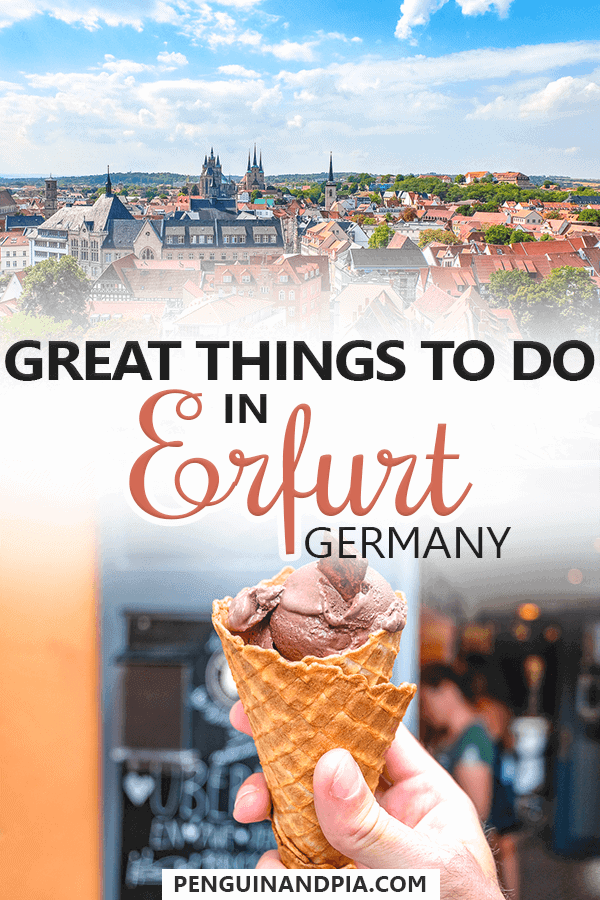
As an Amazon Associate we earn from qualifying purchases.
Destinations
Privacy policy
Disclaimer & Affiliate Disclosure
Terms of use
© 2024 Creativlier Media Inc.
- Travel guides
- Luxury Hotels
- Munich guides

The 10 best things to do in Erfurt, Germany
A list of the top tourist attractions and places to visit in erfurt, the capital of thuringia.
Erfurt is a young and vibrant city with a visible history of more than 1,000 years. With a population of barely 200,000 people, it might not be the biggest capital of a German state, but it’s certainly one of the most charming. The old town with its many half-timbered houses is nothing short of stunning and there are actually quite a lot of things to do in Erfurt.
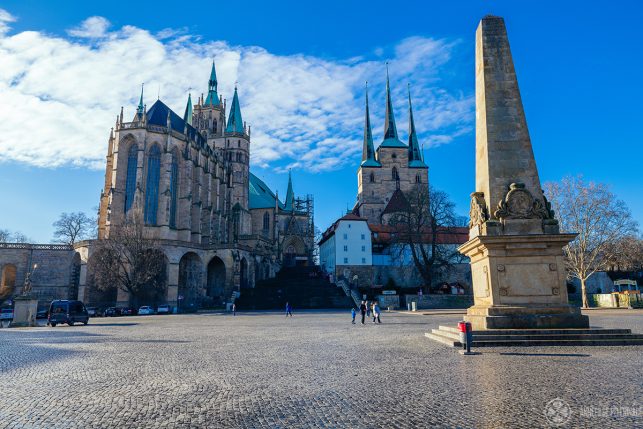
I recently revisited the capital of Thuringia and thought I’d share my impressions with you. What I particularly liked about Erfurt was the fact it was not as crowded as Berlin or Munich , where it often feels like you are one small fish in an ocean full of tourist groups.
You should also be aware that beautiful Weimar, a double UNESCO World Heritage site, is only 20 minutes away . It’s even more spectacular than Erfurt. You can read my Weimar guide here . So, you might even want to stay a night!
Either way, here is my list of the top things to do in Erfurt.
1. Krämerbrücke & old town
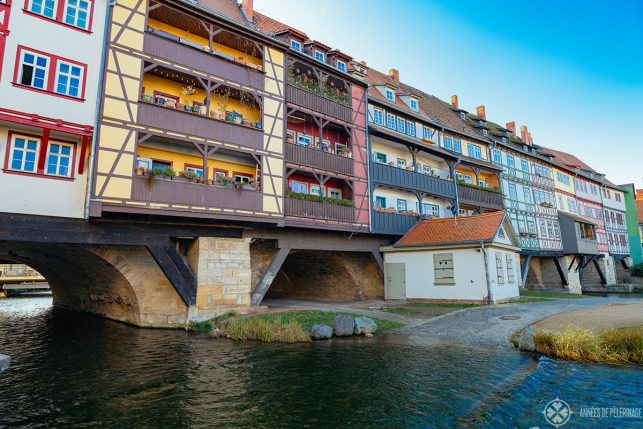
The Krämerbrücke (roughly translates chandler’s bridge) is the most iconic landmark in Erfurt . It’s both the oldest secular building in town and the longest inhabited bridge in Europe (yes, even older than the Ponte Vecchio in Florence). Half-timbered houses flank a beautiful cobblestone street.
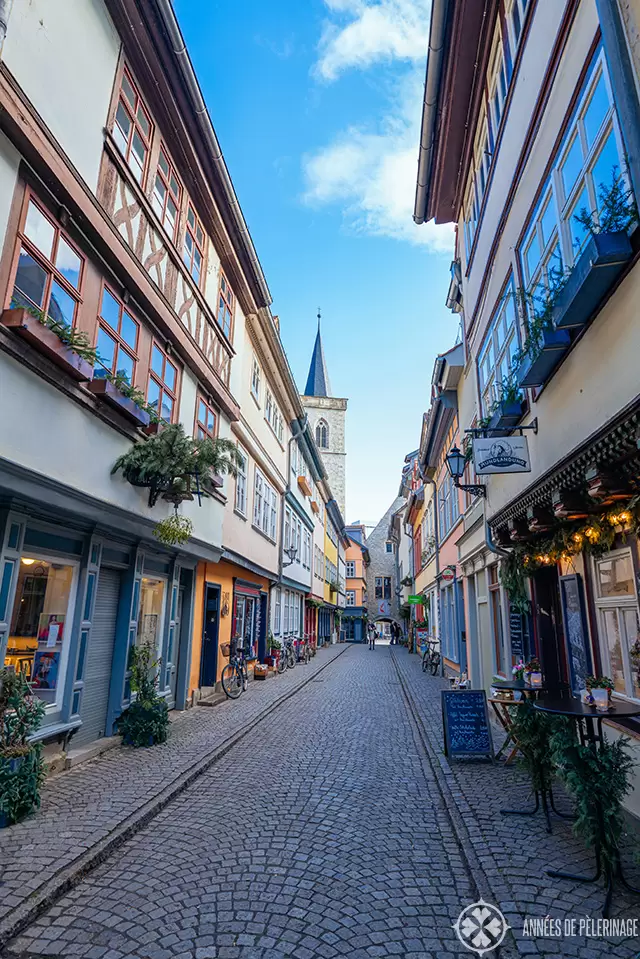
Left and right you’ll find shops where you can buy an authentic souvenir or two. It’s just such a lovely place. The bridge was constructed in 1325 , though most of the houses “only” date to the 15th century or later. If you happen to be in Erfurt on the third weekend in June, you’ll be able to partake in the annual Krämerbrücken festival.
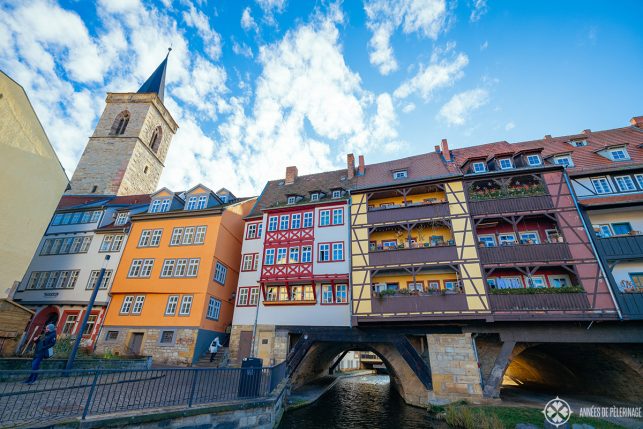
Note: Don’t miss the St. Aägiden’s tower at the far end of the bridge. Climb it for a beautiful view of the old town!
2. Erfurt Cathedral
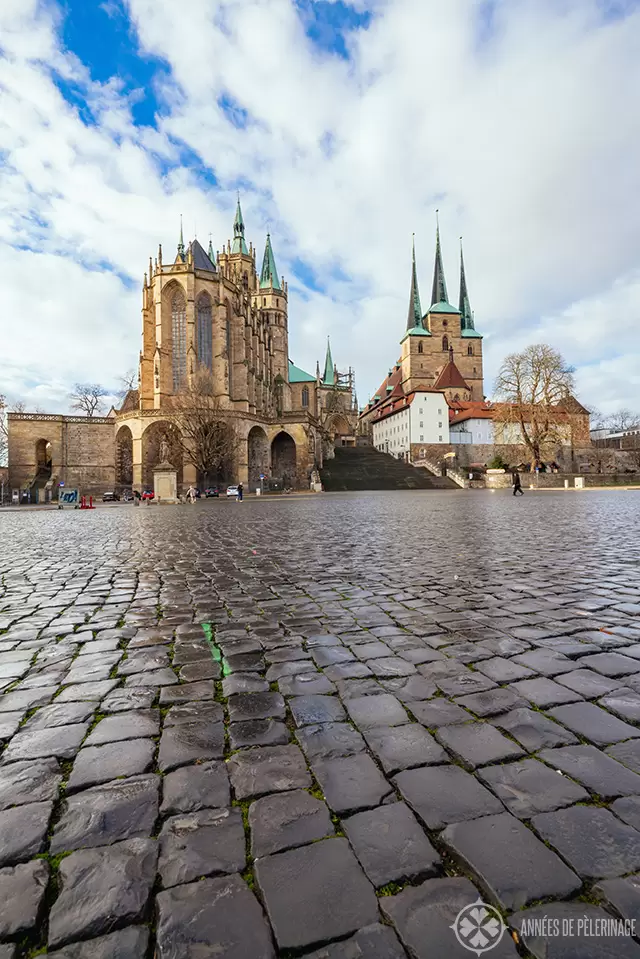
The Erfurter Dom is both the oldest and the most important church in Erfurt . Legend has t it was founded in the 8th-century but it was continuously expanded and remodeled so what you see today is mostly gothic additions built between the late 13th-century until the mid-15th-century.
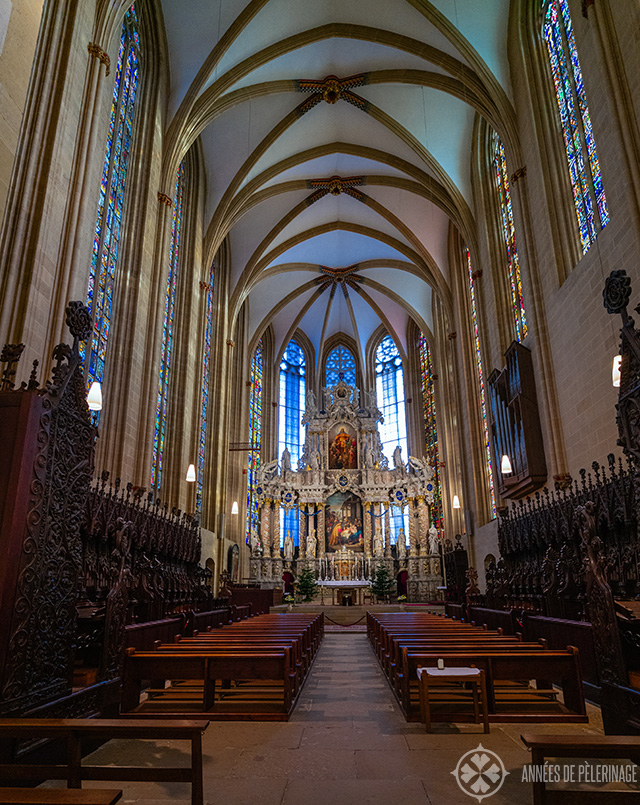
Erfurt Cathedral is home to the largest free-swinging medieval bell in the world (the so-called Gloriosa) and inside you’ll find one of the largest collections of late-gothic stained-glass windows as well. The impressive windows were created between 1370 and 1420. Since no bomb hit the cathedral during WW II, 895 of the 1100 single window panes are still originals from the medieval ages. The choir stalls are from that period as well!
You’ll find the Erfurt Cathedral on the so-called Cathedral Hill ( Domberg ) right in the heart of the city.
3. St. Severi
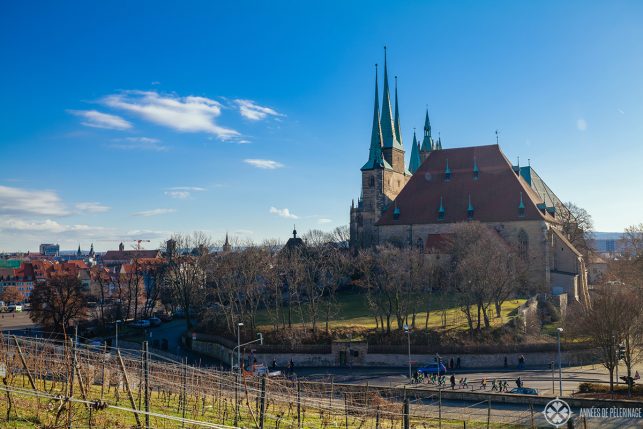
There’s another church abutting the mighty cathedral hill: St. Severi. Saint Severus of Ravenna was a bishop of Ravenna between 342 and 346 AD and the remains came to Erfurt in the 9th-century when the foundations for the first church were probably laid . This church was later razed by King Heinrich IV.
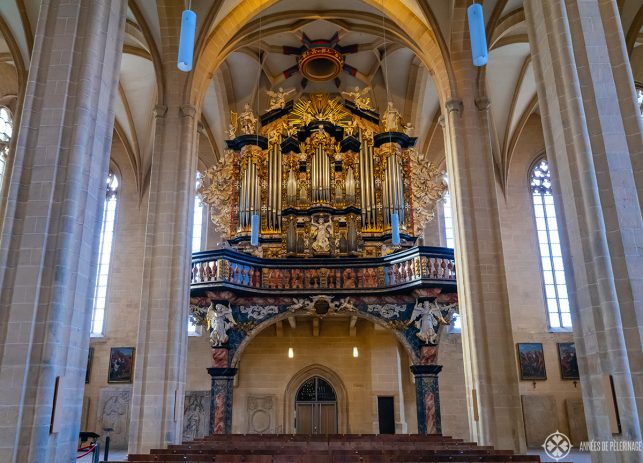
What you see today dates mostly to the 13th century . The iconic towers were only added around 1500 after another fire ravaged the church. Interesting fact: After Napoleon conquered Thuringia, the church was for sale. But because no buyer was interested, the church survived.
Personally I just love the mighty organ of the catholic church. The outstanding baroque housing was added in 1714 by Johann Friedrich Wender and is just beyond divine!
4. Petersberg Citadel
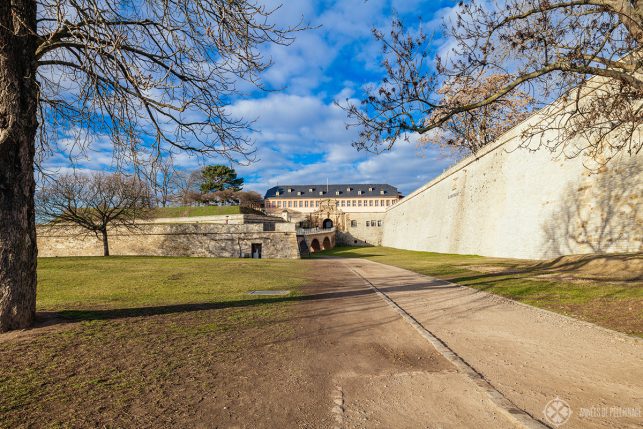
The Erfurt Citadel can trace its root back to the 5th millennium BC . The Celts, and later the Germans made use of the prominent hill. Starting from around the 9th century, it was turned into a monastery. The age of monastic use ended with the thirty years war when Erfurt was claimed by the prince-elector of Main and the Petersberg was turned into a mighty fortress.
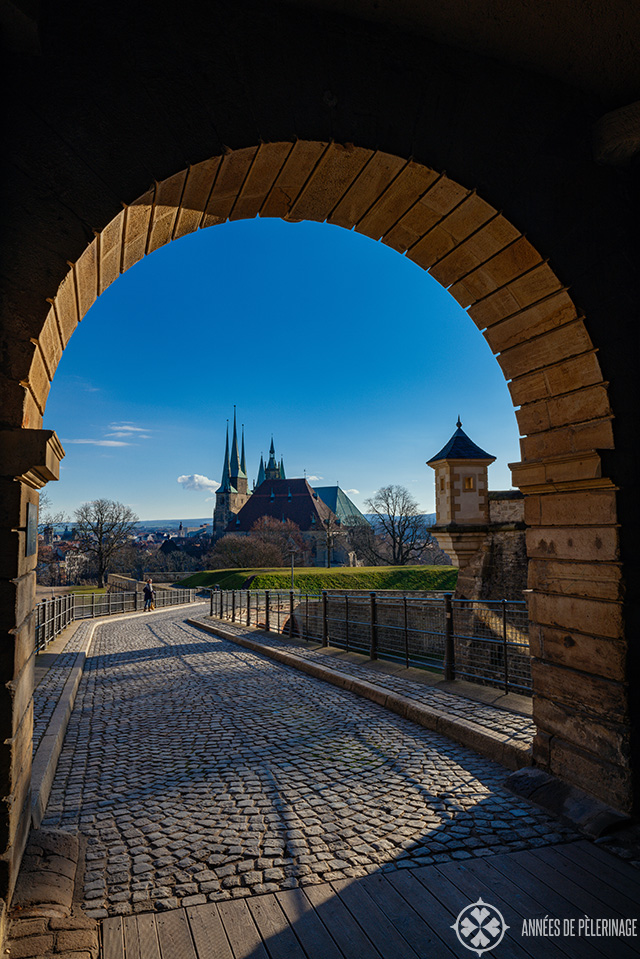
The citadel was continuously expanded between 1665 and 1831. There are plans to turn some of it into a museum and install a multi-media show. Definitely make sure to sip a coffee at the Glashaus restaurant. It’s the best viewpoint in the city if you ask me and it’s the perfect place to stop for a moment after exploring the old town.
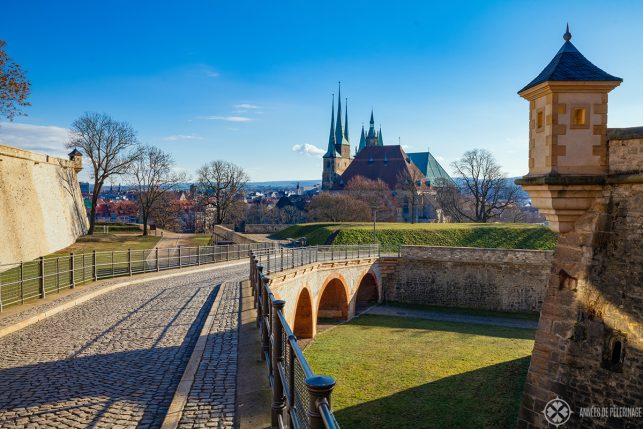
Note: The Petersberg Citadel is currently undergoing extensive renovation works which will last until 2021 when the famous Bundesgartenschau (biennial federal horticulture show) will take place in Erfurt.
5. Protestant Augustinian Monastery
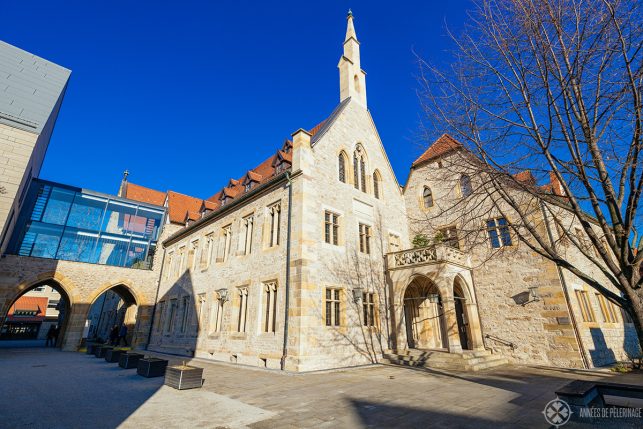
Martin Luther forever changed Christianity when he translated the bible into German, proclaimed his ninety-five theses, and thus induced the Reformation that would lead to a dramatic schism in the Roman Catholic Church. But did you know that Luther started his journey in Erfurt ?
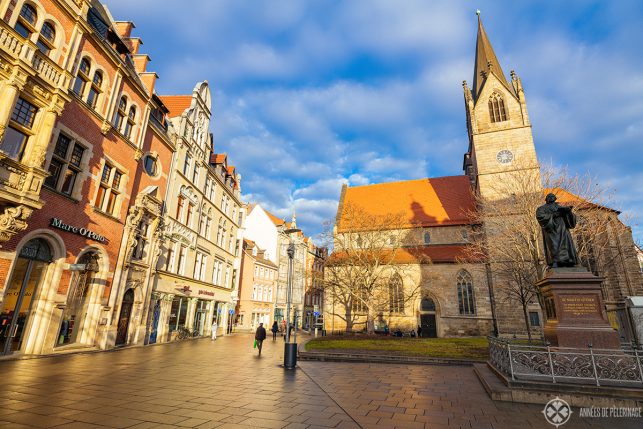
He started his training as a novice in the Augustinian Monastery in Erfurt and later started teaching at the Auditorium Coelicum. Today, you can still visit the very same monastery and even go on a tour to explore the inner cloister twice a day.
6. Old Synagogue
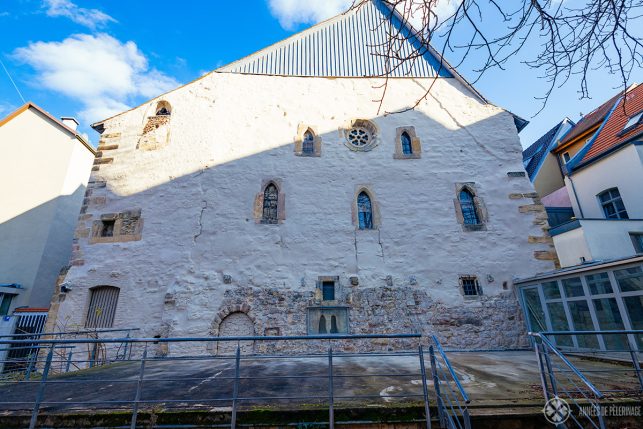
Probably the most fascinating place to visit in Erfurt is the Old Synagogue. It was turned into a museum in 2009 and documents almost a thousand years of Jewish presence in Thuringia. The oldest part of the buildings dates back to the 11th century which makes it the oldest synagogue in Middle Europe.
The Erfurt Synagogue was repurposed as a warehouse after the terrible pogrom in 1349, which is the reason why the foundations and walls remained.
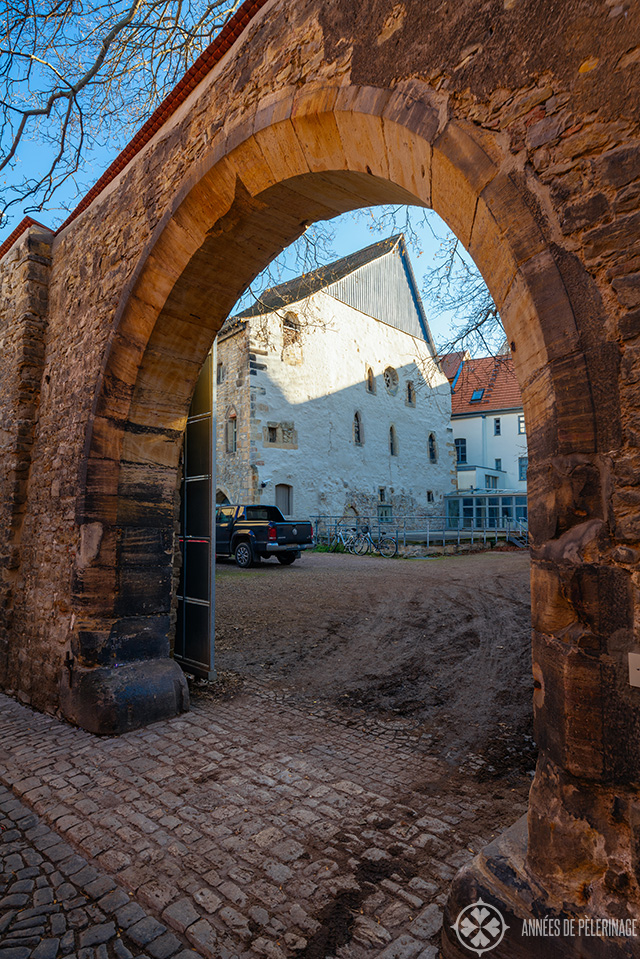
In 1998, archeologists found the famous Erfurt treasure hoard. Before the pogrom, a wealthy merchant buried his silver under a wall near the Synagogue and quite through a miracle it was never discovered. What makes the silver treasure so special is the fact that it dates back to the end of the 13 century .
It is a unique example of renaissance art. There is even an outstanding Jewish wedding ring from that time. You have to know that renaissance jewelry is beyond rare , as most of it was repurposed throughout the ages. To find a whole set of it, was quite unprecedented. (taking pictures of the treasure is not allowed)

7. Angermuseum
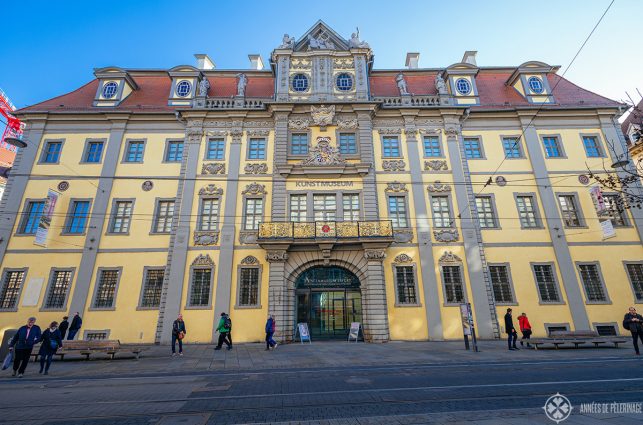
The Angermuseum is the largest and most prominent museum in Erfurt. You’ll find it in an imposing baroque city palais not far from the main square. It’s quite the lovely arts & design museum with a strong focus on artworks from Thuringia. It’s not particularly large, so you’ll probably just need an hour to visit it.
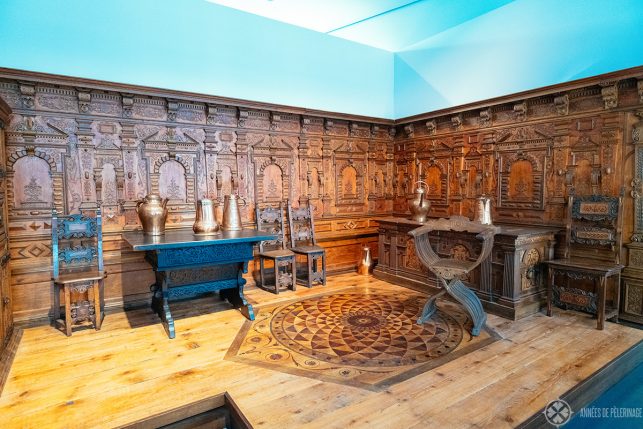
Personally speaking, I find smaller museums so much more charming as you really got the time to appreciate every exhibit. There are not only paintings, but also furniture, porcelain, and even contemporary jewelry. I particularly loved the renaissance apartment on the second floor .
8. Walking tour through the old town (door porn galore)
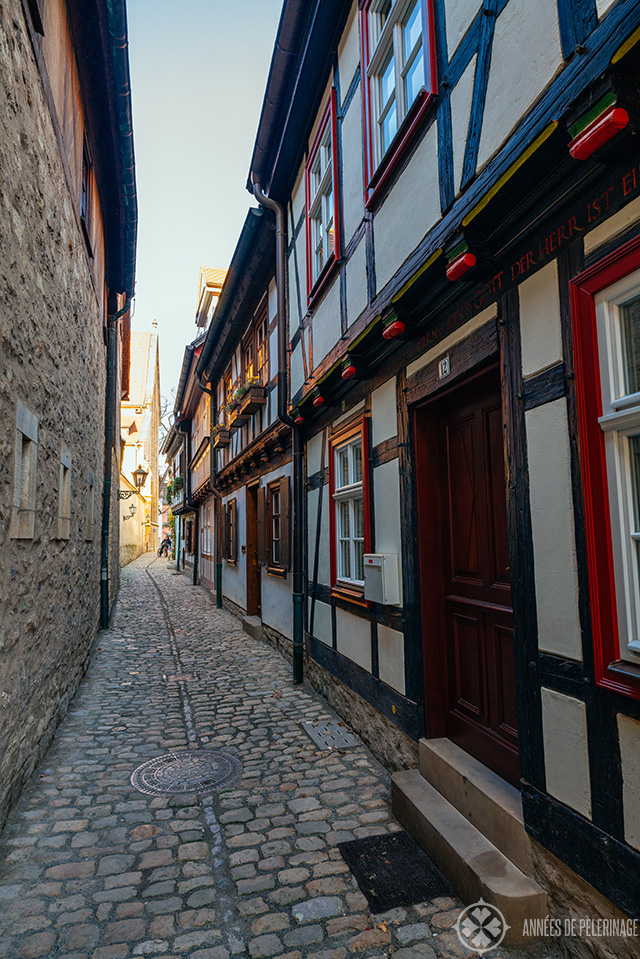
Don’t forget to reserve some time to explore the rest of Erfurt’s old town. There are some stunning places where it feels like walking through a fairy tale! The Kirchgasse is one of these places you absolutely have to see , but there are many more.
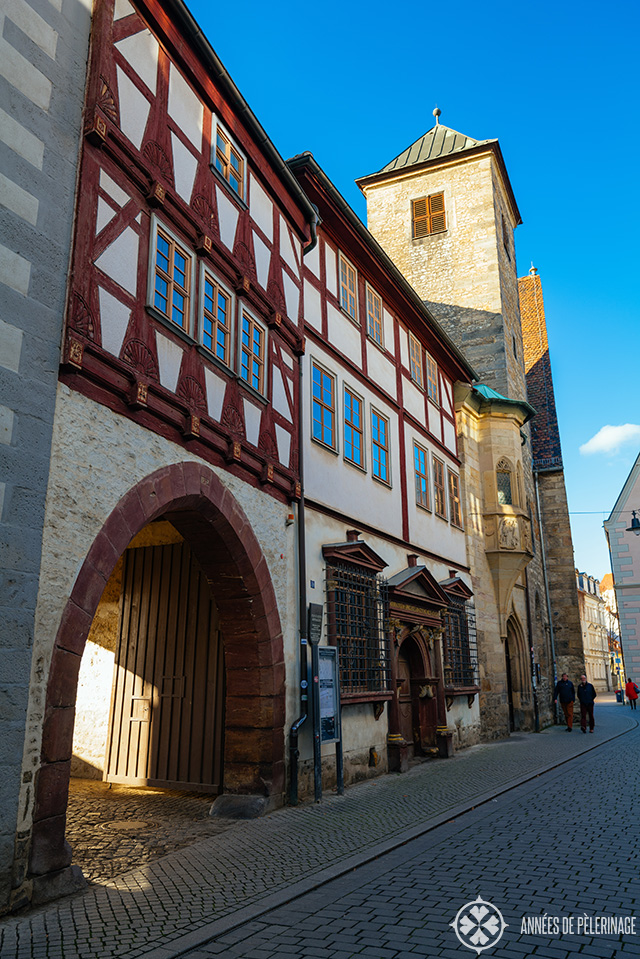
What I personally loved the most were the many beautiful old doors . Most of them have a little sign above the lintel which indicates the name of the place. You’ll see suns, fish and a panoply of other animals! Quite fascinating.
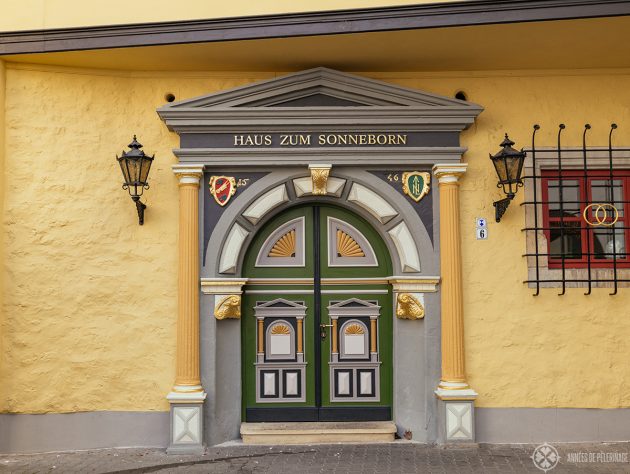
The House zum Sonneborn is also a tourist favorite. In fact, it’s a very popular wedding venue among locals and the door is beyond amazing.
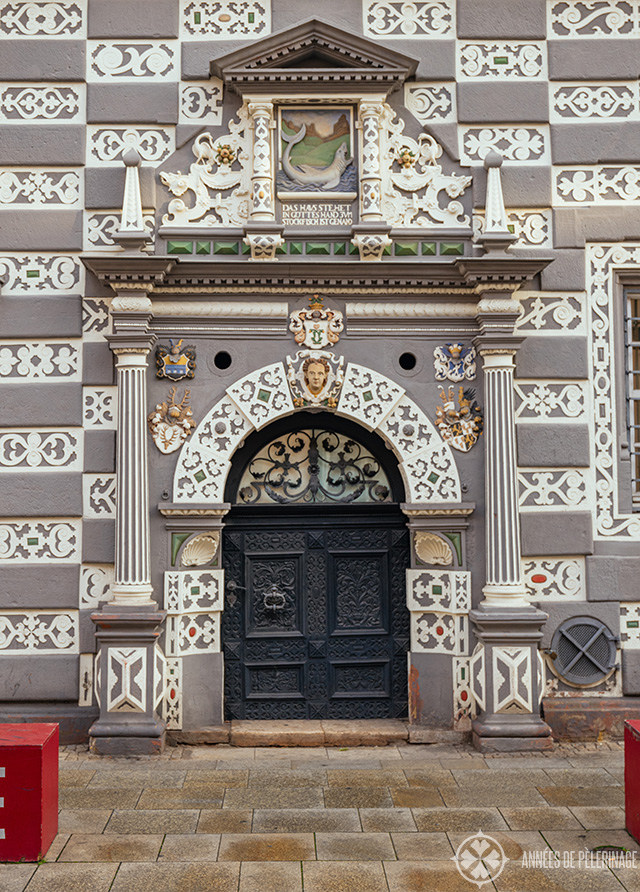
If I was serious about Instagram, then definitely consider exploring the many medieval doors of Erfurt.
9. Stadtmuseum Erfurt
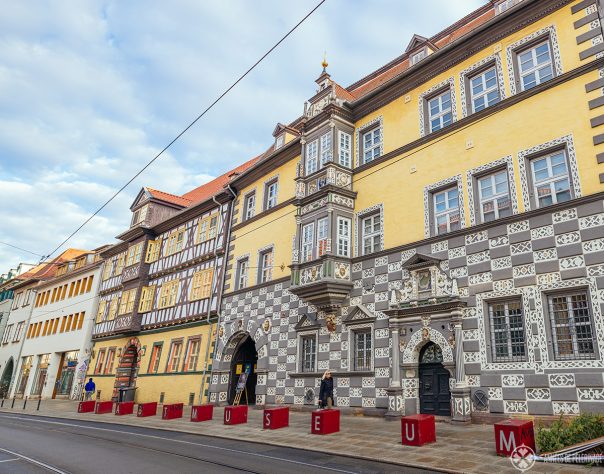
One of the lesser-known sites in Erfurt is the fabulous city museum . You’ll find it in the Haus zum Stockfisch which is a tourist attraction in and by itself. The ground floor of the museums is dedicated to the ancient history of the city, while you will find an exhibition of the more recent past on the second floor.
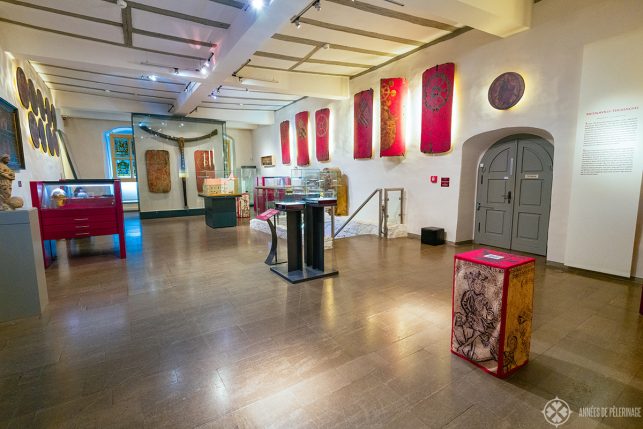
I want to be honest with you, though. It is not a world-class museum with a collection that will take your breath away. If you are short on time, you can skip it and will probably not regret it. But at the same time, the small museum does give you quite a vivid impression of Erfurt’s past . At the very least, you should at least walk past, as the facade is just so beautiful.
10. City Hall & Fish Market
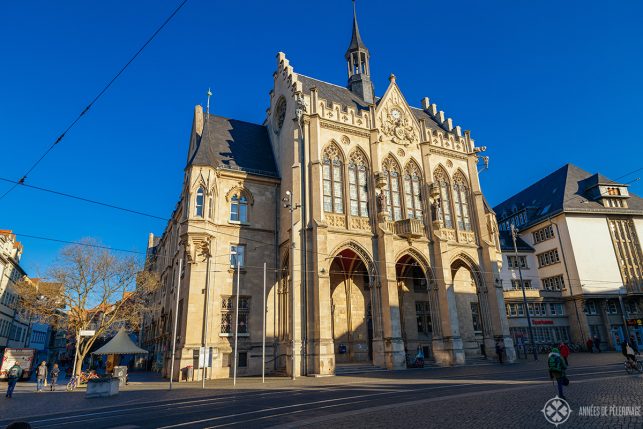
Last, but certainly not least, I would like to mention the beautiful Erfurt town hall. Don’t hesitate to go inside. It’s still a functioning town hall. There’s a big festival hall inside and the historic staircase is quite lovely as well! But don’t miss the other buildings around the Fischmarkt (“fish market” either.
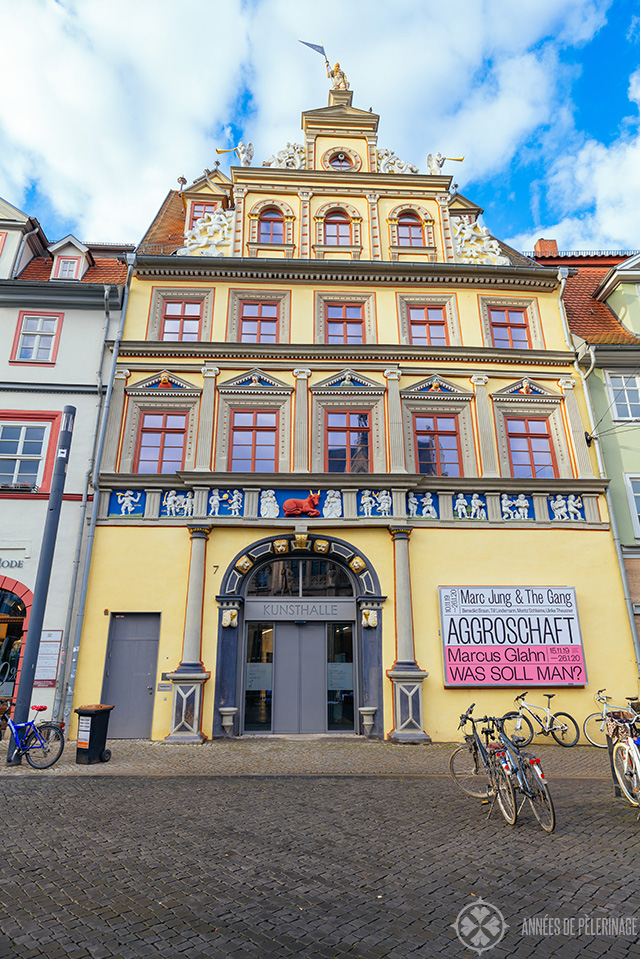
If you like contemporary art, the Kunsthall Erfurt (“art hall Erfurt”) might be a place you want to stop as well. It’s certainly not the Guggenheim Museum but I found it to be quite charming.
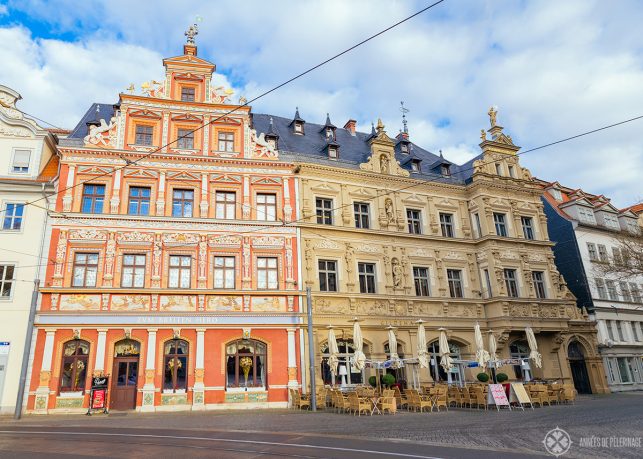
You will want to take a picture of the guildhall as well. Now, there’s an Italian restaurant inside. The food is only okayish, so I’d have lunch somewhere else. But the building is certainly beautiful!
Other things to do in Erfurt
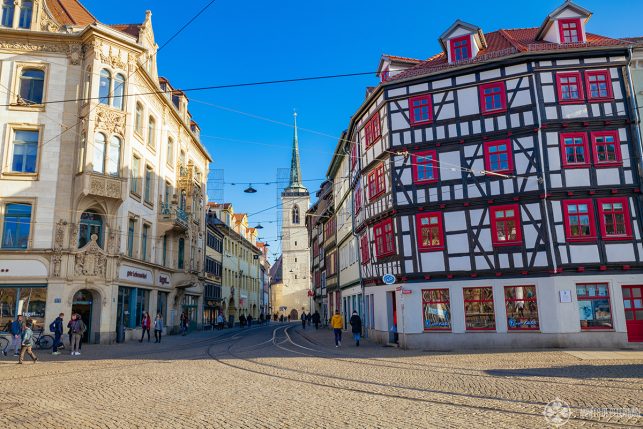
I want to be quite honest with you: There are not a lot of other places to visit in Erfurt. While the city does have quite an illustrious history it only became the capital of Thuringia in 1991. Nearby Weimar placed a far more important role throughout most of the state’s history. As such, the city is lovely but lacks the important highlights other state capitals ( like Munich ) have to offer.
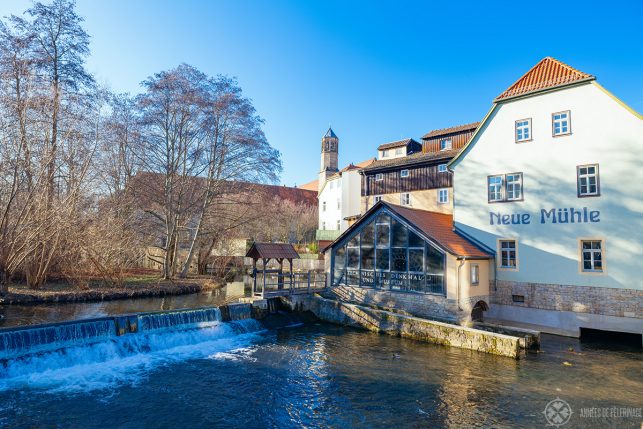
There is, however, a small natural history museum and you’ll find a tiny technical museum in the old mill.
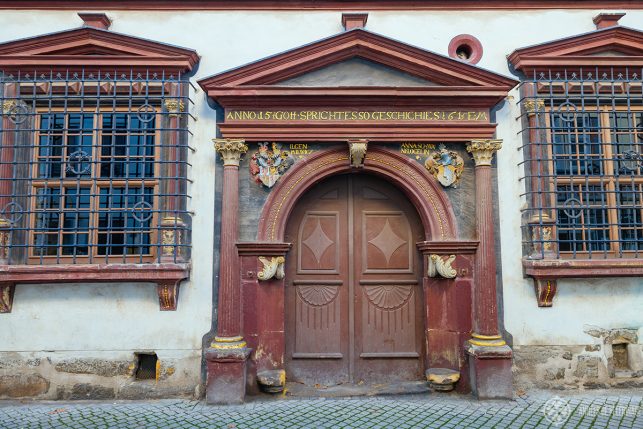
That being said, the city is beautiful and very clean. The people are friendly and the food is excellent. It is a very good alternative for longer Germany itineraries and as I said, you can combine it with a visit to Weimar and then move on to Dresden or Berlin.
How to get to Erfurt
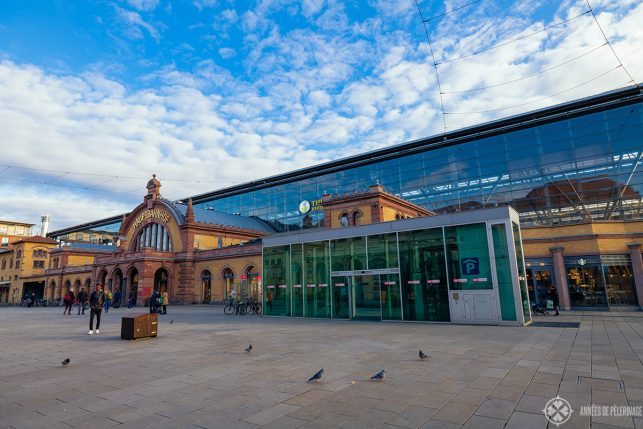
Getting to Erfurt really couldn’t be easier. There’s a high-speed train connection between Munich and Berlin, and Erfurt is one of the few stops on the way. It takes 2 hours 30 minutes to get there from Bavaria’s capital and only 90 minutes from Berlin. You can check the schedule on the official website of the German Railway .
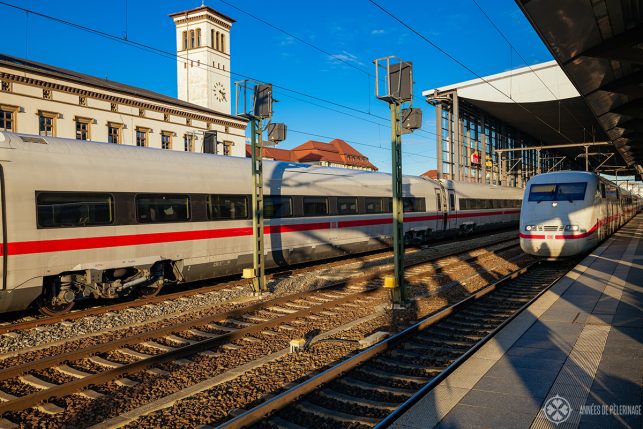
The connection is so good, that you can actually visit on a day trip from Munich (that’s what I usually do).
Where to stay in Erfurt
Note: I earn a small commission for purchases made through links in this article.
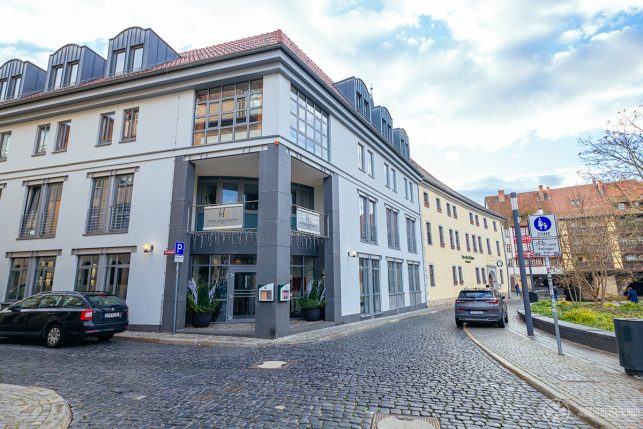
I usually stay in Weimar because the hotels there are much better. It only takes 30 minutes to Erfurt from there. As the city is much richer, I feel that this is where you should stay ( I loved the Hotel Elephant ). But there is no denying that sleeping in the capital has it’s advantages as well, especially if you want to enjoy some nightlife (Weimar is virtually empty at night).
Luxury hotels
- Dorint Hotel am Dom Erfurt (the only 5 -star hotel in town)
Mid-price hotels
- Hotel Krämerbrücke Erfurt (beautiful location)
- Mercure Hotel Erfurt
Budget hotels
- Opera hostel
Best time to visit Erfurt
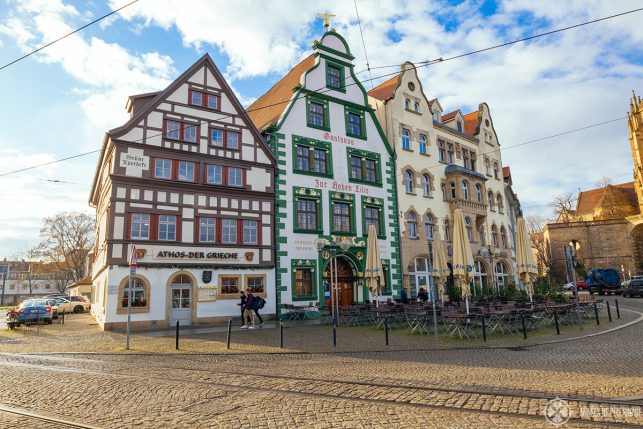
Erfurt is worth a visit all year round. It’s never really crowded and the old-town can be beautiful no matter the season . I’ve been there in winter and summer and was never disappointed. So, plan your Germany or Europe itinerary first, and Erfurt will fit in anyways.
There is just one thing you should know: Winter is really quite, so some tourist attractions are not open on weekdays (like the tower of the Aäigiden church, etc).
This is it. I hope I was able to show you the best things to do in Erfurt, Germany. Feel free to ask your questions in the comments below!
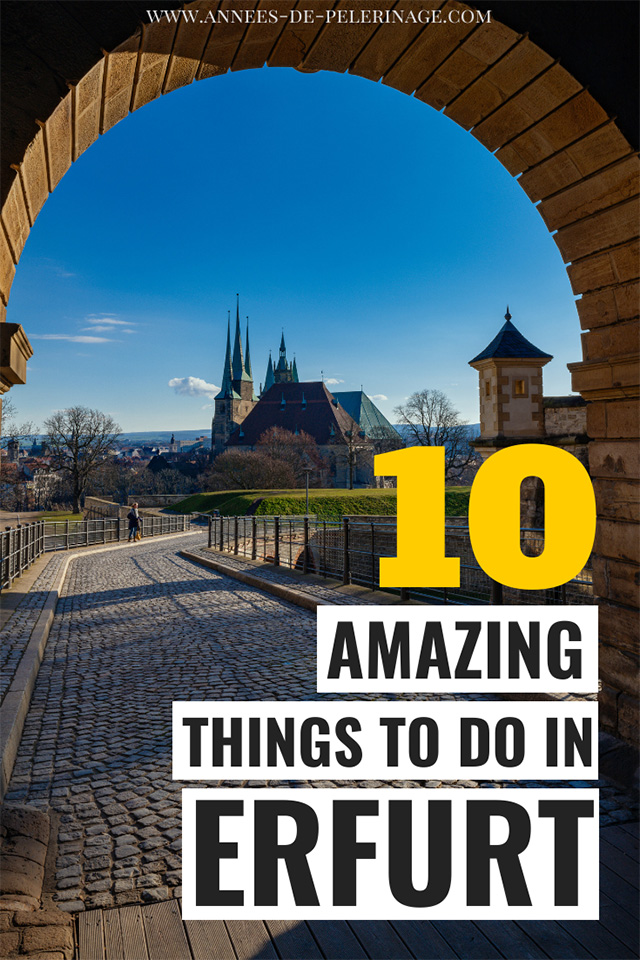
RELATED ARTICLES MORE FROM AUTHOR

The 15 best things to do in Stuttgart, Germany
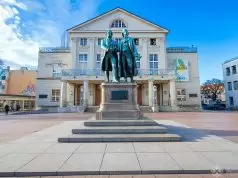
The 15 best things to do in Weimar, Germany
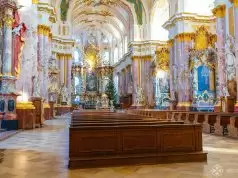
Fürstenfeld Abbey – a beautiful half-day trip from Munich
Leave a reply cancel reply.
That's okay for me
Save my name, email, and website in this browser for the next time I comment.

The latest post on my travel blog

The best things to do in Madeira, Portugal
- Terms & Conditions
- Site notice
- Data Privacy Statement
Ultimate Guide to Sightseeing in Erfurt, Germany
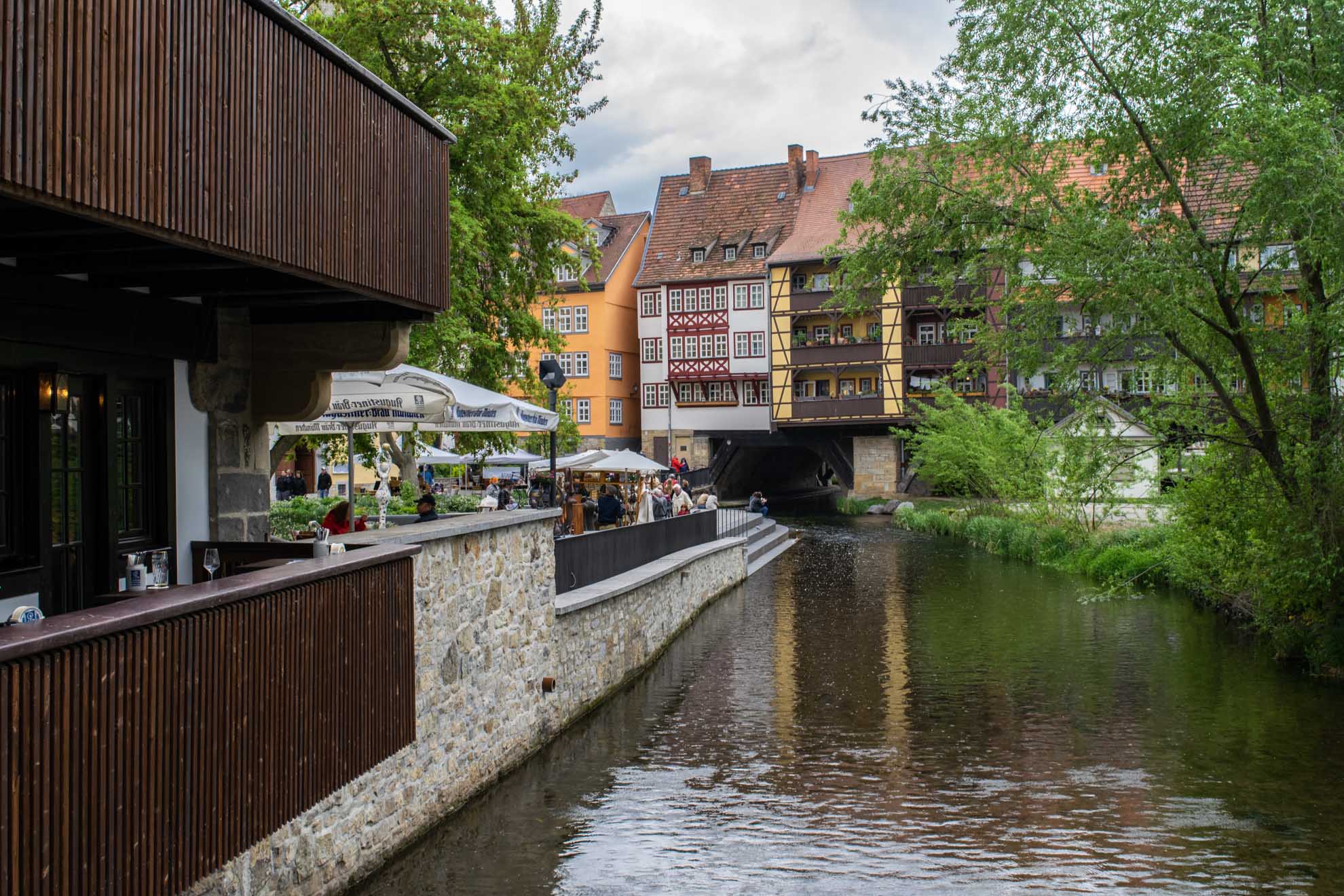
Disclosure: This post (probably) contains affiliate links. If you click on one, I may make a small commission. Of course, this will come at no extra cost to you and helps keep this site running.
Germany may seem like the kind of country where you’ve already heard about all its most interesting destinations. But unless you’ve heard of Erfurt , you haven’t yet. Erfurt is the perfect example of a smaller German city loaded with character that doesn’t receive much notice. Despite being the state capital of Thuringia and conveniently located in central Germany, the idea of visiting Erfurt doesn’t seem to be a common one. Perhaps an Erfurt guide like this will help.
Coming from eastern Germany as I travelled across the country recently, Erfurt seemed like a natural fit. A little research later and I decided to give it a shot. I had no idea just how good of a choice I’d made at that point. Two days in Erfurt sightseeing and I didn’t come close to finishing the list of things to do there.
Even rather grey and gloomy weather didn’t dampen my enthusiasm for the city. So to help you find all the best places to visit in Erfurt, I’ve put together this Erfurt sightseeing guide. Looking through, you should be able to see just how much there is to do in this fantastic German city.
Table of Contents
City of Erfurt

So, what do you need to know about Erfurt? Unlike places like Berlin and Munich, chances are you’re not all that familiar with it yet. Perhaps the greatest selling point of Erfurt is that it has one of the best preserved medieval old towns in all of Germany. If you like old-fashioned buildings, you’re in luck. Many of the historic houses in the city are named, with buildings like the “Haus zum Guldenen Stern” and “Haus zum Schwarzen Horn” both dating from the 15th century.
In fact, many of the best things to do in Erfurt relate to the city’s history and culture. As a state capital, it makes sense that the city would be a cultural hub, explaining why it’s home to many different museums and art galleries. Then there are the countless shopping areas, not to mention the weekend markets that fill different squares.
What’s nice is that most of the other tourists doing this will be Germans themselves. This means that Erfurt will feel genuine and untouched in a way that is often hard to find in parts of somewhere like Berlin.
Krämerbrücke Bridge

There’s no better place to start when visiting Erfurt than with the wonderful Krämerbrücke. An iconic sight of the city, this merchant bridge is reason to come all on its own. The Krämerbrücke is Europe’s longest bridge covered in houses, many of which people still live in to this day.
The current stone bridge was originally built in 1325 and expanded in 1472 after a fire. Originally there were 62 narrow merchant houses along the bridge, but over time houses were merged. Now some of the 32 remain houses actually have multiple entrances to them. Once you’ve walked along the cobblestone street that spans the bridge, you really need to come around to the small square north of it. It’s here that you’re treated to a full view of the bridge in all its glory.
At one end of the Krämerbrücke lies the Ägidienkirche church, who’s belltower you can climb for views of the old town. Nearby you’ll also find the remains of Erfurt’s medieval mikveh, a ritual bath used by the city’s Jewish community.
Gera Riverfront

One of Erfurt’s most defining features is the Gera river that flows through the city. Although not a major river, the Gera does grant the city a beautiful riverfront. The Krämerbrücke may be the most popular landmark along the river, but it’s worth taking a stroll along other parts as well.
The area by the river northwest of the iconic bridge is particularly beautiful. It’s here that you’ll see many restored traditional houses among lush trees overlooking the river. If you’re a fan of bridges, the Gera is also a good spot to visit with countless crossing its gentle stream.
Fischmarkt Square

For the heart of city life in Erfurt you need to head to the city’s main square, the Fischmarkt . Lined with traditional burghers’ houses, it really is one of the most splendid sights in Erfurt. It’s also one of the busiest places in the city, especially on market days. But even with crowds of people and trams rolling through, the Fischmarkt maintains its charm without issue.
What’s interesting about this main square is that the City Hall is greatly overshadowed by other buildings here. Among the beautiful buildings on Fischmarkt, “Zum Breiten Herd” and the Gildehaus next door are fascinating to look at thanks to the friezes on their facade. The “Zum roten Ochsen” house is no slouch, home to the Kunsthalle Erfurt art gallery that we’ll cover later.
Old Synagogue

Credit: Erfurt Tourismus und Marketing GmbH/ Photo: Vasiliy Dolzhansky
While it may have been lost to the world for a while, you need to find your way to the Old Synagogue of Erfurt. A visit here not only shows you this historic building but reveals the short-lived history of the Jewish community here. Records indicate that the Old Synagogue has been around since the 11th century. The current look of the building though comes work done in around 1270. Still, it remains one of the oldest synagogues in all of Europe.
With the Jewish Quarter squarely in the centre of the city, it was an integral part of city life in Erfurt. That coexistence between Christian and Jewish communities ended when the Black Plague hit Europe. Jewish communities across Europe were blamed and on 21 March 1349 the entire community was murdered. The Old Synagogue then passed through various owners and at one time was an inn with an upstairs ballroom.
As Erfurt developed, houses built up around the building and it was eventually just forgotten. Only in the 1980s was it rediscovered and restored and since 2009 has been a city museum recounting what Jewish life was like in Erfurt. The museum today takes you through this history and exhibits medieval Jewish manuscripts and treasures found in 1998 during excavations in the old Jewish Quarter.

Sometimes it’s nice to just walk along a pretty and quiet street and admire the houses. While you probably won’t find Krämerbrücke empty, Kirchgasse is another story. This small, yet atmospheric side-street runs along behind the Augustinian Monastery and is lined with beautiful half-timbered houses. With some covered in ivy and others recently repainted, it’s further proof that Erfurt has a fantastic old town that needs exploring.
Erfurt Cathedral

Of all the landmarks in Erfurt, I don’t think any quite have the gravitas of Erfurt Cathedal. This immense cathedral and the Church of St Severus next door form a figure that is hard to miss. Together they share the aptly named Cathedral Hill and overlook the wide-open Domplatz below. With their Gothic design and collection of spires, the pair create an iconic part of Erfurt’s skyline.
As nice as the Krämerbrücke is, it was the sight of Erfurt Cathedal that really dazzled me. I’m sure photographers spend countless hours capturing this attraction from every angle imaginable. My timing could have been better as there was a car show being held in Domplatz which obscured the view a bit. Not obscured though was the cathedral interior. It’s just as astonishing inside thanks to the elaborate altar and details on the wooden choir stalls.
Petersberg Citadel

Just as the spires of Cathedral Hill are hard to miss, so too is the imposing figure of the Petersberg Citadel. Sitting on another hilltop across from the Cathedral, the fortress has long protected to the city of Erfurt. Not only is it one of the largest fortress complexes in Europe, but also one of the best preserved Baroque city fortresses. That’s despite Napoleon capturing the citadel and the Prussians in-turn attacking it.
The main reason to the make the walk up to the citadel is for the city views there. As impressive as it is to walk through the outer walls and gates, that view of the city is where the magic is. The fortress’ panoramic terrace looks directly down on Domplatz and out over Erfurt’s sea of rooftops. While it is possible to roam the fortress grounds and follows its ramparts, this is definitely the first thing to do up here.

Andreasstraße Memorial and Educational Site

Just below the citadel you’ll find the Andreasstraße Memorial , one of Erfurt’s most detailed museums. Housed inside the city’s former Stasi headquarters, Andreasstraße both honours those who suffered under the secret police and shows visitors what life was like at the time. While I also visited a similar museum in Leipzig , I felt far more informed after my visit to Andreasstraße.
The museum is broken up into three themes with one per level: Imprisonment, Dictatorship and Revolution. Each theme takes you through a different stage of the communist era, with the tour culminating in the uprisings of 1989/90. For English speakers, it’s best to go with one of the audio guides there as they’re highly detailed.

The displays here are a great mix of audiovisual displays, rooms and items so that you get a very interactive and well-rounded experience. Being able to walk down between the untouched prison cells is certainly an unnerving feeling. Don’t miss the highly artistic “Cube of the peaceful revolution” installation in the courtyard either.
I probably would have spent more time here if I didn’t have other places to visit. For me, this may have been one of the best things to do in Erfurt while I was there.
Kunsthalle Erfurt

Modern art galleries aren’t always my thing. I often have a hard time working out what I’m meant to take away from the art they have on display. But when they’re as strange and quirky as some of the exhibits at the Kunsthalle Erfurt, it’s hard not to be drawn in.
As the art gallery focuses on temporary exhibits, there’s no telling what will be on when you visit but it’s worth a look nonetheless. For me, I experienced everything from short films to mammoth installations and plenty of surreal pieces in between.
Angermuseum

At the far more traditional end of the spectrum is Erfurt’s main art museum, the Angermuseum. Housed inside a palatial baroque building, if offers a variety of exhibits. It’s the kind of museum that seems to grow and grow in size the longer you’re there. The ground floor has quite a significant medieval collection, with plenty of historical artifacts and stunning cabinetry like seen above.
Upstairs, there is a picture gallery dedicated to landscapes and still life paintings. Tucked around a corner you’ll also find a densely filled exhibit of ceramics, metalwork and other finely crafted items. The temporary exhibit at the time focused on female artists of the Bauhaus era, something I was totally unfamiliar with. Still, another museum with considerable depth and few other tourists there.

Despite being the first place I explored during my visit, I’ve left the Anger shopping street to last. Running 500 metres right up to the Angerbrunnen fountain, the Anger feels like the heart of Erfurt’s downtown. While there are plenty of shops that may interest some, it also boasts quite a few art nouveau facades. That combination of shopping and architecture mean the Anger is worth visiting regardless of which appeals to you.
Erfurt Travelcard

One of the best bits of advice I can give those visiting Erfurt is to get the Erfurt Travelcard . Erfurt has two options of a city card for tourists, the Erfurt Card and Erfurt Travelcard .
Both cards give you free access to the city’s museums and landmarks, including the Old Synagogue, Angermuseum and Andreasstraße. The big difference is that the Erfurt Travelcard includes free public transport for the 48 hours the cards are valid. Almost guaranteed to save you money if you do three or more of the main attractions.
Visiting Erfurt

Beyond sightseeing in Erfurt, there are a handful of other things worth knowing before you go. One that’s always useful regards making your way there. Your best options for reaching Erfurt by public transport are either by train or with Flixbus . Nearby cities that make sense to come from include Leipzig, Berlin, Dresden and Frankfurt. None are all that far, but Leipzig is so close you could possible visit Erfurt as a day trip.
The other accommodation thing to think about is where to stay in Erfurt during your trip. You don’t want to stay far from the historical centre if you can help it, although there are always local buses and trams. Erfurt has a nice selection of hotels and apartments which will give you options. From my experience there, the Radisson Blu Hotel Erfurt is a safe choice too.
For more advice on sightseeing around Erfurt, I really recommend visiting the Tourist Information Office . Not only can they help with seeing the city, but you can rent an audio guide there as well.
Were you surprised to learn about of these best places to visit in Erfurt? Where would you start when sightseeing in Erfurt? Please share your thoughts in the comments below.
*Disclosure: I received an Erfurt City Card and a night’s accommodation courtesy of Erfurt Tourism . As always, opinions are completely and genuinely my own.

David is the author behind the Travelsewhere travel blog and is always on the search for the quieter, less-visited corners of the world.
You may also like
10 wonderful things to do in bamberg, germany, what it’s like to visit regensburg with a local, 8 super useful tips for visiting hamburg, germany, all the best things to do in leipzig, germany, goslar, germany — things to do in this pretty harz..., how to spend one day in rothenburg, germany.
Germany has plenty of smaller towns with Mediaeval and Renaissance buildings still intact or lovingly reconstructed. In case you’re still in the area, try Goslar and Quedlinburg. Lübeck at the Baltic Sea is also charming, with a lot of northern German Mediaeval brick architecture. In case you have Hamburg on the initerary – and you should – it’s not far to Lübeck by train.
More to the south are Nuremberg and Bamberg. If you visit the latter, take a tour to the Veste Coburg to add to your castle collection. There are actually some castles near Erfurt as well, the ‘drei Gleichen’, castle Gleichen, the Mühlburg (both ruins) and the Wachsenburg (now a hotel).
In case you want some more suggestions for less well known places in Germany, feel free to ask.
Leave a Reply Cancel reply
This site uses Akismet to reduce spam. Learn how your comment data is processed .

Home » Europe » Germany » 2 Days in Erfurt Itinerary – How to explore Erfurt, Germany, in 2 Days
2 Days in Erfurt Itinerary – How to explore Erfurt, Germany, in 2 Days
While Erfurt, the capital of Thuringia, might not be Germany’s best-kept secret, it’s undoubtedly less frequented than many of the country’s other major cities. Yet, a trip to this charming city is an experience you wouldn’t want to miss.
Find out how you can discover Erfurt in 2 days, what makes this city so special, and which things to do in Erfurt you should not miss.
We’ll take you on a fantastic 2-days in Erfurt itinerary to the most beautiful places in the city and some great tips from my friend Melissa, who lived here for a few years.
Author’s note: For full disclosure, I’d just like to briefly point out that we were invited to our weekend in Erfurt by Thueringen-entdecken.de as a winner of the 2022 Summer Blog Parade, but the article is in no way sponsored, and all opinions are my own.

What to find out in this post
- 1 Why visit Erfurt
- 2 Erfurt, Germany, Facts
- 3 Best Travel Time for Erfurt
- 4 How to get to Erfurt
- 5 How to get around Erfurt
- 6 Our comprehensive 2-Days in Erfurt Itinerary
- 7.1 The Kinderkanal figures
- 7.2 Erfurt Cathedral St. Marien
- 7.3 St. Severi Church
- 7.4 Domstufen – Cathedral steps
- 7.5 Cathedral Square
- 7.6 Petersberg Citadel
- 7.7 Gedenk- und Bildungsstätte Andreasstraße – Memorial & Educational Site
- 7.8 Rest of the day at leisure
- 8.1 Fischmarkt
- 8.2 Waagegasse
- 8.3 Old synagogue
- 8.4 Krämer Bridge
- 8.5 Teatrum Mundi
- 8.6 Goldhelm Ice Cream – Eiskrämer
- 8.7 Enjoy your ice cream at the Gera
- 8.8 St. Ägidien Church Tower
- 8.9 Wenigemarkt
- 9.1 EGA Park
- 9.2 Natural History Museum Erfurt
- 9.3 City Museum Erfurt – Haus zum Stockfisch
- 9.4 Augustinian monastery
- 9.5 Erfurt Christmas Market
- 10.1 Übersee
- 10.2 Goldhelm
- 10.3 Haus zum Naumburgischen Keller
- 10.4 Angus Döner
- 11.1 The best Hotel in Erfurt
- 11.2 The best budget accommodation
- 12 Is the Erfurt Card worth it
- 13.1 About the AuthorVicki
Why visit Erfurt
Erfurt is still a bit of a hidden gem in Germany. Its impressive medieval architecture and charming alleys attract travelers looking for authenticity and a connection to German history.
Unlike significant metropolises such as Berlin, Hamburg, or Munich, Erfurt offers a welcoming and relaxed atmosphere rarely found elsewhere in a big city.
The Krämerbrücke, the longest inhabited bridge in Europe, is just one of the many highlights of this city. Whether you want to explore the impressive churches and monasteries, stroll through the historic Old Town, or enjoy the local cuisine, Erfurt has something to offer each visitor.
ERFURT INFO BOX
Where to stay in Erfurt: Best Western Plus Hotel Excelsior (Good, central hotel with breakfast directly at the train station) or Pension Gerber (Comfortable middle-class accommodation with a friendly atmosphere)
The most popular activities & tours in Erfurt
Guided Erfurt City Tour
Selfuided Scavenger Hunt through the Old town of Erfurt
Petersberg Citadel Guided Tour
Private E-Rickshaw Tour
Visit in EGA Park
Arrival: The easiest way is by car or Deutsche Bahn (the train company). It is even cheaper if you book your ticket in advance. If you need to book a flight, make sure to check well in advance and compare different options with Skyscanner
Transport on-site: By public transport and walking
Want to rent a car? You can find great deals on RentalCars .
Erfurt, Germany, Facts
- Capital of the Free State of Thuringia
- Largest city in Thuringia
- Less than 220,000 inhabitants
- Home of the German children’s channel (KiKa)
- It has probably already been inhabited in prehistoric times
Best Travel Time for Erfurt
Erfurt is a great destination all year round. However, the summer months and December during the Erfurt Christmas Market are particularly popular.
Other events that might be worthwhile are the Erfurt Old Town Spring in April, the Krämerbrücken Festival on the third weekend of July, or DomStufen Festspiele in midsummer.

How to get to Erfurt
As the state capital, Erfurt has a well-developed highway connection to other important cities in Germany.
If you travel by plane, you can fly to Erfurt Weimar Airport (just about 6 km/4 mi from the city center of Erfurt). Frankfurt am Main Airport is about three hours from Erfurt.
You also can arrive by bus or train. Otherwise, there are also many reasonable offers via long-distance buses and Flixbus.
How to get around Erfurt
The city center of Erfurt is relatively small, so you can quickly discover the most essential sights in Erfurt on foot.
If you are not good on foot, you also have the possibility to use public transport like bus and streetcar.
A single trip costs € 2.50. Alternatively, you can purchase a day ticket for € 6.20 (worth it after the third trip) or a 4-trip ticket for € 9.
If you want to see a lot of the city and are not well on foot, an Erfurt TravelCard with a transport option may also be worthwhile for you. More about this later.
Our comprehensive 2-Days in Erfurt Itinerary
Erfurt 2-day-Itinerary – Day 1
So, let’s start with our first day in Erfurt.

The Kinderkanal figures
Erfurt was a surprisingly beautiful journey back to childhood for me. Because while visiting the town, I was able to meet some of my childhood heroes.
Scattered all over the city, you can find popular characters from the German children’s channel (KiKa) —a pleasant surprise for young and old.
If you follow this itinerary, you will pass by many of the characters, or you can reach them via minor detours.
If you don’t know the characters like Eduardo, who didn’t grow up in Germany, it’s still fun to find them throughout town.
You can either look for the figures yourself or follow this list with all the figures and locations (I’ve also included the figures in the map above in dark pink).

Erfurt Cathedral St. Marien
Opening Hours Erfurt Cathedral: Mon-Fri: 10 am – 6 pm; Sat+Sun: 1 pm – 6 pm – detailed info on the official website
Entrance Fee Erfurt Cathedral: free of charge
Let’s start our self-guided tour of Erfurt with one of the city’s most impressive sights – the Erfurt Cathedral of St. Mary.
You can spot the towers of the two houses of worship towering magnificently over the square from the Domplatz (Cathedral Square). The cathedral is located right next to the equally impressive St. Severi Church (we’ll talk about it in the next point).
The enormous tower of the cathedral rises more than 80 meters into the air. You can reach and enter the striking building via the cathedral steps.
The interior of the 14th-century cathedral is as impressive as its exterior . A tour of the cathedral reveals a detailed interior wall design that will captivate any visitor – religious or not.
Fun Fact: Erfurt Cathedral even holds a world record. Its bell, the Gloriosa, is the largest free-swinging bell in the world.

St. Severi Church
Opening Hours St. Severi Church: 09.30 am – 06 pm
Entrance Fee St. Severi Church: free of charge
After admiring Erfurt’s impressive St. Mary’s Cathedral, we turn to the neighboring sight – St. Severi Church.
Situated directly on the Cathedral Hill, the Severi Church forms a unique architectural ensemble together with the cathedral, considered a landmark of the city of Erfurt. Its unique shape, reminiscent of a late Gothic hall church, makes it one of Germany’s most important Gothic buildings.
Inside the church, the bones of the church’s patron saint, Severus of Ravenna, rest in an elaborately designed sarcophagus. The church’s history dates back to the early Middle Ages, and it has undergone many changes and restorations over the centuries.
A visit to the Church of St. Severus is a must for anyone who wants to immerse themselves in the culture and history of Erfurt.
We were especially surprised by the significant difference between the neighboring cathedral and the Severi Church in interior design.

Domstufen – Cathedral steps
After your visit to the two glorious churches, our journey through Erfurt continues. So, let’s now climb down the 70 steps leading up to the cathedral .
From here, you have an excellent view of the stately cathedral square and the surrounding colorful buildings.
Extra tip: If you need a little snack in between, my friend Melissa recommends some delicious Baumstriezel from Café am Dom .

Cathedral Square
After taking the cathedral steps down, we reach Cathedral Square, one of the largest market squares in Europe .
Take some time to turn around and look at the iconic two houses of worship in all their glory from the square.
If you come to Cathedral Square on Wednesday, Friday, or Saturday between 6:30 am and 2 pm, you can also take a spin around the small weekly market and stock up on flowers or fresh local produce.

Petersberg Citadel
Opening Hours Petersberg Citadel: 10 am – 06 pm
Entrance Fee Petersberg Citadel: Depending on the exhibition – Kommandantenhaus exhibition : 7 €
Overlooking the towers of Erfurt Cathedral and St. Severi’s Church, another impressive landmark towers over the city – Petersberg Citadel – one of the largest and best-preserved Baroque city fortresses in Europe .
Once founded as a Benedictine monastery in the 12th century, this fortress has had a fascinating journey through time. Its mighty walls and deep moats tell stories of centuries.
As you stroll through the fortress, you’ll be transported back in time by the interactive exhibition in the Kommandantenhaus . Experience the monastic times, the history of the fort, and the life of the soldiers.
Another highlight is the free outdoor elevator. Not only does it make your ascent easier, it also offers an unforgettable view of the two churches we visited earlier. It’s worth the trip to the top for this view alone . We could have stood here for hours, and I must have taken a hundred photos of this incredible view.

Gedenk- und Bildungsstätte Andreasstraße – Memorial & Educational Site
Opening Hours : Wed+Fri-Sun: 10 am – 6 pm; Tues+Thu: 12 pm – 8 pm; closed Mondays
Entrance Fee: 2 € (Media Guide: +3 €)
If you only had time for one sight in Erfurt, I’d recommend the Andreasstraße Memorial and Educational Site. Although this place is certainly not a happy one, it is essential to remember what happened in the former Stasi prison.
Whether you have visited the GDR yourself or, like me, weren’t born until after the border was opened, this place not only conveys the fate of the prisoners but offers a detailed look into German-German history.
There are so many interesting stories and info to follow. Even if you, like Eduardo, don’t speak German, the English media guide will help you understand the entire exhibition.
With the video material in the media guide and the other exhibits and information, we spent almost three hours here.
Rest of the day at leisure
If you still have time left after all that sightseeing, feel free to explore Erfurt on your own.
Enjoy one of the bars, cafes, or restaurants we have listed later in this article, stroll through the beautiful alleys of the city, or check out one of the extra things to see in Erfurt we present at the end of this itinerary.
Erfurt in 2 days – Day 2
We are already starting the second of our 2 days in Erfurt. Strengthen yourself with a hearty breakfast, and you’re ready to go. So, let’s start by checking what to do in Erfurt on day two.

We start the second day of our Erfurt walking tour at the Erfurt fish market. Contrary to what you might expect, no more fish is being sold here nowadays.
Instead, picturesque multicolored house facades and contemplative architecture await you. Particularly popular is the town hall and the Haus zum Roten Ochsen (“House of the Red Ox”), a Renaissance building from the 16th century, on whose frieze you can see a red ox.
My personal favorite building here, by the way, is the red and white Haus zum Breiten Herd , which you can spot in the photo above.

From the fish market, we make our way through the picturesque Waagegasse, where you will find beautiful half-timbered houses .
Stroll through the alley full of medieval charm and let yourself be enchanted by the former warehouse buildings from the 16th and 17th centuries.

Old synagogue
Opening Hours : Tue-Sun: 10 am – 6 pm; closed on Mondays
Entrance Fee : 8 €
If you want to delve even deeper into Erfurt’s history, the Old Synagogue is a great place to do so.
In this interesting museum, you can learn more about Jewish life through the centuries and discover the more than 750-year-old mikvah and the Jewish treasure of Erfurt .
The museum is located in one of the oldest still preserved synagogues in Central Europe.
We found the visit very interesting, especially learning more about the history and the treasure in the basement. However, to be quite honest, we probably would not have visited the synagogue without our Erfurt Card. But of course, it all depends on personal taste – for those interested in history and religion, it is definitely worth seeing.

Krämer Bridge
Let’s move on to one of the top attractions in Erfurt. The Krämerbrücke is the heart of the city and the longest inhabited and built bridge in Europe.
As a landmark of Erfurt, the Krämerbrücke was initially built of wood and replaced by a stone structure in 1325. What makes it so unique is the fact that it was originally built with 62 narrow houses, which were later combined into 32 houses.
Today, the bridge is home to numerous galleries, shops, and craft workshops , ranging from pottery and woodcarving to glassblowing workshops.
As you stroll across the bridge, you can admire the craftsmanship and browse specialty stores. And who knows, you might find the perfect souvenir that will remind you of your trip to Erfurt for a long time to come.

Teatrum Mundi
Looking for a little puppet show? In the Theatrum Mundi ( the world theater ) on the Krämerbrücke, fairy tale lovers young and old can follow the story of Snow White .
After inserting a coin, the mechanical puppets present the fairy tale. Follow the story played in the small showcase of Theatrum Mundi after the mirror is released, and let yourself be transported for a moment into a magical fairy tale world.
Unfortunately, the small puppet theater was out of service during our visit, so we could not see it.

Goldhelm Ice Cream – Eiskrämer
Follow the Krämerbrücke a bit further to reach one of my favorite attractions in Erfurt, the Eiskrämer. Following the motto of natural ice cream without fuss , you’ll find a few unique ice cream flavors here.
Don’t let the line out the door stop you – trust me, you’ll need the time in line to read through the somewhat unusual ice cream flavors and decide on one (or more) of them.
Extra tip: For those with a sweet tooth or memorable souvenirs for loved ones back home, I also recommend visiting the neighboring Goldhelm Chocolate Bridge store . We opted for the “Käptn’s Karamell und Meersalz” ( Caramell and Seasalt ) and were not disappointed.

Enjoy your ice cream at the Gera
After ordering your delicious ice cream, you can walk to the north side of the Krämerbrücke . If the weather is good, you can sit down on the steps, very close to the KiKa figures of Moppi and Schnatterinchen (I marked them for you on the map at the beginning of the post).
Enjoy the view of the ducks and the picturesque buildings of the Krämerbrücke . In warm weather, the breeze from the Gera, known here as the Breitstrom, is a refreshing treat. For me, definitely the nicest place to eat ice cream in the city.

St. Ägidien Church Tower
Opening Hours St. Ägidien Church Tower: 11 am – 05 pm
Entrance Fee St. Ägidien Church Tower: It is requested to make a little donation in an amount of your choice.
After you’ve taken a breather with an ice cream from Goldhelm and recharged your batteries a little, we’ll head up high. The steeple of the St. Ägidien Church offers an excellent view over the Krämerbrücke and the roofs of the city .
Admittedly, the way up is not without its difficulties. There are numerous steps over a relatively steep staircase waiting for you. But trust me, the way up is absolutely worth it.

A magnificent view awaits you at the top. Discover Erfurt from a whole new angle and let yourself be surprised by its clear view.

Wenigemarkt
If you follow the Krämerbrücke to the end, you will reach the Wenigemarkt – for me, one of the most beautiful areas of the city .
The square itself is adorned by colorful farmhouses from the 19th century. Once, the square was an important market and trading place.
Today, it is home to numerous bars, cafes, and restaurants that invite you to linger. Wander around a bit and then take a seat at a place of your choice to end the day with a cool or hot drink.

Übersee Terrace
A recommendation at Wenigemarkt is the terrace of the Übersee restaurant . It offers a wide selection of hot and cold drinks, and you can enjoy the view of the Gera River.
We came here twice because we were totally enchanted by the view of the water and the tranquility that this terrace exudes.
Even though we didn’t try the food ourselves, I have to admit that it looked really good. For a drink, in any case, clear recommendation!

More things to do in Erfurt
Do you have more time after exploring Erfurt in two days, or do you want to replace one of the sights in our itinerary with another? In this section, you will find a few additional sights of Erfurt that are worth a visit.
Opening Hours : Tue-Sun: 09 am – 6 pm during peak season. You can find all the opening hours here .
Entrance Fee : from 6 €
Visit one of the largest and most beautiful gardens in Germany. With various themed flowerbeds, such as a picturesque rose bed and a Japanese rock and water garden, you’ll hardly be able to get enough of the colorful nature of these grounds – A splendid change of pace from sightseeing in the old town.
Natural History Museum Erfurt
Entrance Fee : 6 €
Erfurt’s Natural History Museum invites you to explore the nature of Thuringia. You can discover the region’s animal and plant life on four exhibition floors traversed by an impressive 14-meter-high oak tree.
Particularly fascinating is the swaying Noah’s Ark in the basement, which draws attention to the global threat to biodiversity.
City Museum Erfurt – Haus zum Stockfisch
Entrance Fee: 6 €
The Haus zum Stockfisch in Erfurt, initially built in 1607, is a testament to the city’s rich commercial history. Since 1974, it has housed the city’s history museum. The striking facade with its checkerboard pattern and the exhibitions inside take you on a journey through Erfurt’s trading past.
Augustinian monastery
Opening Hours: Mon-Fri: 10 am – 3 pm; Sat+Sun: 10 am – 1 pm
Entrance Fee: 07,50 € (Audio-Guide-Tour)
The Augustinian monastery in Erfurt, a place rich in history, was built around 1300 and served as a home for the famous Augustinian monk Martin Luther, who entered here in 1505.
The permanent exhibition “Bible-Monastery-Luther” and the “Luther Cell” provide deep insights into Luther’s life and work in Erfurt. A visit here is like a journey through time, highlighting the spiritual side of Erfurt and Luther’s importance to the city.
Erfurt Christmas Market
If you happen to visit Erfurt at Christmas time or if you liked Erfurt so much that you have to revisit it at Christmas time, you should pay a visit to the annual Christmas market.
The Christmas market is one of the most beautiful in Germany and is convenient with delicious snacks and various offers.
It is set up every year on the Domplatz. The magnificent cathedral and Severi Church in the background make it all the more impressive.
Where to eat in Erfurt

Of course, you have to eat something during your trip to Erfurt. Here are a few personal favorites.
My personal favorite place in Erfurt. The terrace in the lower part of the restaurant directly on the Gera invites you to linger – and the selection is vast. Whether a drink, a snack, or a delicious lunch or dinner. I am sure you will find something you like on the menu.
It’s just the thing for those with a sweet tooth. With several ice cream parlors (Eiskrämer) and chocolate stores in Erfurt, Goldhelm is a paradise for those who want to lose themselves in a massive selection of delicious chocolate and unique ice cream varieties.
Haus zum Naumburgischen Keller
If you visit Erfurt, you should experience the excellent cuisine of Thuringia. Especially popular, if you’re not a vegetarian, is the Thuringian Rostbratwurst. You can find them in snack bars and restaurants all over the city. However, the chefs at Haus zum Naumburgischen Keller serve them exceptionally well. They are served with fried potatoes and sauerkraut – very tasty.
Angus Döner
Germany is famous for its delicious doner kebab. But did you know they say you can find the best kebab in the East? And Angus Döner is another excellent example of that.
The staff here is super warm, and the kebab is simply delicious. So, if you’re looking for something simple to eat, this is the place for you.
Where to stay in Erfurt

The best Hotel in Erfurt
Best western plus hotel excelsior.
We really liked this hotel. Located right by the train station and not far from the main sights, on the Anger in Erfurt, you have a perfect location for your time in Erfurt.
The rooms are cozy, the service is good, and the breakfast is plentiful. What more could you ask for?
Check further info, prices, and availability of Best Western Plus
The best budget accommodation
Pension gerber.
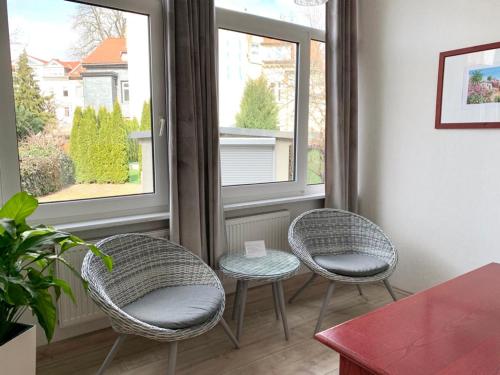
Pension Gerber in Erfurt is a charming, family-run guest house located about 800 meters from Erfurt Cathedral. In bright rooms equipped with a flat-screen TV, you can relax after a day in the city. The relatively central location allows you to reach the heart of Erfurt’s Old Town in just 15 minutes on foot.
The warm atmosphere and personal service are particularly noteworthy, turning your stay into a unique experience.
Check further info, prices, and availability of Pension Gerber
Is the Erfurt Card worth it
The Erfurt Card includes free admission and discounts to various facilities in the city for 48 hours . You can currently purchase it online or at the local tourist information office for €14.90 .
If you would also like unlimited travel on public transportation, you can purchase the ErfurtTravelCard for €21.90 .
When you follow our Erfurt 2-day itinerary and want to see all the sights (+ Mediaguide at the Andreasstraße Memorial), the ErfurtCard will pay for itself .
If you also want to visit other sights, like the museums on our list of additional attractions, the ErfurtCard is definitely worth it.
The ErfurtTravelCard, on the other hand, is only recommended if you have limited mobility, are traveling with (small) children, or are dependent on public transportation for some other reason.
Ideally, you should think about which sights you want to see before you arrive and do a quick calculation to see if the ErfurtCard is worth it for your trip.
FAQs about traveling to Erfurt
It is recommended to spend at least 2 days in Erfurt to see the main sights of the city.
With its relatively small size, Erfurt is ideal for exploring on foot, as most of the sights are located right in the city center.
In Erfurt, especially Thuringian dishes are enjoyed, such as the Thuringian Rostbratwurst or Thuringian dumplings. In winter, you should try the Erfurt Schittchen (Stollen Christmas Cake).
When you visit Erfurt, you should see the Erfurt Cathedral and the St. Severi Church. Another landmark of the city is the Krämerbrücke in the historic center.
The broad bean “ Erfurter Puffbohne ,” with its high protein content and cultivation, has a long tradition in the region of Erfurt. Therefore, today, it is considered a city symbol and a popular souvenir.
As the capital of Thuringia, Erfurt is considered one of the most influential cities in Germany.
The river that flows through Erfurt is the Gera. In Erfurt, however, the part of the river that flows through the city center is also called Breitstrom .

Interested in Germany?

About the Author Vicki
Hi, we are Vicki & Eduardo, an international travel couple on a mission to help you save money for priceless travel experience. Follow us through the miracles of this world and you will be rewarded with a bunch of practical travel tips.
Leave a Comment Cancel reply
This site uses Akismet to reduce spam. Learn how your comment data is processed .
- The Best Things To See...
The Best Things to See and Do in Erfurt, Germany

Erfurt , the capital and biggest city of the German state of Thuringia, is often skipped by tourists. However, those who take the time to delve into its historic, charming heart are rarely disappointed. This 1,200-year-old city is best known as the location where Martin Luther, one of the most inspiring figures in Christian history, became a monk in 1505. The skyline of Erfurt is punctuated with beautiful architecture and the city offers a wealth of natural, historical and cultural attractions to fill several busy vacation days. Let’s take a look at the best that Erfurt has to offer.
Erfurt cathedral.
Market, Cathedral, Market
Augustinian Monastery

Augustinian Monastery has immense historical importance, as it was here that Martin Luther became a monk in 1505 and lived for several years. This 13th-century monastery offers guided tours to the public, including stops at Martin Luther’s room, and an exhibition and several monuments dedicated to the visionary. Visitors also get to see a beautiful chapel and murals.
Zitadelle Petersberg
Erfurt synagogue.

Become a Culture Tripper!
Sign up to our newsletter to save up to $1,200 on our unique trips..
See privacy policy .
Merchants' Bridge
Bridge, Church
Angermuseum
Building, Museum

Schloss Molsdorf

Culture Trip Summer Sale
Save up to $1,200 on our unique small-group trips! Limited spots.

- Post ID: 1784073
- Sponsored? No
- View Payload
Your browser is set to private mode. To continue reading, please log in or subscribe.
Get unlimited access today for only
$9.99 / month
Subscribe now
Being Black in Germany has never been easy. Elections in eastern states could make it harder still
The eastern german states of thuringia, saxony and brandenburg are set to elect new parliaments next month, and in all three states the far-right alternative for germany, or afd, is ahead in the polls.

ERFURT, Germany (AP) — It was a balmy summer night in 2020, shortly after the lifting of Germany’s first COVID-19 lockdown, and Omar Diallo and two friends from his home country of Guinea wanted to celebrate Eid al-Adha, the Muslim festival of sacrifice.
“We were enjoying life, playing music, walking through the city at night — we just wanted to be together again and have a good time,” Diallo, 22, told The Associated Press in Erfurt, in the eastern state of Thuringia.
He was not prepared for how the day would end. Suddenly Diallo and his friends were confronted by three black-clad white men.
“They were shouting: ‘What do you want here, f-——- foreigners, get out’!” Diallo remembered.
“First there were three, then five, seven — they were surrounding us from all sides. We couldn’t run away, and then they started chasing us,” he said.
At some point Diallo managed to call the police, and when the officers finally arrived, the attackers ran away. One of his friends was beaten up so badly that he had to be hospitalized.
“I simply tried to survive,” Diallo said. “I hadn’t done anything wrong. It all happened only because of my skin color.”
Being Black in Germany has always meant exposure to racism, from everyday humiliations to deadly attacks. In eastern Germany, the risk can be even greater.
After World War II, West Germany became a democratic, diverse society but in East Germany, which was run by a communist dictatorship until the end of 1989, residents barely had any contact with people of different ethnicities and were not allowed to travel freely abroad.
Experts say that specifically in Thuringia, radical far-right forces have created an environment that’s hostile toward minorities, including Black people.
Now, with the rise of the far-right Alternative for Germany, or AfD, Black Germans and African migrants like Diallo are growing increasingly concerned.
Thuringia, which has a population of 2.1 million,holds state elections on Sept. 1, and the fiercely anti-immigration AfD is leading the polls, on 30%.
In 2023, the NGO Ezra, which helps victims of far-right, racist and antisemitic violence, documented 85 racist attacks in Thuringia, down only slightly from 88 attacks in 2022, which Ezra described as “an all-time high of right-wing and racist violence” in the state.
“In recent years, an extreme right-wing movement has formed in Thuringia, which has contributed to a noticeable ideological radicalization of its followers. Politically, the Alternative for Germany party is the main beneficiary,” Ezra and a consortium of organizations tracking racism wrote in their annual report.
AfD’s Thuringia branch is particularly radical and was put under official surveillance by the domestic intelligence service four years ago as a “proven right-wing extremist” group.
“Authoritarian and populist forces, which are becoming very strong here now, harbor a great danger in Thuringia,” says Doreen Denstaedt, Thuringia’s minister for migration, justice and consumer protection.
Denstaedt, the daughter of a Black father from Tanzania and a white German mother, was born and grew up in Thuringia.
The 46-year-old member of the Green party said that growing up in Communist East Germany, she was “always the only Black child.” As a teenager, she was never allowed to go home on her own because of the risk of racist attacks, and she sometimes suffered racist slurs in her school.
“I actually experienced myself that people called me a foreigner, which really confused me at first, because I was born in Saalfeld” in Thuringia, Denstaedt said.
She fears that in the current political climate, racist narratives will become acceptable in the middle of society.
“My biggest concern is that people do not question (these prejudices), especially if they are not affected themselves,” she said.
It’s not exactly clear how many Black people live in Germany nowadays, as different ethnicities are not documented in official statistics, but estimates put the number of people of African descent at 1.27 million. More than 70% were born in Germany, according to Mediendienst Integration, which tracks migration issues in the country.
Germany’s history of racial discrimination begins long before the Nazis began excluding, deporting and ultimately murdering Black people in the 1930s and 1940s.
The German Empire held numerous colonies in Africa from 1884 until the end of World War I. These included territories in present-day Tanzania, Burundi, Rwanda, Namibia, Cameroon, Togo and Ghana.
The German government has only recently started dealing with the injustices committed during that period. In 2021, President Frank-Walter Steinmeier called on Germans to face the country’s cruel colonial past, and in 2023, he apologized for colonial-era killings in Tanzania over a century ago.
Daniel Egbe, a 58-year-old chemist from Cameroon who moved to Thuringia in 1994 to study, says he’s shocked how little Germans know about their colonial history. He says this ignorance may also factor into the unequal treatment of Black people.
“I’ve been teaching classes in school,” Egbe told the AP. “I tell them a bit about myself and especially the fact that Cameroon was a German colony. Many students don’t know anything about Africa or about the German past and it must be put on the map.”
Egbe, who took German citizenship in 2003, founded AMAH, an organization that helps university students and migrants from Africa when they experience discrimination in the city of Jena, in eastern Thuringia.
He’s worried about the rise of the AfD but has no intention of leaving.
“We won’t leave, we will do our part to change this society,” he said. “People are mostly afraid of what and who they don’t know. We have to change things through education.”
As for Diallo, the Guinean who was attacked in Erfurt four years ago, he also vowed to help improve the situation for Black people in Germany.
Even though the attack traumatized him, it also empowered him to fight for justice, he said. A year ago, he enrolled in university in Munich to study law, but he still visits Erfurt frequently, where he supports Youth without Borders, a network of young migrants.
“I don’t exactly know yet how I’m going to change Germany, but I know I will,” he said.
Related Stories
- Coffee House

The AfD is winning over Germany’s youth
- 2 September 2024, 12:48pm

Lisa Haseldine

‘We are the party of the youth!’ When the far-right Alternative für Deutschland (AfD) party launched its state election campaign over the summer in the former east Germany, its lead candidate for Brandenburg Christoph Berndt confidently declared that the party would do well thanks to the legions of young voters it had seduced. Today, as the dust settles on the results of Thuringia and Saxony’s state elections, it appears that Berndt’s predictions have come to pass.
According to data published by the pollsters Infratest Dimap, 38 per cent of those aged between 18 and 24 voted for the AfD in Thuringia on Sunday. In neighbouring Saxony, 31 per cent did the same. In both states, the party was able to increase its vote share among this age group by at least 11 per cent to become the most popular party with young Germans. Approximately one in three Germans under the age of 34 voted for the AfD.
Approximately one in three Germans under the age of 34 voted for the AfD
Politicians in Berlin will be viewing this weekend’s results with mounting panic. With a year to go until Germany’s federal election, it is hard to deny the AfD’s claim that it is the ‘party of the future’ – at least in eastern parts of Germany, based on this weekend’s results. By contrast, the parties of Chancellor Olaf Scholz’s traffic light coalition (the Greens, FDP and SPD) have managed just a cumulative 17 per cent in Saxony and 13 per cent in Thuringia.
There are several reasons for the AfD’s success with Germany’s young people – none of which have a straightforward solution. With a stagnating economy, a growing housing crisis and the government’s insistence on implementing expensive net zero policies, such as a ban on combustion engine cars and gas boilers, the AfD’s conservative attitude to these issues feels refreshing for many – and, surprisingly, has drawn in a younger voter demographic.
Most popular
The two winners from the first tory leadership round.

The party has been particularly successful at connecting with Gen Z voters over social media. On TikTok and Instagram, the AfD’s simplistic messaging – mostly centred around a fervently anti-migrant rhetoric – has resonated with young people. Alexander Klause, 29, stood as a candidate in the Thuringian city of Erfurt. When I spoke to him in July, he said he believed Germany’s youth is bearing the brunt of the economic and societal issues the country is facing, most of which, according to him, have a root in migration. ‘Young people travel on trams, they sit in buses, they are out and about in public places at night and are, of course then subjected to violence, which is largely committed by foreigners.’ He hastily followed up: ‘There are always exceptions, of course. I don’t want to generalise.’
The AfD’s opposition to lending support to Ukraine in the ongoing war with Russia has also struck a chord with many young Germans. The party has framed its desire for Ukraine to hasten the start of peace negotiations with Russia as an issue of peace and security for Germany – although their critics would suggest this is, in fact, appeasement of president Putin and his regime. Nevertheless, for young Germans scared that an escalation in the war could lead to their country, and them, being directly sucked into a wider conflict, the AfD’s message has patriotic appeal. One AfD supporter I spoke to in Thuringia, 32-year-old Bastian Michaelson, explained why the party appealed to him: ‘I’m a patriot through and through and very attached to history, especially German history. And that’s why for me it feels intuitive to support every patriotic movement and party that presents itself to this country.’
This weekend’s results build on the successful outcome for the AfD in June’s European election when 16 per cent of 16-24 year olds voted for the party. That, by and large, they have been able to double that with a smaller voter demographic (voting age in the European elections is lower), will be viewed as a triumph by the party.
Despite the AfD’s success over the weekend, coming first overall in Thuringia and second in Saxony, the ‘firewall’ thrown up around them by their opponents means the likelihood that they will take any meaningful power at a state level is shrinking. But the success they have had amongst the country’s young people is bound to buoy the AfD as it looks ahead to next year and the campaign to take Berlin by storm.
Watch more from Lisa Haseldine, Katja Hoyer, and Constantin Eckner on SpectatorTV:
No one wants to help the SNP

Also in Europe
How long can Macron ignore French voters?

Also by Lisa Haseldine
The AfD is set to win its first ever state election

Which schools get the most pupils into Oxbridge?

Comments will appear under your real name unless you enter a display name in your account area. Further information can be found in our terms of use .
Advertisement
Supported by
The East Rises in Germany, and So Does Political Extremism
Closely watched elections in the former East Germany are likely to reveal a still-divided country and yield a worrying challenge to Berlin.
- Share full article

By Steven Erlanger
Steven Erlanger traveled for three days through Thuringia, one of the three East German states holding elections in September.
Anna Wenske, 69, worked for decades at the national theater of East Germany, where she was born and still lives. “After the reunification, everything went kaput,” she said. She lost her job and her savings; it took her years of part-time work to reach a kind of equilibrium.
Now she resents what she considers the easy path offered to refugees while Germans suffer.
“Too many people exist on this planet and everyone wants to come to us,” she said in a sunny Weimar, “and we tell everyone welcome and we have nothing left for ourselves.” When it comes to Ukraine , she said, President Vladimir V. Putin of Russia lied when he said he would not invade, “but I don’t trust the United States any more than Russia.”
When her state, Thuringia, holds elections on Sunday, she says she will probably support the Alternative for Germany party. The radical right ethnonationalist party, known as the AfD, plays with Nazi-era language and its state branch has been classified by domestic intelligence as right-wing extremist .
But she is also tempted by a newer party, the Sahra Wagenknecht Alliance , or BSW, named for the former Communist who founded and leads it. Though the party abhors Nazism and supports the Constitution, it holds many of the same views as the AfD. “When I listen to Sahra, somehow she touches me,” Ms. Wenske said.
Germany is facing three critical state elections — Saxony also votes Sunday and Brandenburg on Sept. 22 — all in the former East Germany, where polls show such grievances are pushing many voters to the extremes, whether left or right. The expected results are already causing much hand-wringing in Berlin about the future of German democracy and the country’s failure to integrate east and west even 33 years after reunification.
The votes are being seen as a bellwether for the federal elections in September 2025, if the current government lasts that long. The three-party coalition of Chancellor Olaf Scholz is so paralyzed and unpopular that prominent members of one partner, the Greens, talk openly of a government out of ideas.
But more than anything, these elections are expected to show the persistent divisions in politics and social attitudes between west and east Germany, where extremist parties like the AfD have made by far their deepest inroads. Their success is changing the political debate nationwide, especially around issues like migration and support for Ukraine in its war against Russia.
After Friday’s knife attack in the western city of Solingen , where prosecutors say a Syrian refugee killed three people and wounded eight, the AfD and Ms. Wagenknecht have trumpeted their plans to control illegal migration and deport those who do not qualify for asylum, like the Syrian man.
That has pushed Mr. Scholz of the Social Democrats, which has lost many voters in the east, to vow to step up deportations and call for tougher European laws on asylum and deportation.
The issues of refugees, migration and knife crimes have added to the sense of estrangement in the east. In addition, the attitudes, experiences and language bred over 40 years of East German sovereignty, passed down generation to generation, are for many a source of identity and pride.
A Country Within a Country
Even today the east remains virtually a country within a country, akin to Sicily in Italy, perhaps, or Flanders in Belgium.
There remains a strong feeling of having been mocked and colonized by West Germany after unification. There is also deep sympathy for Russia, rooted in persistent anti-Americanism, where Washington is still seen as dominating German foreign policy and leading the country astray.
The AfD wants to pull Germany out of the West, out of the European Union and NATO. Some of its election posters show the German and Russian flags commingled, with the slogan: “The East does it!” or “The East is rising!”
The BSW says it wants to work within the European Union to improve it, and to ensure that NATO remains “a security union and not an alliance for war,” as its leading candidate, Katja Wolf, said.
Both are openly national socialist parties, stressing German interests and economic help to pensioners and the unemployed, who feel victimized by the aid to migrants. And both are deeply sympathetic to Russian interests and oppose further military aid to Ukraine.
Those positions are resonating. Including The Left party, the inheritor of the Communist Party, parties on the far right and far left are expected to win up to 65 percent of the votes on Sunday, according to the most recent polls in Thuringia, more than 50 percent in Saxony and about 45 percent in Brandenburg. The AfD leads in all three states.
While the center is shrinking, not everyone is ready to embrace the fringe. Though he shared many of the same views as Ms. Wenske, the retiree, Jens Wickmann, an elevator technician with three children, said he would not vote for the AfD.
“I don’t want Björn Höcke ,” the AfD leader in Thuringia whom many consider a neo-Nazi, Mr. Wickmann, 56, said in the little town of Nohra. “It harms our country. We’re not Nazis.” Instead, he said, he will probably vote for the Christian Democratic Union, the center-right party that is second in the polls and is the main opposition party in Berlin.
Mr. Scholz’s Social Democratic Party, by contrast, is expected to get only 6 percent of votes in both Thuringia and Saxony. It is possible that none of the parties in his coalition, which also includes the business-friendly Free Democrats as well as the Greens, will make it above the 5 percent needed to get into the state parliaments.
Why the East Is the East
The through-the-looking-glass nature of politics in the east has proved endlessly vexing to the leadership in Berlin, as well as to the mainstream parties that once dominated German politics. It has as much to do with history as with any of the problems Germany faces.
The burden of the past is everywhere in East Germany, but doubled. First there were the Nazis, which East Germany officially labeled a West German phenomenon. Then came the legacy of the German Democratic Republic, the former Soviet-occupied East Germany, which lasted 40 years and self-identified as antifascist and anti-Western.
Steffen Mau, a sociologist at Humboldt University, said the polls underscored his thesis that German unification has not produced assimilation but in fact has solidified lasting differences between western and eastern Germany.
In an interview and a recent book, “Unequally United,” he argues that “it was an illusion that unification would bring together two things artificially separated, because over 40 years two very different societies have developed, with very different social structures.”
While western Germany is a middle-class society, the east, which lost many of its jobs soon after unification, is still relatively poor, with little accumulation of wealth, he said.
In the east, the Communist state and party and large state-owned enterprises prevented the growth of civil society, with little role for the churches or the trade unions.
“It all disappeared overnight, creating a vacuum, and right-wing actors like the AfD saw an opportunity, with a frustrated population that was homeless ideologically,” Mr. Mau said.
Is the East the Future?
Even today, party affiliations are much weaker and more volatile in the east, with more votes on the extremes and fewer for traditional centrist parties.
That “may be a harbinger of Germany’s future,” said Thorsten Benner, director of the Global Public Policy Institute in Berlin.
The BSW is the wild card. Formed only in January by dissidents from The Left party, it does not have the same stigma among some voters as the AfD, which the domestic intelligence service considers to have many extremists in its ranks.
While the AfD may get the most votes in these elections, it is shunned by all of the other parties, which vow not to collaborate with it.
That is likely to render BSW, which is running third in all three states, a key coalition partner, presenting difficult choices for the Christian Democrats, who need a partner party in the east but have ruled out a coalition with the AfD or The Left.
The C.D.U.’s lead candidate here, Mario Voigt, says the party is concentrating on topics like energy prices, education, health care and migration. “We want to frame the race around issues here that matter for the next five years and tell people not to fall into protest votes.”
Mr. Voigt admits that he benefits from fears about Mr. Höcke, the AfD leader in Thuringia. But his party has already toughened up its line on illegal migration and is sounding softer on future aid to Ukraine, much as the federal government is.
The only realistic response to the extremist parties is to try to keep them small, said Daniela Schwarzer, a political scientist and board member of the Bertelsmann Foundation, a nonprofit institute devoted to civic participation. “The hope is to demystify them before they get into office” and contain them to the regional level, she said.
But success even at a regional level would be a big breakthrough for either the AfD or BSW, with the potential for normalizing a more extremist politics in the months to come.
Tatiana Firsova contributed reporting.
Steven Erlanger is the chief diplomatic correspondent in Europe and is based in Berlin. He has reported from over 120 countries, including Thailand, France, Israel, Germany and the former Soviet Union. More about Steven Erlanger
Germany's Far Right Set to Win Eastern Region Vote
Germany's Far Right Set to Win Eastern Region Vote

Thuringia State Premier Bodo Ramelow, CDU candidate Mario Voigt, and Bjorn Hocke of the AfD, Erfurt, September 1, 2024. REUTERS/Thilo Schmuelgen
By Thomas Escritt and Sarah Marsh
BERLIN (Reuters) -The Alternative for Germany (AfD) was on track to become the first far-right party to win a regional election in Germany since World War Two, projections showed, giving it unprecedented power even if other parties are sure to exclude it from office.
The AfD was set to win 33.2% of the vote in the state of Thuringia, comfortably ahead of the conservatives' 23.6%, broadcaster ZDF's projection showed on Sunday, a vote share that, depending on final seat allocations, could let it block decisions requiring a two-thirds majority.
The appointment of judges or top security officials are among such decisions. If the AfD, led in Thuringia by Bjoern Hoecke - its most extreme and controversial figure - decides to block them, it could weaken an apparatus, built up painstakingly over decades, designed to police and disrupt far-right forces.
In neighbouring Saxony, projections put the conservatives, who have run the state since 1990, on 31.5%, just 1.1 percentage points ahead of the AfD.
Conservative state premier Michael Kretschmer, who hailed the result as a success and a mandate to form a new government, blamed the strength of the far right on Social Democrat Chancellor Olaf Scholz's fractious coalition in Berlin.
"There is a huge lack of trust in politics that has to end," he said. "We need another political style in Berlin."
With a year to go until Germany's national election, the results are punishing for Scholz's coalition. All three ruling parties lost votes, with only his SPD comfortably clearing the 5% threshold needed to stay in parliament.
The anti-immigration AfD may have drawn momentum in the final week of the election from a deadly knife attack at a festival in the western city of Solingen, allegedly by an illegally resident Syrian national whom authorities had failed to deport.
"This is a requiem for the coalition," said the AfD's joint leader Alice Weidel. "The coalition should ask itself whether it can continue to govern at all."
The left populist Sahra Wagenknecht Alliance (BSW), which like the AfD wants less immigration and an end to arming Ukraine, came third in both states just eight months after its founding.
'NORMALISING FASCISM'
With all parties having ruled out working with the AfD, the BSW could be crucial to forming a stable government in the two states, which lag western Germany economically more than three decades after reunification.
Sahra Wagenknecht said her party hoped to form a government with the conservatives and other parties in Thuringia but would insist on a different approach to Ukraine - even though that lies far outside a regional government's competence.
The disastrous result for Scholz's coalition could further stoke conflict within it as all three parties seek to reassert their identity ahead of next year's national election.
For Weidel, her party's strong performance in both states was evidence that it was no longer possible to keep her party out of power.
"The voters want the AfD in government", she said. "Without us, a stable government is not possible."
Bodo Ramelow, the premier of Thuringia, whose Left party was battered despite his personal popularity, said all democratic parties now had to work together.
"I am not fighting the conservatives. I am not fighting the BSW. I am fighting the normalisation of fascism," he said.
(Additional reporting by Riham Alkousaa, writing by Thomas Escritt, editing by Thomas Seythal, Barbara Lewis and Philippa Fletcher)
Copyright 2024 Thomson Reuters .
Photos You Should See - July 2024

Join the Conversation
Tags: Europe , Germany
America 2024

U.S. News Decision Points
Your trusted source for the latest news delivered weekdays from the team at U.S. News and World Report.
Sign in to manage your newsletters »
Sign up to receive the latest updates from U.S News & World Report and our trusted partners and sponsors. By clicking submit, you are agreeing to our Terms and Conditions & Privacy Policy .
You May Also Like
The 10 worst presidents.
U.S. News Staff Feb. 23, 2024

The Best Cartoons on Donald Trump
Sept. 3, 2024, at 3:12 p.m.

Joe Biden Behind The Scenes
Aug. 20, 2024

More Mosquitoes, More Illnesses
Steven Ross Johnson Sept. 4, 2024

Job Openings Continue to Fall
Tim Smart Sept. 4, 2024

RFK Jr.’s Election Scheme Hits a Snag
Laura Mannweiler Sept. 3, 2024

What to Know: Hostages Held by Hamas
Cecelia Smith-Schoenwalder Sept. 3, 2024

The Week in Cartoons Aug. 2-6

Jobs Data Offers Key Pre-Vote Econ Image
Tim Smart Sept. 3, 2024

Harris Presses On, Trump Presses Reset
Lauren Camera Sept. 2, 2024

Germany: Far-right AfD party wins state election for first time
The party won 32.8% of the vote in Thuringia, followed by the centre-right Christian Democratic Union (CDU) with 23.6%.
Monday 2 September 2024 02:39, UK

A far-right party has won a regional election in Germany for the first time since the Second World War.
Alternative for Germany (AfD), founded in 2013 with an anti-migration and eurosceptic agenda, picked up the most votes in the eastern state of Thuringia.
The party won 32.8% of the vote, followed by mainstream conservatives the centre-right Christian Democratic Union (CDU) with 23.6%.
It is the first time a far-right party has won the most seats in a German state parliament since the Second World War.
But AfD is almost certain to be excluded from power by rival parties.
AfD also performed well in the neighbouring state of Saxony, where it was a close second behind the CDU by just half a percentage point, a ZDF exit poll said.
The CDU, which has governed Saxony since German reunification more than 30 years ago and is the main opposition party at national level, appeared set to secure 32% of the vote in the state.
More on Olaf Scholz

Starmer wants reset with EU - 'but that does not mean reversing Brexit'

Sir Keir Starmer in Germany as he seeks to 'rebuild' EU relations post Brexit

German chancellor Olaf Scholz vows to increase deportations of rejected asylum seekers after Solingen knife attack
Related Topics:
- Olaf Scholz
But the AfD was narrowly behind with 31.5% on Sunday, according to the poll.
Speaking after the results, AfD's leader in Thuringia Bjorn Hocke said he felt "a great, great deal of pride".
However, when it was pointed out that Germany's domestic intelligence agency has his local party branch under official surveillance as a "proven right-wing extremist" group, he bristled at the question and said: "Please stop stigmatising me. We are the number one party in Thuringia.
"You don't want to classify one-third of the voters in Thuringia as right-wing extremists."
Hocke himself has been convicted of knowingly using a Nazi slogan at political events - he is appealing.
Celebration and devastation after state elections

Europe correspondent
The exit polls predicting the far-right Alternative for Germany party (AfD) has won the most seats in Thuringia's state parliament sparked both celebration and devastation.
Huge cheers erupted from the pub where the party faithful were holding their watch party.
The news they were coming a close second in neighbouring Saxony will have buoyed them further.
If the win in Thuringia is confirmed, this will be the first time since World War Two that a far-right party has the most seats in a German state parliament.
Anti-immigration, populist messages of "Germany first" appealed to many voters in the former communist east where numerous people told me they feel forgotten or disconnected from the national government.
But other residents who were casting their votes in Erfurt on Sunday were deeply unnerved by the idea that the far-right might seize victory.
They know that a pact by other parties not to go into coalition with the AfD means it is unlikely to get full control of Thuringia's parliament but the fact it has won such a huge slice of support is disturbing to some who fear Germany is stepping in a dangerous direction.
The AfD in Thuringia is being monitored by state intelligence authorities as "extremist", and their top candidate, Bjorn Hocke, was this year found guilty of using a banned Nazi slogan - yet it appears one in three voters still backed them.
That has disturbed some Germans, as voter David warned: "In our history, we have had national socialist movement in 1933 in Weimar and hopefully we will not repeat it again."
About 3.3 million people were eligible to vote in Saxony and nearly 1.7 million in Thuringia.
The left populist Sahra Wagenknecht Alliance (BSW), which like the AfD demands stricter controls on immigration and wants to stop arming Ukraine, came third in both states, with up to 16% of the vote in Thuringia and 12% in Saxony.
Please use Chrome browser for a more accessible video player

Setback for German chancellor's coalition
The far-right success is a blow to the coalition of German Chancellor Olaf Scholz just a year before the federal election in September 2025.
Mr Scholz's Social Democratic Party (SPD) currently governs nationally with the Greens and liberal Free Democrats (FDP). Those parties had weak results on Sunday.

AfD is unlikely to be able to form a state government as it is short of a majority and other parties refuse to collaborate with it.
Read more: Analysis: Vote gives far-right chance to tighten grip in Germany Explainer: State votes could act as a bellwether
AfD is strongest in the formerly communist east, and the domestic intelligence agency has the party's branches in Saxony and Thuringia under official surveillance as "proven right-wing extremist" groups.

Immigration was pushed to the top of the country's political agenda after three people were killed in a knife attack by a suspected Islamic extremist at a festival in Solingen, western Germany, on 23 August.

Keep up with all the latest news from the UK and around the world by following Sky News
Be the first to get Breaking News
Install the Sky News app for free

Hocke, a former history teacher, is a polarising figure who has called Berlin's memorial to Nazi Germany's Holocaust of Europe's Jews a "monument of shame".
Related Topics
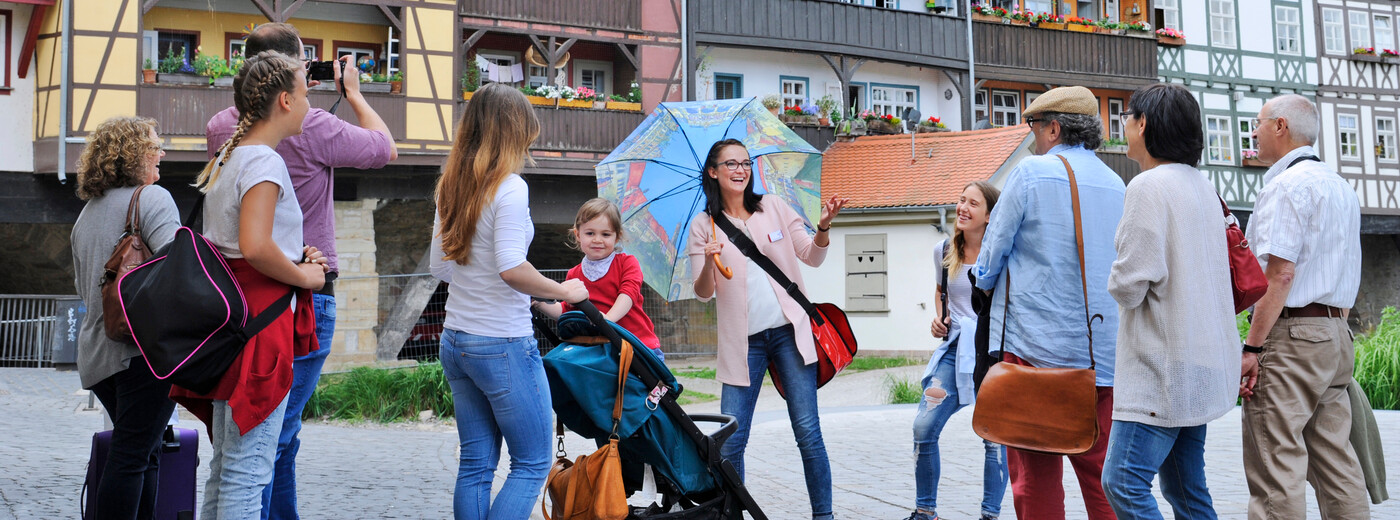
Erfurt - A Fascinating History Experience
Photo: B. Neumann
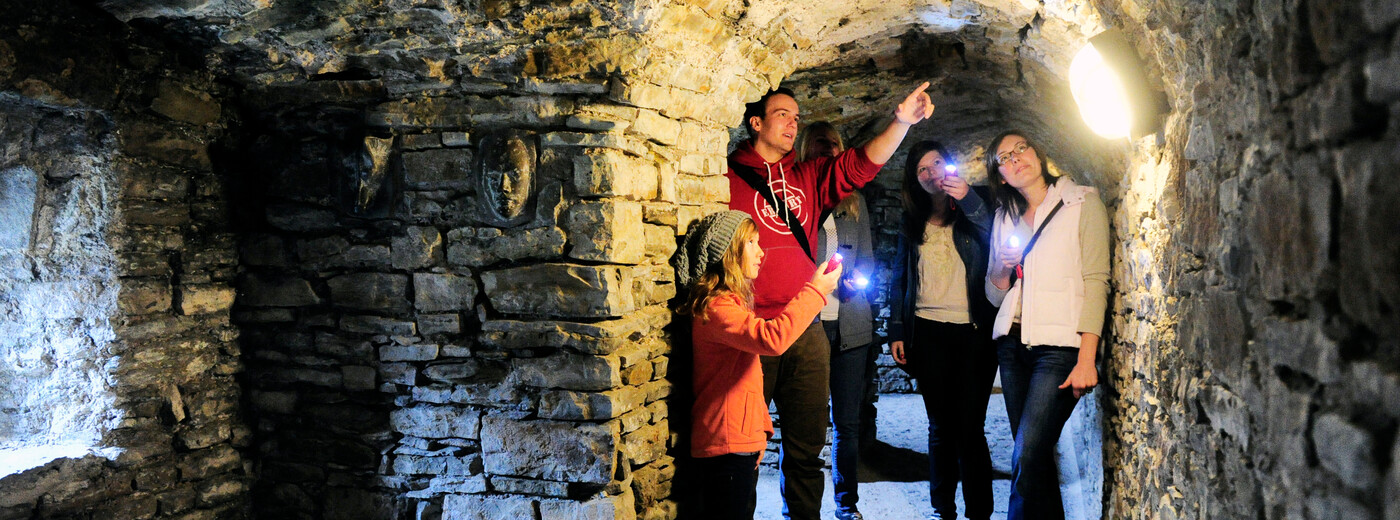
Flying Visit to Petersberg

Old Quarter Tour

Gastronomic experiences for groups
Erfurt invites you to a rendezvous in the heart of germany..., guided tours and sightseeing trips.
We offer a whole host of public guided tours, some of which take place daily. And if you're travelling as a group, we will happily organise private tours tailored to any interests or special requirements you might have. Advance bookings are required.
Groups are also welcome to join one of our public guided tours. All we ask is that you give us prior notice.

Tours & experiences for groups
We can organise guided tours for families, clubs, companies and tour groups on a day and at a time to suit you.

Multimedia guides
Discover Erfurt under your own steam with our multimedia city guide.

Gastronomic experiences
Visitors to Erfurt are often surprised to discover a host of other delicacies in addition to local classics such as Thuringian dumplings and bratwurst.

- Incentive activities and entertainment
Our conventions and conferences division can also work with you to put together a supporting programme or organise motivational activities.

Catherine Leifheit Manager city tours Benediktsplatz 1 99084 Erfurt +49 361 - 66 40 120 [email protected]

Franziska Gebauer city tours Benediktsplatz 1 99084 Erfurt +49 361 - 66 40 120 [email protected]
All about Erfurt
- Main topics
- Places of interest
- Famous individuals
- Location and travel information
- Food, drink & eating out
- Horticulture
Guided tours & experiences
- Tours & experiences for groups
Accommodation
- Budget Travelling
- Accommodation packages
- Accommodation Guide 2020
- Highlights 2024
- Theatre, Comedy and Revues
- Concerts and Dance
Conferences & conventions
Copyright © 2024 Erfurt Tourismus & Marketing GmbH
Webseite Erfurt Stadtmarketing

Die offizielle Seite des Stadtmarketings der Landeshauptstadt Erfurt. Informationen zu den Themen Bildung, Wirtschaft, Leben & Einkaufen, Sport, Tagungsstandort und vieles mehr..
Zur Website
Webseite Petersberg
This website uses cookies. Those have two functions: On the one hand they are providing basic functionality for this website. On the other hand they allow us to improve our content for you by saving and analyzing anonymized user data. You can redraw your consent to using these cookies at any time. Find more information regarding cookies on our Data Protection Declaration and regarding us on the Imprint .
These cookies are needed for a smooth operation of our website.

IMAGES
VIDEO
COMMENTS
Location and travel information. Outstanding transport connections mean that Erfurt is within a few hours' reach of most places by car, rail or air. Presentation of the tourism services on offer from the City of Erfurt with accommodation, guided tours, all-inclusive breaks in Erfurt and much more.
Let's have a look at the best things to do in Erfurt: 1. Krämerbrücke (Merchants' Bridge) Source: Shutterstock. Krämerbrücke. An enchanting slice of Medieval history, the Krämerbrücke is a bridge lined with half-timbered houses crossing a branch of the River Gera.
An old-fashioned bridge and street lined with pretty houses dating back to the Renaissance. See way to experience (1) 2024. 2. Erfurt Cathedral. 622. Churches & Cathedrals. By francien2015. Right in the old centre of Erfurt there is a hill and on top of it a marvellous Gothical Cathedral and church.
Website: www.erfurt-tourismus.de. Inhabitants: 213.699. Federal state: Thuringia. Area in square kilometres: 269,88 square kilometres. St. Augustine's Monastery, where Martin Luther spent five years of his life, the Predigerkirche church and the fortifications of Petersberg Citadel are superb examples of Medieval and modern-era architecture.
By worm91dj. Beautiful platz in front of the Dom. These days there is a small amusement park, soon will be a christmas market. 4. Petersberg Citadel. 293. Points of Interest & Landmarks. By francien2015. The Pietersberg citadel immediately underlines the interest of the city of Erfurt in the past.
These family-friendly adventures are hosted daily by Erfurt Tourist Information. You can find out more about the best places to visit with our list of the top tourist attractions and things to do in Erfurt, Germany. ... 99084 Erfurt, Germany. See Europe's Oldest Synagogue and its Historic Treasures The Old Synagogue. Built around AD 1100, the ...
Why not meet up with us in the heart of Germany and experience the many delights of this hospitable city for yourself? Main topics. ... Erfurt Tourist Information Benediktsplatz 1 99084 Erfurt +49 361 - 66 400 [email protected]. Discover Erfurt - the capital of Thuringia.
Discover the city's many cultural and architectural treasures and succumb to the charms of Erfurt's romantic old quarter: Germany's largest single heritage site is a popular spot for locals and tourists alike, thanks to its medieval architecture and fascinating history. With its ancient abbey, magnificent churches, the Erfurt Treasure and grand ...
8. Augustinian Monastery (Augustinerkloster) Augustinian Monastery. For anyone interested in history, particularly the Reformation and Martin Luther, you won't want to miss visiting this one of the things to do in Erfurt. The Augustinian Monastery was home to Martin Luther from 1505 to 1511.
Erfurt. Erfurt, Thuringia's capital, is one of central Germany's most beguiling and significant cities. Holding its head as high as the former capital to the east, Weimar, it's a wonderfully preserved medieval city of grandiose churches, cobbled market squares, captivating museums and miraculously preserved architecture.
Kunsthalle Erfurt. Erfurt. Erfurt's most experimental art space offers a rigorously curated program of exhibitions, incorporating graphic art, audiovisual art and installations. Discover the best attractions in Erfurt including Zitadelle Petersberg, Erfurter Dom, and Augustinerkloster.
Table of Contents. Must-See Spots in Erfurt. Visit Krämerbrücke (Merchant's Bridge) Admire Erfurt Cathedral and St. Severus Church. Erfurt Christmas Market. Best Shops to Visit in Erfurt. Qnik Papeterie. Schmuck & Objekt Ute Wolff-Brinckmann. Erfurter Blau.
Fischmarkt Square, Erfurt. Domplatz architecture, Erfurt old town. Krämerbrücke (Merchant's Bridge), a landmark of Erfurt city. A cobbled street of galleries and shops on the Krämerbrücke. River Gera waterfront in Erfurt. Die Alte Synagogue (Old Synagogue), from the first Jewish community in Erfurt. Erfurt neo-Gothic City Hall.
Erfurt's old town is one of the best preserved medieval city centres in Germany. [4] Tourist attractions include the Merchants' Bridge (Krämerbrücke), the Old ... The Krämerbrücke (Merchants' bridge) is the most famous tourist attraction of Erfurt. This 15th-century bridge is completely covered with dwellings and unique in Europe north of ...
Walk the Krämerbrücke. The Krämerbrücke is THE reason people know Erfurt! You will not visit Erfurt and miss the Krämerbrücke. You simply cannot! Also known as the "Merchant's Bridge", the Krämerbrücke is a gorgeous medieval-era stone arch bridge that was originally built back in 1325.
743. from $95/night. Dorint Hotel am Dom Erfurt. 835. from $127/night. ibis Erfurt Altstadt. 296. from $79/night. Hotel Krämerbrücke Erfurt.
A list of the top tourist attractions and places to visit in Erfurt, the capital of Thuringia. Erfurt is a young and vibrant city with a visible history of more than 1,000 years. With a population of barely 200,000 people, it might not be the biggest capital of a German state, but it's certainly one of the most charming.
Home Germany Ultimate Guide to Sightseeing in Erfurt, Germany. Ultimate Guide to Sightseeing in Erfurt, Germany. by David August 20, 2019. August 20, 2019. 3.5K. ... *Disclosure: I received an Erfurt City Card and a night's accommodation courtesy of Erfurt Tourism. As always, opinions are completely and genuinely my own.
The Erfurt Card includes free admission and discounts to various facilities in the city for 48 hours. You can currently purchase it online or at the local tourist information office for €14.90. If you would also like unlimited travel on public transportation, you can purchase the ErfurtTravelCard for €21.90.
Erfurt, the capital and biggest city of the German state of Thuringia, is often skipped by tourists. However, those who take the time to delve into its historic, charming heart are rarely disappointed. This 1,200-year-old city is best known as the location where Martin Luther, one of the most inspiring figures in Christian history, became a monk in 1505.
Erfurt, Germany Where is Erfurt? Erfurt is the capital of Thuringia and the largest city in the state. It is a road and rail transport junction and houses the state's only international airport. ... The Erfurt Tourist Office is centrally located in the Benediktsplatz in the old town. The office is open seven days a week with slightly shorter ...
ERFURT, Germany (AP) — It was a balmy summer night in 2020, shortly after the lifting of Germany's first COVID-19 lockdown, and Omar Diallo and two friends from his home country of Guinea ...
Omar Diallo, a 22-year-old migrant from Guinea in West Africa, poses for a portrait prior to an interview with The Associated Press near a dilapidated storage building where he and two friends were hunted and beaten up in 2020, in Erfurt, Germany, Wednesday, Aug. 14, 2024. (AP Photo/Markus Schreiber)
Location and travel information. A quick glance at the map shows Erfurt's exceptionally favourable location in the centre of Germany. Thanks to its excellent transport connections, the state capital can be easily reached from many German and European cities within a few hours by train, car or coach. The A4 and A71 motorways intersect at the ...
With a year to go until Germany's federal election, it is hard to deny the AfD's claim that it is the 'party of the future' - at least in eastern parts of Germany, based on this weekend ...
The city center of Erfurt, in the German state of Thuringia. It is one of three states in the former East Germany facing critical elections in September. Credit...
Reuters. Thuringia State Premier Bodo Ramelow, CDU candidate Mario Voigt, and Bjorn Hocke of the AfD, Erfurt, September 1, 2024. REUTERS/Thilo Schmuelgen
Germany: Far-right AfD party wins state election for first time The party won 32.8% of the vote in Thuringia, followed by the centre-right Christian Democratic Union (CDU) with 23.6%. Monday 2 ...
Incentive activities and entertainment. Our conventions and conferences division can also work with you to put together a supporting programme or organise motivational activities. A broad range of public guided tours and guided group tours around the beautiful city of Erfurt and the surrounding regions.
Germany's AfD party is on course to become the strongest far-Right party in a German state parliament since the Nazi era. In Thuringia, exit polls predict the anti-immigration party has gained ...